Paul van Yperen's Blog, page 32
November 20, 2024
Directed by Amleto Palermi
Italian film director and screenwriter Amleto Palermi (1889-1941) directed more than 70 films in Italy and Germany between 1914 and 1942. He directed diva Pina Menichelli in several silent films. During the 1930s, his work with comedians such as Totò and Angelo Musco became particularly well known. In 1940, the magazine Cinema voted Palermi the best Italian director.
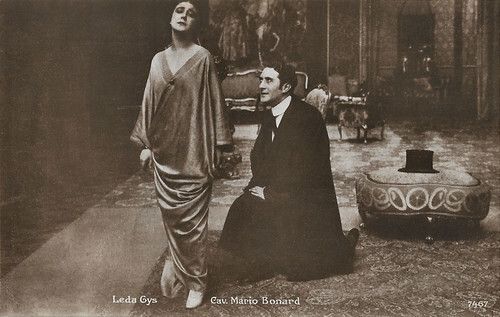
French postcard, no. 7467. Leda Gys and Mario Bonnard in La pantomima della morte/The Pantomime of Death (Mario Caserini, 1915), scripted by Amleto Palermi.
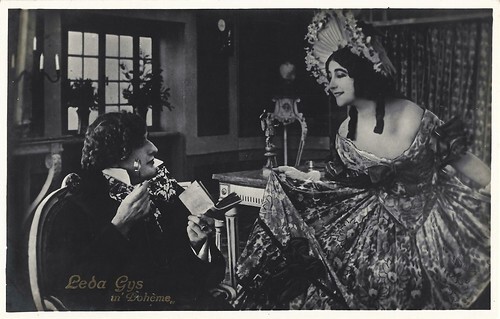
Italian postcard by G.B. Falci, Milano, no. 300. Photo: Leda Gys as Mimì in La Bohème (Amleto Palermi, 1917).
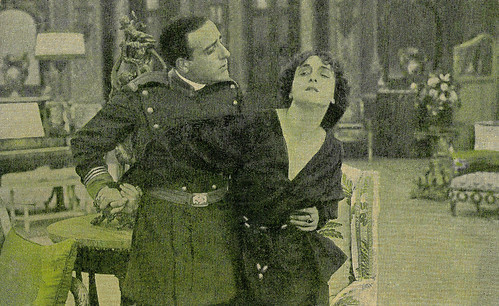
Spanish postcard by Amattler Marca Luna chocolate, series 7, no. 3. Photo: Lyda Borelli in Carnevalesca (Amleto Palermi, 1918).
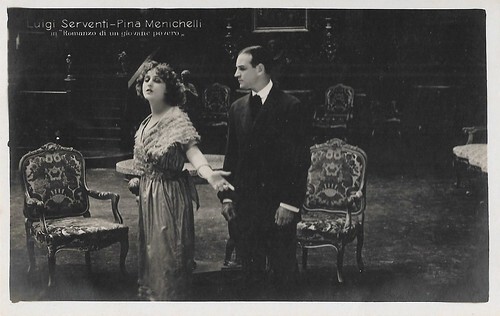
Italian postcard by Vettori, Bologna. Photo: Rinasciento Film. Pina Menichelli and Luigi Serventi in Il romanzo di un giovane povero/The Story of a Poor Young Man (Amleto Palermi, 1920), based on the novel 'Le Roman d'un jeune homme pauvre' (1858) by Octave Feuillet.
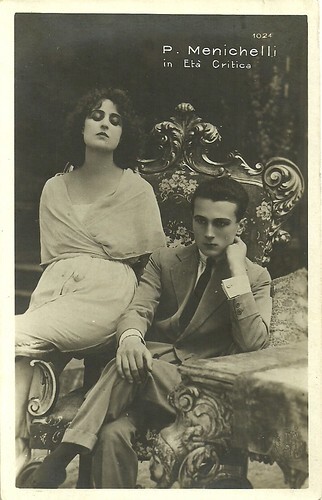
Italian postcard by Ed. Vettori, Bologna, no. 1024. Pina Menichelli and Giorgio Fini in L'età critica (Amleto Palermi, 1921). The film was based on the play by Max Dreyer, 'Die Siebzehnjährigen' (1904).
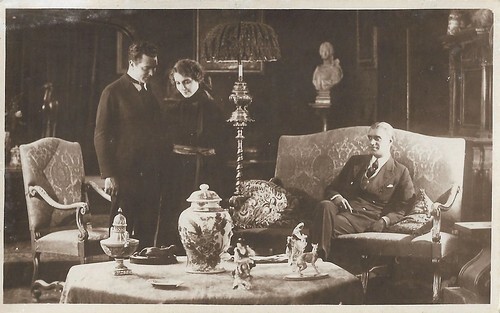
Italian postcard. Photo: Rinascimento Film. Livio Pavanelli , Orietta Claudi and Alfredo Bertone in La seconda moglie/The Second Wife (Amleto Palermi, 1922). Caption: Eliana amava il padre con affetto geloso (Eliana loved her father with jealous affection).
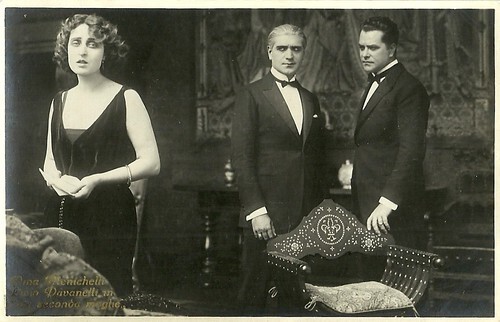
Italian postcard by Ed. G.B. Falci, Milano, no. 218. Pina Menichelli and Livio Pavanelli in La seconda moglie/The Second Wife (Amleto Palermi, 1922). The man in the middle is Alfredo Bertone. It is an adaptation of Arthur Wing Pinero's 1893 British play 'The Second Mrs Tanqueray', about a woman who struggles to overcome rumours about her past.
A confident, creative and skilful director
Amleto Palermi was born in Rome in 1891 and he grew up in Palermo. His father Raoul Vittorio Palermi was editor of the Giornale di Sicilia, and his mother Emilia Scarpelli was the sister of the Italian cartoonist, caricaturist, illustrator and journalist Filiberto Scarpelli. Amleto had two brothers, Manfredo and Italo. Barely twenty years old, Amleto wrote plays in Sicilian dialect such as 'U lupu', 'Amuri foddi' and 'Il tesoro d'isacco'.
In 1913, he moved to Rome, where he worked briefly as a journalist. The Turin-based production company Gloria Film then hired him. He worked on his first film, L'orrendo blasone (Amleto Palermi, 1914) with Mario Bonnard . For 'Film Artistica Gloria', he worked primarily as a director, but also as a scriptwriter for other directors.
Within a short space of time, he developed into an esteemed and distinguished filmmaker. He was sought-after by all the famous stars of the Italian silent cinema, including Mario Bonnard , Lyda Borelli , Livio Pavanelli , Pina Menichelli and Ruggero Ruggeri . Palermi was recognised for his confident acting, constant search for unusual solutions, creative use of narrative structures and (later) his skilful use of music and language, including dialect.
During the crisis in Italian cinema in 1926, he found work in Germany and Austria, where he directed a fair number of films. In 1929 he returned to Rome, with the advent of sound cinema. He directed around 35 more films until the beginning of the Second World War, initially some Italian-language versions of foreign productions, then - from around 1932 - works based on his own screenplays. He had great artistic freedom and was responsible for the editing of his films.
In 1941, Amleto Palermi died relatively young at the age of 51 of meningitis in Rome. He had three children with his wife Ida Molinaro, Fioretta Gioconda, Filippo (called Mimmo) and Francesco Saverio. Filippo (1917-1925) was a child actor in three films directed by his father: Paradiso (1923), La freccia nel cuore (1924), and La via del peccato (1924). He died of pneumonia in 1925, only 8 years old.
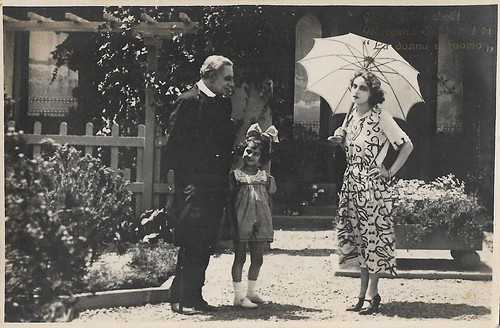
Italian postcard by G.B. Falci, Milano, no. 118. Photo: La Fotominio / Rinascimento Film / UCI. Pina Menichelli and Marcella Sabbatini in the drama La donna e l'uomo/The Woman and the Man (Amleto Palermi, 1923).
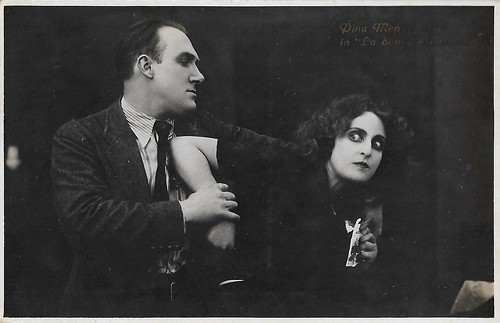
Italian postcard by G.B. Falci, Milano. Photo: La Fotominio / Rinascimento Film / UCI. Pina Menichelli and Milton Rosmer in La donna e l'uomo/The Woman and the Man (Amleto Palermi, 1923).

Italian postcard by G.B. Falci, Milano. Photo: Fotominio, no. 402. Pina Menichelli and Giovanni Grasso in Malafemmina, a title unknown to IMDb, but it is the alternative title of L'ospite sconosciuta/The Unknown Guest (Telemaco Ruggeri, 1923). Amleto Palermi wrote the script.
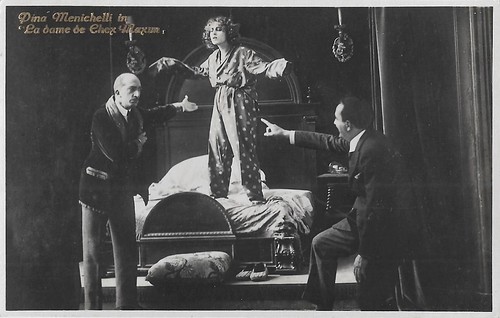
Italian postcard by G.B. Falci, Milano, no. 253. Pina Menichelli and Marcel Lévesque in La dama de Chez Maxim's (Amleto Palermi, 1923). Menichelli played the legendary Môme Crevette in one of the many film adaptations of Georges Feydeau's classic boulevard comedy 'La Dame de chez Maxim'(1899) .

Italian postcard by G.B. Falci, Milano. Pina Menichelli in La dama de Chez Maxim's (Amleto Palermi, 1923). Menichelli played the legendary Môme Crevette in one of the many film adaptations of Georges Feydeau's classic boulevard comedy. The man may be Alfredo Menichelli, Menichelli's younger brother, who plays the young duke.
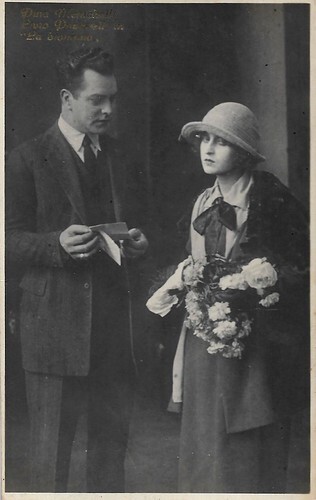
Italian postcard by G.B. Falci, Milano, no. 258. Pina Menichelli and Livio Pavanelli in one of Menichelli's last films La biondina/The Blonde (Amleto Palermi, 1923), based on a book by Marco Praga on the tragedy of a woman whose husband kills her in the end. It seems that Italian censorship forced the scriptwriter to add morality to the film, so Praga's tragedy is framed within a story about a modest, conventional wife who, encouraged by her friend, dreams of breaking out, but then reads Praga's book and decides to remain honest and loyal.
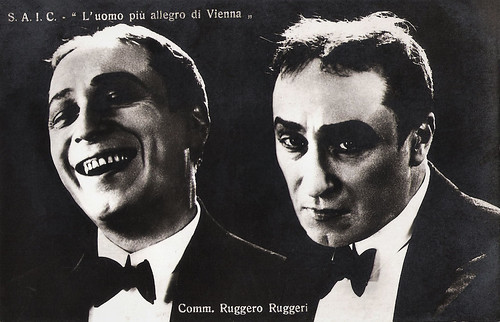
Italian postcard by Ed. A. Traldi, Milano. Photo: S.A.I.C. Ruggero Ruggeri in L'uomo più allegro di Vienna/The Most Cheerful Man in Vienna (Amleto Palermi, 1925).
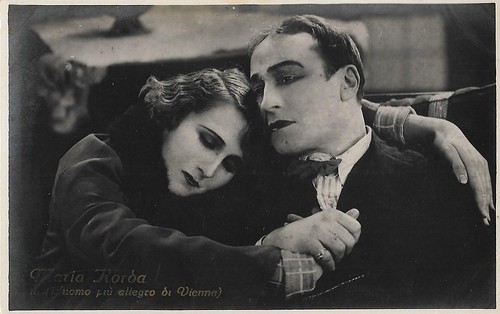
Italian postcard by G.B. Falci, Milano, no. 349. Photo: Palermi Films / La Fotominio. Maria Corda and Ruggero Ruggeri in L'uomo più allegro di Vienna/The Most Cheerful Man in Vienna (Amleto Palermi, 1925). The plot is quite moralistic but also modern: a young girl (Corda) is easily attracted to a fancy life by a gigolo (Varconi) but her father (Ruggeri), a happy-go-lucky leader of a jazz band, energetically manages to subtract her from dangers, even if all the relatives think he is a good-for-nothing.
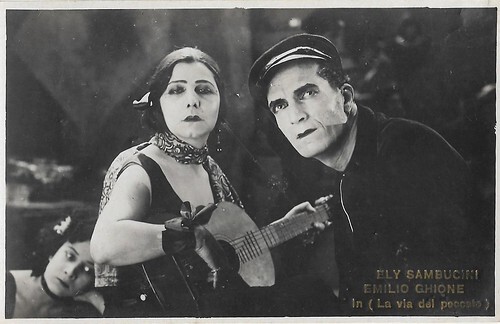
Italian postcard by G.B. Falci, Milano, no. 364. Photo: A.P. Film / La Fotominio. Emilio Ghione and Kally Sambucini in La via del peccato/The Way of Sin (Amleto Palermi, 1925). Sambucini's first name is misspelt on the card.
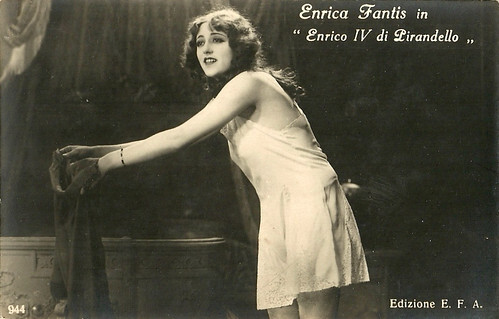
Italian postcard by Ed. A. Traldi, Milano / Edizione E.F.A., no. 944. Enrica Fantis in Die Flucht in die Nacht/Enrico IV/The Flight in the Night (Amleto Palermi, 1926), based on Luigi Pirandello's play 'Enrico IV' The film starred Conrad Veidt, and was shot on location in Tuscany in Italy.
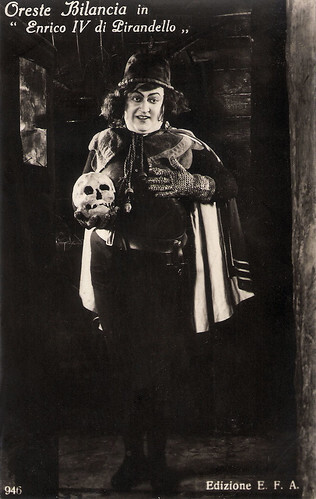
Italian postcard by Edizione A. Traldi, Milano, no. 946. Oreste Bilancia in Die Flucht in die Nacht/The Flight in the Night (Amleto Palermi, 1926), based on the play 'Enrico IV' by Luigi Pirandello.
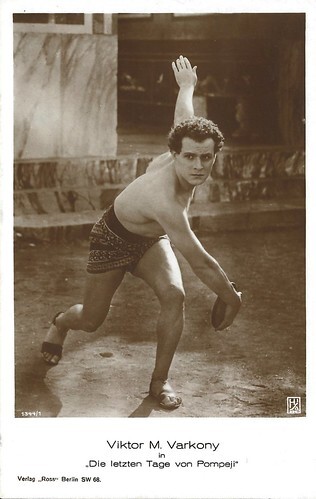
German postcard by Ross Verlag, no. 1344/1, 1927-28. Photo: Hisa Film-Vertrieb. Victor Varconi (aka Viktor Varkony and Michail Varkonyi) as Glaucus in Gli ultimi giorni di Pompei/The Last Days of Pompeii (Carmine Gallone, Amleto Palermi, 1926), released in Germany as Die letzten Tage von Pompeji. The film was one of the many adaptations of the novel 'The Last Days of Pompeii' (1834) by Edward George Bulwer-Lytton. Sets were by Vittorio Cafiero, costumes by Duilio Cambellotti.
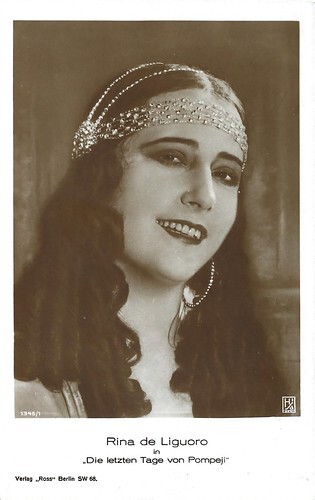
German postcard by Verlag Ross, Berlin, no. 1345/1, 1927-1928. Rina de Liguoro as Ione in Gli ultimi giorni di Pompei/The Last Days of Pompeii (Carmine Gallone, Amleto Palermi, 1926), released in Germany as Die letzten Tage von Pompeji.
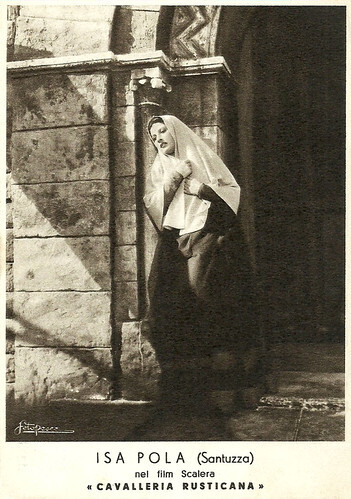
Italian postcard. Photo: Pesce / Scalera Film. Isa Pola as Santuzza in Cavalleria rusticana (Amleto Palermi, 1939). Pola and Leonardo Cortese had the leads as Santuzza and Turiddu in this drama based on the work of Giovanni Verga, which later was turned into an opera by Pietro Mascagni.
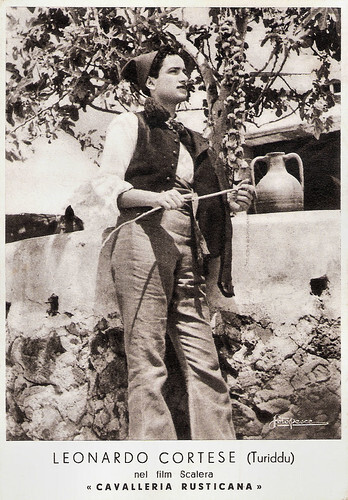
Italian postcard by Zimncografica, Firenze. Sent by mail in 1939. Photo: Scalera / Pesce. Leonardo Cortese in Cavalleria rusticana (Amleto Palermi, 1939).
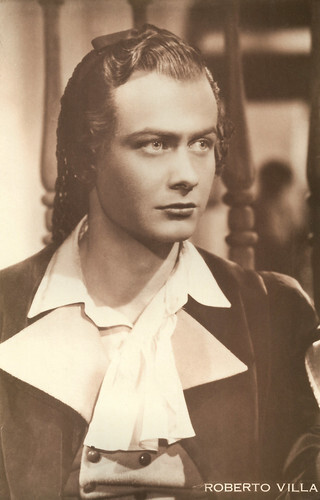
Romanian or Italian postcard. Roberto Villa as Nemorino in L'Elisir d'amore/The Elixir of Love (Amleto Palermi, 1941).
Sources: Wikipedia (Italian, German and English) and .

French postcard, no. 7467. Leda Gys and Mario Bonnard in La pantomima della morte/The Pantomime of Death (Mario Caserini, 1915), scripted by Amleto Palermi.

Italian postcard by G.B. Falci, Milano, no. 300. Photo: Leda Gys as Mimì in La Bohème (Amleto Palermi, 1917).

Spanish postcard by Amattler Marca Luna chocolate, series 7, no. 3. Photo: Lyda Borelli in Carnevalesca (Amleto Palermi, 1918).

Italian postcard by Vettori, Bologna. Photo: Rinasciento Film. Pina Menichelli and Luigi Serventi in Il romanzo di un giovane povero/The Story of a Poor Young Man (Amleto Palermi, 1920), based on the novel 'Le Roman d'un jeune homme pauvre' (1858) by Octave Feuillet.

Italian postcard by Ed. Vettori, Bologna, no. 1024. Pina Menichelli and Giorgio Fini in L'età critica (Amleto Palermi, 1921). The film was based on the play by Max Dreyer, 'Die Siebzehnjährigen' (1904).

Italian postcard. Photo: Rinascimento Film. Livio Pavanelli , Orietta Claudi and Alfredo Bertone in La seconda moglie/The Second Wife (Amleto Palermi, 1922). Caption: Eliana amava il padre con affetto geloso (Eliana loved her father with jealous affection).

Italian postcard by Ed. G.B. Falci, Milano, no. 218. Pina Menichelli and Livio Pavanelli in La seconda moglie/The Second Wife (Amleto Palermi, 1922). The man in the middle is Alfredo Bertone. It is an adaptation of Arthur Wing Pinero's 1893 British play 'The Second Mrs Tanqueray', about a woman who struggles to overcome rumours about her past.
A confident, creative and skilful director
Amleto Palermi was born in Rome in 1891 and he grew up in Palermo. His father Raoul Vittorio Palermi was editor of the Giornale di Sicilia, and his mother Emilia Scarpelli was the sister of the Italian cartoonist, caricaturist, illustrator and journalist Filiberto Scarpelli. Amleto had two brothers, Manfredo and Italo. Barely twenty years old, Amleto wrote plays in Sicilian dialect such as 'U lupu', 'Amuri foddi' and 'Il tesoro d'isacco'.
In 1913, he moved to Rome, where he worked briefly as a journalist. The Turin-based production company Gloria Film then hired him. He worked on his first film, L'orrendo blasone (Amleto Palermi, 1914) with Mario Bonnard . For 'Film Artistica Gloria', he worked primarily as a director, but also as a scriptwriter for other directors.
Within a short space of time, he developed into an esteemed and distinguished filmmaker. He was sought-after by all the famous stars of the Italian silent cinema, including Mario Bonnard , Lyda Borelli , Livio Pavanelli , Pina Menichelli and Ruggero Ruggeri . Palermi was recognised for his confident acting, constant search for unusual solutions, creative use of narrative structures and (later) his skilful use of music and language, including dialect.
During the crisis in Italian cinema in 1926, he found work in Germany and Austria, where he directed a fair number of films. In 1929 he returned to Rome, with the advent of sound cinema. He directed around 35 more films until the beginning of the Second World War, initially some Italian-language versions of foreign productions, then - from around 1932 - works based on his own screenplays. He had great artistic freedom and was responsible for the editing of his films.
In 1941, Amleto Palermi died relatively young at the age of 51 of meningitis in Rome. He had three children with his wife Ida Molinaro, Fioretta Gioconda, Filippo (called Mimmo) and Francesco Saverio. Filippo (1917-1925) was a child actor in three films directed by his father: Paradiso (1923), La freccia nel cuore (1924), and La via del peccato (1924). He died of pneumonia in 1925, only 8 years old.

Italian postcard by G.B. Falci, Milano, no. 118. Photo: La Fotominio / Rinascimento Film / UCI. Pina Menichelli and Marcella Sabbatini in the drama La donna e l'uomo/The Woman and the Man (Amleto Palermi, 1923).

Italian postcard by G.B. Falci, Milano. Photo: La Fotominio / Rinascimento Film / UCI. Pina Menichelli and Milton Rosmer in La donna e l'uomo/The Woman and the Man (Amleto Palermi, 1923).

Italian postcard by G.B. Falci, Milano. Photo: Fotominio, no. 402. Pina Menichelli and Giovanni Grasso in Malafemmina, a title unknown to IMDb, but it is the alternative title of L'ospite sconosciuta/The Unknown Guest (Telemaco Ruggeri, 1923). Amleto Palermi wrote the script.

Italian postcard by G.B. Falci, Milano, no. 253. Pina Menichelli and Marcel Lévesque in La dama de Chez Maxim's (Amleto Palermi, 1923). Menichelli played the legendary Môme Crevette in one of the many film adaptations of Georges Feydeau's classic boulevard comedy 'La Dame de chez Maxim'(1899) .

Italian postcard by G.B. Falci, Milano. Pina Menichelli in La dama de Chez Maxim's (Amleto Palermi, 1923). Menichelli played the legendary Môme Crevette in one of the many film adaptations of Georges Feydeau's classic boulevard comedy. The man may be Alfredo Menichelli, Menichelli's younger brother, who plays the young duke.

Italian postcard by G.B. Falci, Milano, no. 258. Pina Menichelli and Livio Pavanelli in one of Menichelli's last films La biondina/The Blonde (Amleto Palermi, 1923), based on a book by Marco Praga on the tragedy of a woman whose husband kills her in the end. It seems that Italian censorship forced the scriptwriter to add morality to the film, so Praga's tragedy is framed within a story about a modest, conventional wife who, encouraged by her friend, dreams of breaking out, but then reads Praga's book and decides to remain honest and loyal.

Italian postcard by Ed. A. Traldi, Milano. Photo: S.A.I.C. Ruggero Ruggeri in L'uomo più allegro di Vienna/The Most Cheerful Man in Vienna (Amleto Palermi, 1925).

Italian postcard by G.B. Falci, Milano, no. 349. Photo: Palermi Films / La Fotominio. Maria Corda and Ruggero Ruggeri in L'uomo più allegro di Vienna/The Most Cheerful Man in Vienna (Amleto Palermi, 1925). The plot is quite moralistic but also modern: a young girl (Corda) is easily attracted to a fancy life by a gigolo (Varconi) but her father (Ruggeri), a happy-go-lucky leader of a jazz band, energetically manages to subtract her from dangers, even if all the relatives think he is a good-for-nothing.

Italian postcard by G.B. Falci, Milano, no. 364. Photo: A.P. Film / La Fotominio. Emilio Ghione and Kally Sambucini in La via del peccato/The Way of Sin (Amleto Palermi, 1925). Sambucini's first name is misspelt on the card.

Italian postcard by Ed. A. Traldi, Milano / Edizione E.F.A., no. 944. Enrica Fantis in Die Flucht in die Nacht/Enrico IV/The Flight in the Night (Amleto Palermi, 1926), based on Luigi Pirandello's play 'Enrico IV' The film starred Conrad Veidt, and was shot on location in Tuscany in Italy.

Italian postcard by Edizione A. Traldi, Milano, no. 946. Oreste Bilancia in Die Flucht in die Nacht/The Flight in the Night (Amleto Palermi, 1926), based on the play 'Enrico IV' by Luigi Pirandello.

German postcard by Ross Verlag, no. 1344/1, 1927-28. Photo: Hisa Film-Vertrieb. Victor Varconi (aka Viktor Varkony and Michail Varkonyi) as Glaucus in Gli ultimi giorni di Pompei/The Last Days of Pompeii (Carmine Gallone, Amleto Palermi, 1926), released in Germany as Die letzten Tage von Pompeji. The film was one of the many adaptations of the novel 'The Last Days of Pompeii' (1834) by Edward George Bulwer-Lytton. Sets were by Vittorio Cafiero, costumes by Duilio Cambellotti.

German postcard by Verlag Ross, Berlin, no. 1345/1, 1927-1928. Rina de Liguoro as Ione in Gli ultimi giorni di Pompei/The Last Days of Pompeii (Carmine Gallone, Amleto Palermi, 1926), released in Germany as Die letzten Tage von Pompeji.

Italian postcard. Photo: Pesce / Scalera Film. Isa Pola as Santuzza in Cavalleria rusticana (Amleto Palermi, 1939). Pola and Leonardo Cortese had the leads as Santuzza and Turiddu in this drama based on the work of Giovanni Verga, which later was turned into an opera by Pietro Mascagni.

Italian postcard by Zimncografica, Firenze. Sent by mail in 1939. Photo: Scalera / Pesce. Leonardo Cortese in Cavalleria rusticana (Amleto Palermi, 1939).

Romanian or Italian postcard. Roberto Villa as Nemorino in L'Elisir d'amore/The Elixir of Love (Amleto Palermi, 1941).
Sources: Wikipedia (Italian, German and English) and .
Published on November 20, 2024 22:00
November 19, 2024
Ross Verlag, Part 11: Foreign in the UK
Ross Verlag published a series of postcards for Great Britain without the Ross Verlag name on the cards. Instead, the cards had the word 'Foreign' in one corner of the photo on the card. These were all hand-tinted colour postcards with a gloss finish. Although the Ross Verlag number was still visible on the front of these cards, they also usually had another number on the back in the stamp box. Besides these cards for the British market, Ross Verlag also published several hand-coloured postcards for the continental market. Here are 25 Ross Verlag Foreign postcards.
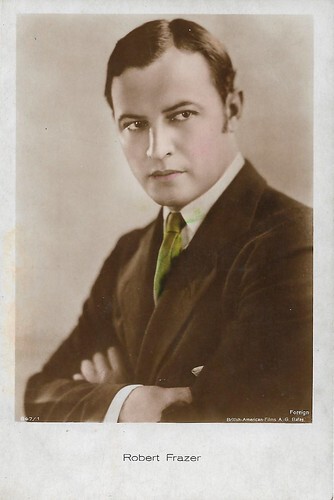
British postcard by Ross Verlag Foreign, no. 847/1. Photo: British-American Films AG (Bafag). Robert Frazer.
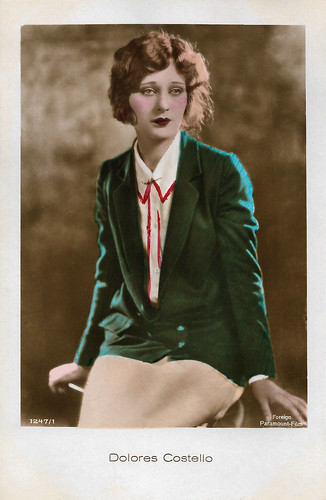
British postcard by Ross Verlag Foreign, no. 1247/1. Photo: Paramount-Film. Dolores Costello .
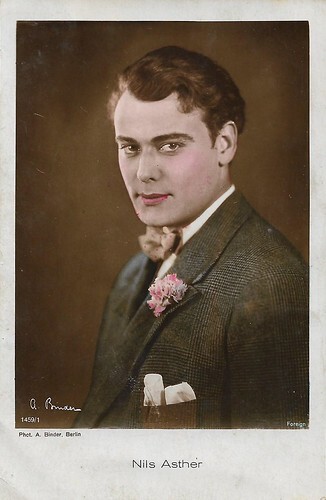
British postcard by Ross Verlag Foreign, no. 1459/1. Photo: Alex Binder, Berlin. Nils Asther .
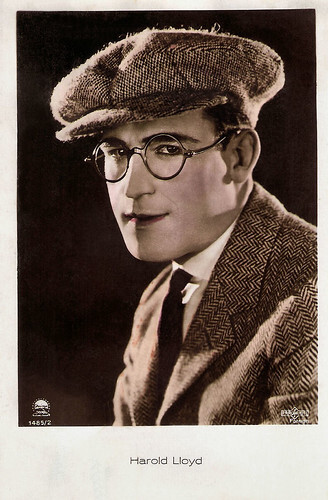
British postcard by Ross Verlag Foreign, no. 1485/2. Photo: Paramount / Parufamet. Harold Lloyd .
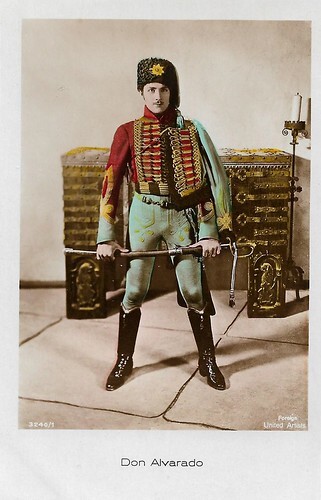
British postcard by Ross Verlag Foreign, no. 3240/1. Photo: United Artists. Don Alvarado in Drums of Love (D.W. Griffith, 1928).
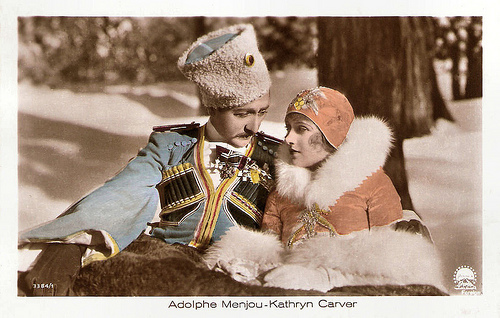
British postcard by Ross Verlag Foreign, no. 3384/1. Photo: Paramount. Adolphe Menjou and Kathryn Carver in Service for Ladies (Harry d'Abbadie d'Arrast, 1927).
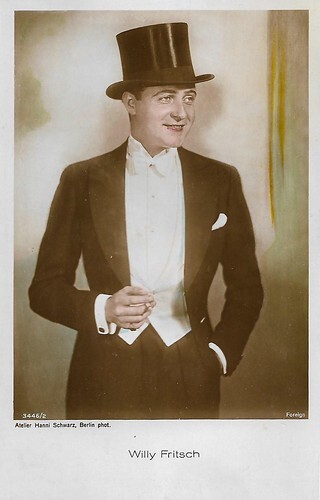
British postcard by Ross Verlag Foreign, no. 3446/2, 1928-1929. Photo: Atelier Hanni Schwarz, Berlin. Willy Fritsch .
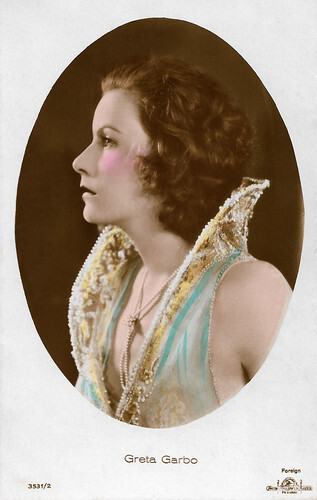
British postcard by Ross Verlag, no. 3531/2, 1928-1929. Photo: MGM. Greta Garbo in Love (Edmund Goulding, 1927).
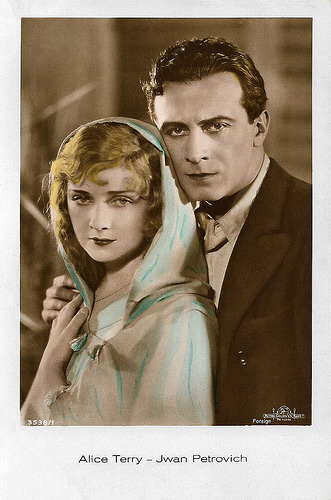
British postcard by Ross Verlag, no. 3538/1. Photo: Metro-Goldwyn-Mayer. Alice Terry and Iván Petrovich in The Garden of Allah (Rex Ingram, 1927).

British postcard by Ross Verlag Foreign, no. 3576/1. Photo: Fox. Tom Mix .
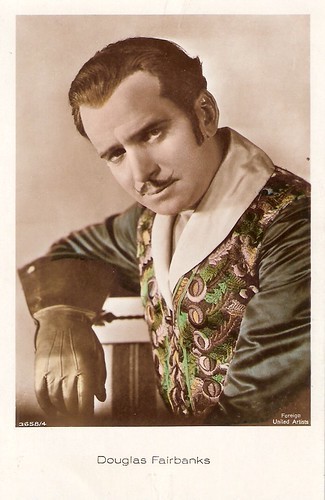
British postcard by Ross Verlag Foreign, no. 3658/4, 1928-1929. Photo: United Artists. Douglas Fairbanks is wearing the outfit from Don Q, Son of Zorro (Donald Crisp, 1925).
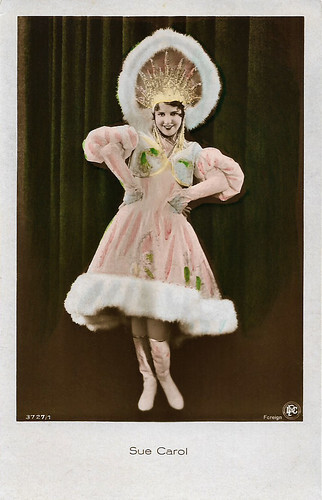
British postcard by Ross Verlag Foreign, no. 3727/1, 1928-1929. Photo: PDC. Sue Carol .
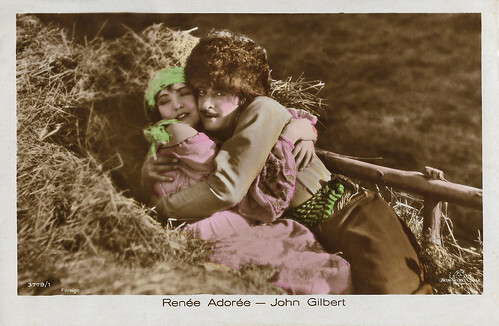
British postcard by Ross Verlag Foreign, no. 3779/1. Photo: Metro-Goldwyn-Mayer. John Gilbert and Renée Adorée in the American silent drama The Cossacks (George Hill, Clarence Brown, 1928), their fifth film together.
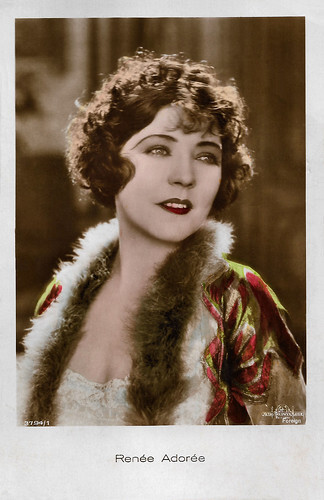
British postcard by Ross Verlag Foreign, no. 3794/1, 1928-1929. Photo: Metro-Goldwyn-Mayer. Collection: Marlene Pilaete. Renée Adorée .
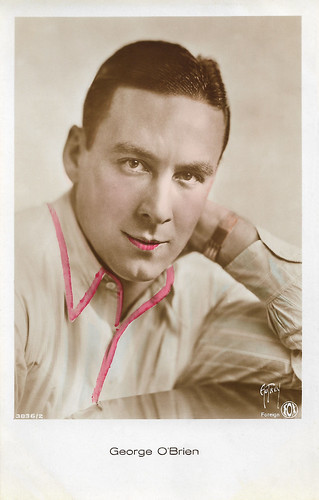
British postcard by Ross Verlag Foreign, no. 3836/2, 1928-1929. Photo: Max Munn Autrey / Fox. George O'Brien .
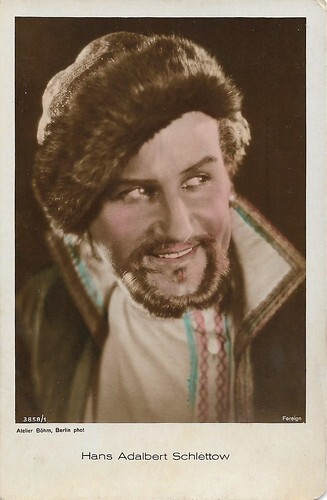
British postcard by Ross Verlag Foreign, no. 3858/1. Photo: Atelier Böhm, Berlin. Hans Adalbert Schlettow in Wolga Wolga/Volga Volga (Viktor Tourjansky, 1928).
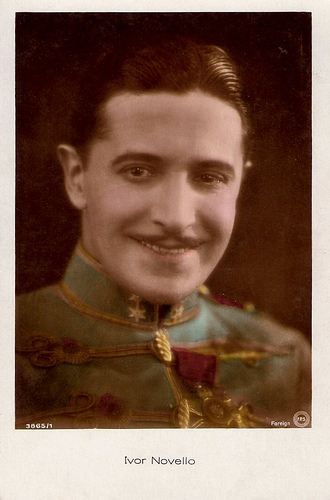
British postcard, no. 3865/1. Photo: FPS. At the backside: Real Hand-coloured Photograph. Ivor Novello .
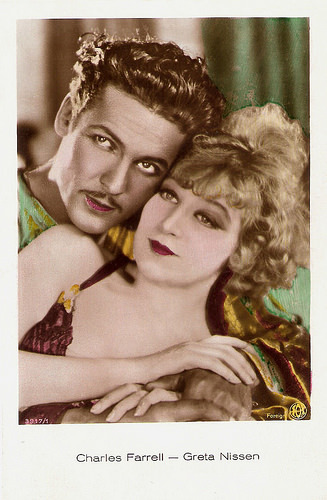
British postcard by Ross Verlag, no. 3917/1, 1928-1929. Photo: Fox. Greta Nissen and Charles Farrell in Fazil (Howard Hawks, 1928).
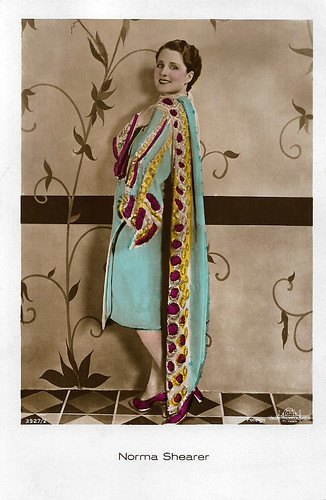
British postcard by Ross Verlag Foreign, no. 3927/2. Photo: Metro-Goldwyn-Mayer. Norma Shearer .
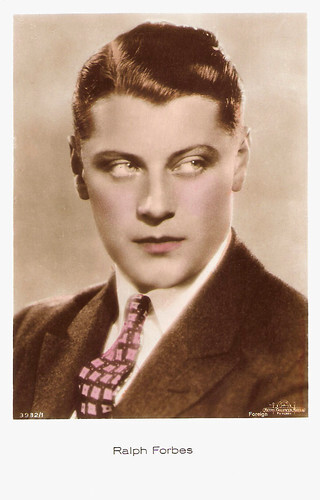
British postcard by Ross Verlag Foreign, no. 3932/1. Photo: Metro-Goldwyn-Mayer. Ralph Forbes .
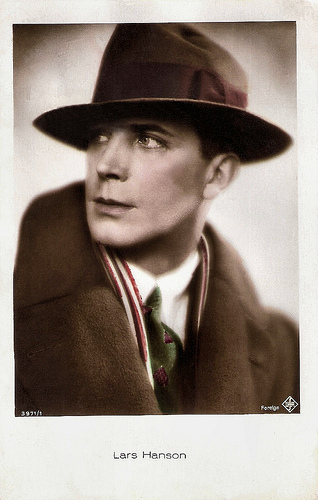
British postcard by Ross Verlag Foreign, no. 3971/1. Photo: Ufa. Lars Hanson .
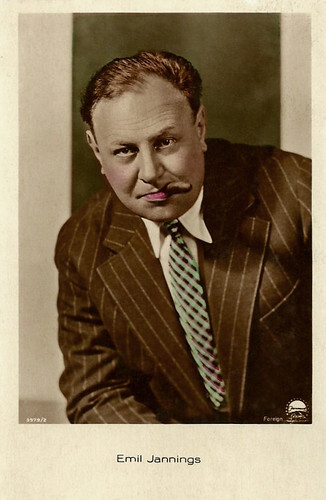
British postcard by Ross Verlag Foreign, no. 3979/2. Photo: Paramount.The photo must be dating from the years that Emil Jannings was a star in silent Hollywood films (1927-1928).
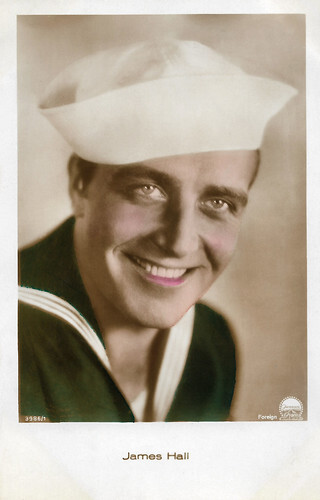
British postcard by Ross Verlag Foreign, no. 3986/1, 1928-1929. Photo: Paramount. James Hall in The Fleet’s In (Malcolm St. Clair, 1928).
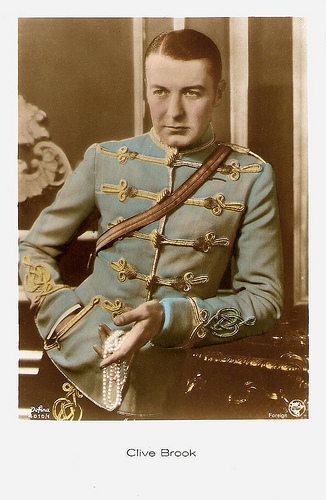
British postcard by Ross Verlag, no. 4010/1. Photo: Defina / First National Pictures. Clive Brook .
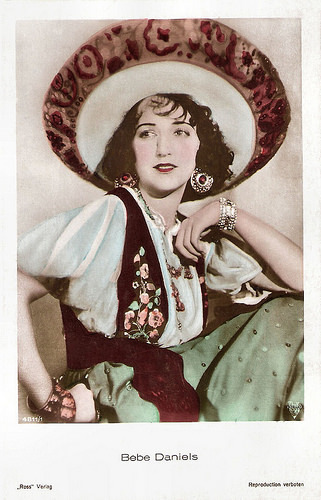
British postcard by Ross Verlag, no. 4811/1, 1929-1930. Photo: RKO Radio Pictures. Collection: Geoffrey Donaldson Institute. Bebe Daniels .
Source: Mark Goffee (Ross Verlag Movie Star Postcards).Special thanks to Jean Ritsema and Ivo Blom.
With thanks to Jean Ritsema and Ivo Blom! Our Ross Verlag Tribute will be continued next week and please, remember to check out the Ross Verlag Movie Stars Postcards website.

British postcard by Ross Verlag Foreign, no. 847/1. Photo: British-American Films AG (Bafag). Robert Frazer.

British postcard by Ross Verlag Foreign, no. 1247/1. Photo: Paramount-Film. Dolores Costello .

British postcard by Ross Verlag Foreign, no. 1459/1. Photo: Alex Binder, Berlin. Nils Asther .

British postcard by Ross Verlag Foreign, no. 1485/2. Photo: Paramount / Parufamet. Harold Lloyd .

British postcard by Ross Verlag Foreign, no. 3240/1. Photo: United Artists. Don Alvarado in Drums of Love (D.W. Griffith, 1928).

British postcard by Ross Verlag Foreign, no. 3384/1. Photo: Paramount. Adolphe Menjou and Kathryn Carver in Service for Ladies (Harry d'Abbadie d'Arrast, 1927).

British postcard by Ross Verlag Foreign, no. 3446/2, 1928-1929. Photo: Atelier Hanni Schwarz, Berlin. Willy Fritsch .

British postcard by Ross Verlag, no. 3531/2, 1928-1929. Photo: MGM. Greta Garbo in Love (Edmund Goulding, 1927).

British postcard by Ross Verlag, no. 3538/1. Photo: Metro-Goldwyn-Mayer. Alice Terry and Iván Petrovich in The Garden of Allah (Rex Ingram, 1927).

British postcard by Ross Verlag Foreign, no. 3576/1. Photo: Fox. Tom Mix .

British postcard by Ross Verlag Foreign, no. 3658/4, 1928-1929. Photo: United Artists. Douglas Fairbanks is wearing the outfit from Don Q, Son of Zorro (Donald Crisp, 1925).

British postcard by Ross Verlag Foreign, no. 3727/1, 1928-1929. Photo: PDC. Sue Carol .

British postcard by Ross Verlag Foreign, no. 3779/1. Photo: Metro-Goldwyn-Mayer. John Gilbert and Renée Adorée in the American silent drama The Cossacks (George Hill, Clarence Brown, 1928), their fifth film together.

British postcard by Ross Verlag Foreign, no. 3794/1, 1928-1929. Photo: Metro-Goldwyn-Mayer. Collection: Marlene Pilaete. Renée Adorée .

British postcard by Ross Verlag Foreign, no. 3836/2, 1928-1929. Photo: Max Munn Autrey / Fox. George O'Brien .

British postcard by Ross Verlag Foreign, no. 3858/1. Photo: Atelier Böhm, Berlin. Hans Adalbert Schlettow in Wolga Wolga/Volga Volga (Viktor Tourjansky, 1928).

British postcard, no. 3865/1. Photo: FPS. At the backside: Real Hand-coloured Photograph. Ivor Novello .

British postcard by Ross Verlag, no. 3917/1, 1928-1929. Photo: Fox. Greta Nissen and Charles Farrell in Fazil (Howard Hawks, 1928).

British postcard by Ross Verlag Foreign, no. 3927/2. Photo: Metro-Goldwyn-Mayer. Norma Shearer .

British postcard by Ross Verlag Foreign, no. 3932/1. Photo: Metro-Goldwyn-Mayer. Ralph Forbes .

British postcard by Ross Verlag Foreign, no. 3971/1. Photo: Ufa. Lars Hanson .

British postcard by Ross Verlag Foreign, no. 3979/2. Photo: Paramount.The photo must be dating from the years that Emil Jannings was a star in silent Hollywood films (1927-1928).

British postcard by Ross Verlag Foreign, no. 3986/1, 1928-1929. Photo: Paramount. James Hall in The Fleet’s In (Malcolm St. Clair, 1928).

British postcard by Ross Verlag, no. 4010/1. Photo: Defina / First National Pictures. Clive Brook .

British postcard by Ross Verlag, no. 4811/1, 1929-1930. Photo: RKO Radio Pictures. Collection: Geoffrey Donaldson Institute. Bebe Daniels .
Source: Mark Goffee (Ross Verlag Movie Star Postcards).Special thanks to Jean Ritsema and Ivo Blom.
With thanks to Jean Ritsema and Ivo Blom! Our Ross Verlag Tribute will be continued next week and please, remember to check out the Ross Verlag Movie Stars Postcards website.
Published on November 19, 2024 22:00
November 18, 2024
Senta Berger
Beautiful Austrian actress Senta Berger (1941) received many awards for her work in theatre, film and television, including a Golden Globe Award and a Goldene Kamera. She played in several European co-productions and appeared as a sex bomb in some Hollywood movies of the 1960s. Berger also worked as a producer of internationally acclaimed films directed by her husband, Michael Verhoeven, and she is a bestselling author.
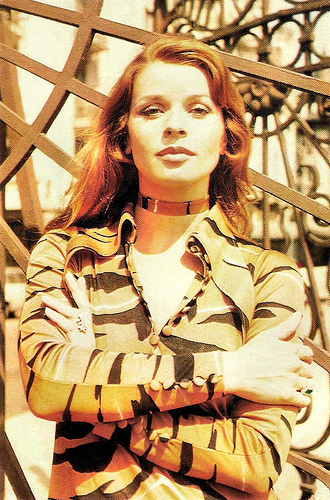
Romanian postcard by Casa Filmului Acin.
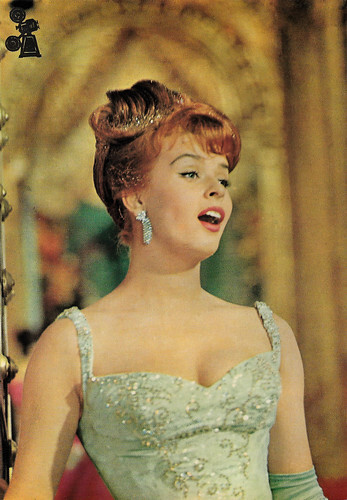
Spanish postcard by Toro de Bronce. Senta Berger in The Waltz King (Steve Previn, 1963).
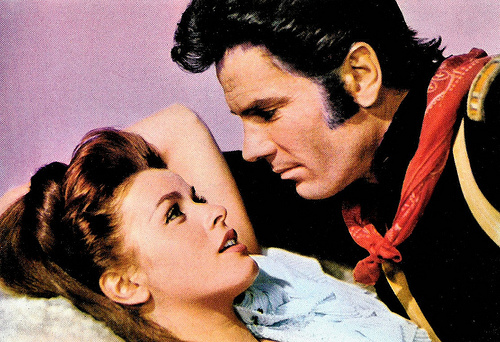
Italian postcard. Photo: Dear Film. Publicity still for The Glory Guys (Arnold Laven, 1965) with Tom Tryon.
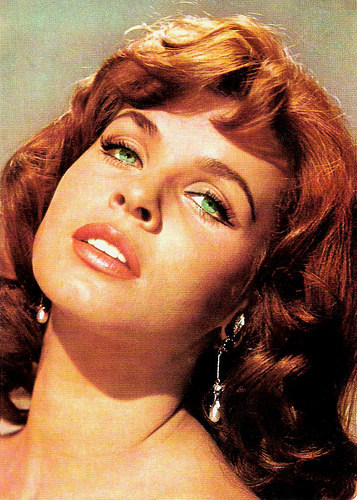
Romanian postcard by Casa Filmului Acin.
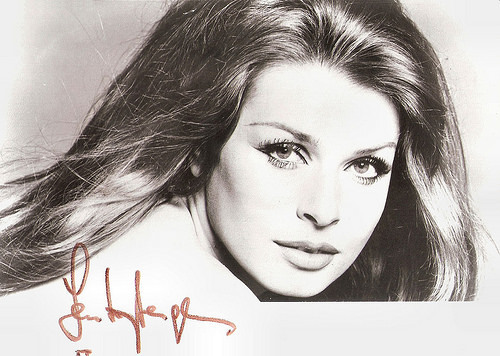
Autograph card.
Not just another European sex bomb
Senta Berger was born in Vienna, Austria in 1941 as the daughter of Therese Jany, a teacher, and Josef Berger, a musician. She first appeared on stage at age four, where her father accompanied his daughter's singing on the piano. At age five, she started ballet lessons, but Senta was asked to leave at 14 because she had ‘developed’ too much.
She then took private acting lessons and appeared as an extra in the comedy Du bist die Richtige/You Are The Right One (Erich Engel, Josef von Báky, 1955) starring Curd Jürgens . In 1957, she won her first small role in Die unentschuldigte Stunde/The Unexcused Hour (1957), one of the last films directed by legendary actor-director Willi Forst . She applied for the Max Reinhardt Seminar, a famous acting school in Vienna. Still, she was expelled shortly afterwards after accepting a small role in the film The Journey/Die Reise (Anatole Litvak, 1959) without permission. Only 17, she became the youngest member of the Theater in der Josefstadt in Vienna in 1958 and played a role in Luigi Pirandello’s Enrico IV.
Film producer Arthur Brauner offered her a role opposite German superstar Heinz Rühmann in the deft satire Der brave Soldat Schweijk/The Good Soldier Schweijk (Axel von Ambesser, 1960). Brauner signed a contract with her for several films and cast her in Schlagerfilms like O sole mio (Paul Martin, 1960) and Adieu, Lebewohl, Goodbye (1961). She soon got tired of them, but Maria Brauner, the producer’s wife, helped her to get a part next to O.W. Fischer and Eva Bartok in the thrillers Es muß nicht immer Kaviar sein/Operation Caviar (Geza von Radvanyi, 1961) and Diesmal muß es Kaviar sein/This time it has to be caviar (Geza von Radvanyi, 1961). These spy thrillers, based on the novels by Johannes Mario Simmel, meant her breakthrough.
Berger became a staple in European co-productions like Sherlock Holmes und das Halsband des Todes/Sherlock Holmes and the Deadly Necklace (Terence Fisher, Frank Winterstein, 1962) starring Christopher Lee , and Kali-Yug, la Dea della Vendetta/Vengeance of Kali (Mario Camerini, 1963) with Lex Barker .
On the invitation of Richard Widmark , with whom she had appeared in the Cold War adventure film The Secret Ways (Phil Karlson, 1961), she went to Hollywood. There she appeared in the anti-war drama The Victors (Carl Foreman, 1963) and in The Waltz King (Steve Previn, 1963), a two-parter in the TV series Walt Disney's Wonderful World of Color. Though an actress of more than average talent, Berger was regarded as just another European sex bomb by most Hollywood publicity flacks. She was offered a five-year contract by a major Hollywood studio, but she decided to return to Germany.
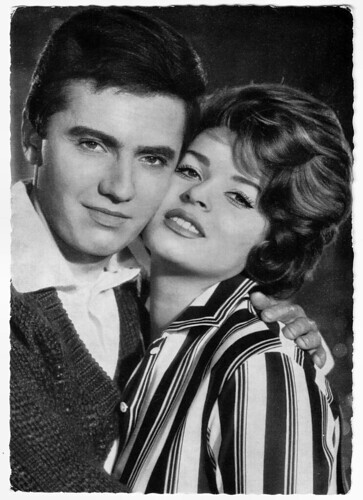
West German postcard by Filmbilder-Vertrieb Ernst Freihoff, Essen, no. 680. Photo: Alfa / Gloria / Grimm. Senta Berger and Rex Gildo in O sole mio (Paul Martin, 1960).
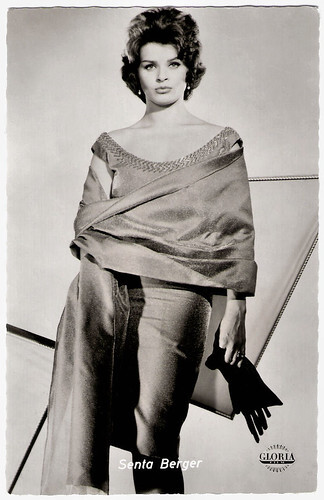
German postcard by Kolibri-Verlag, Minden/Westf., no. 1813. Photo: A. Grimm / Gloria Film. Publicity still for Frauenarzt Dr. Sibelius/Dr. Sibelius (Rudolf Jugert, 1962).
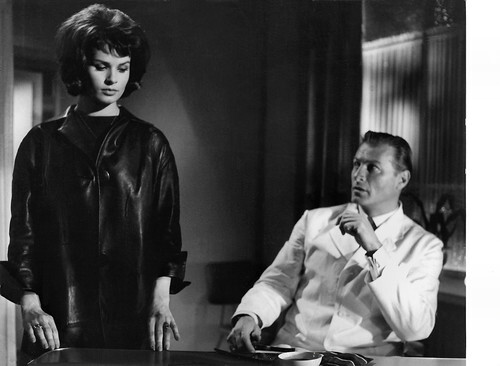
Vintage press photo. Senta Berger and Lex Barker in Frauenarzt Dr. Sibelius/Dr. Sibelius (Rudolf Jugert, 1962).
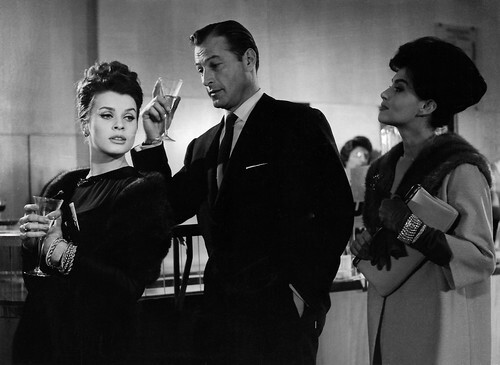
Vintage press photo. Senta Berger, Lex Barker and Barbara Rütting in Frauenarzt Dr. Sibelius/Dr. Sibelius (Rudolf Jugert, 1962).
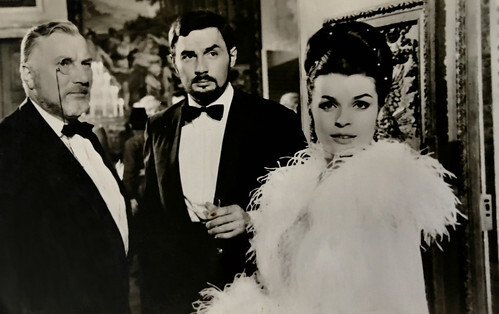
Romanian postcard by Casa Filmului Acin. Senta Berger, Martin Held and Walter Wilz in Lange Beine - lange Finger/Long Legs, Long Fingers (Alfred Vohrer, 1966). Collection: Alina Deaconu.
Rousing entertainment
During the shooting of the comedy Jacky und Jenny/Jacky and Jenny (Victor Vicas, 1964), Senta Berger met Michael Verhoeven, son of the German film director Paul Verhoeven (not the Dutch Paul Verhoeven ). They started their own film production company Sentana-Filmproduktion in 1965 and married the following year.
Berger continued to develop her international career and played with such stars as Dean Martin , Frank Sinatra , John Wayne , and Yul Brynner . She appeared in numerous Euro-spy films such as the Italian crime comedy Operazione San Gennaro/Operation San Gennaro (Dino Risi, 1966), the British comedy Our Man in Marrakech (Don Sharp, 1966) with Tony Randall, and the French thriller Peau d’Espion/To Commit a Murder (Edouard Molinaro, 1967) with Louis Jourdan .
One of her best-known Hollywood movies is the Western Major Dundee (Sam Peckinpah, 1965) with Charlton Heston . At the Celluloid Heroes blog, Paul McElligott writes: “Major Dundee is one of Sam Peckinpah’s early works, a highly stylized Western that fits perfectly the outsized performances of its stars, Charlton Heston and Richard Harris. Neither the story, the dialogue or the acting can be called realistic, but it is what it claims to be, a rousing entertainment.”
In Cast a Giant Shadow (Melville Shavelson, 1966) with Kirk Douglas , she played the role of Magda, a soldier in the Israeli army during the Israeli War of Independence in 1948. That same year she was also a German schoolteacher involved in neo-Nazi activity opposite Max von Sydow and George Segal in the spy film The Quiller Memorandum (Michael Anderson, 1966).
A curiosity is the short film Vienna (1967) directed by Orson Welles . In the film Welles is wandering through Vienna, remembering The Third Man and then, aided by Berger and Mickey Rooney , he suddenly stumbles into a spy satire which is, according to the IMDb reviewer, “simply hilariously funny”. In 1967, Berger acted also in the pilot for the American television TV series It Takes a Thief (1968) starring Robert Wagner . She reprised her role in the series in 1969, in an episode in which her character was killed off.
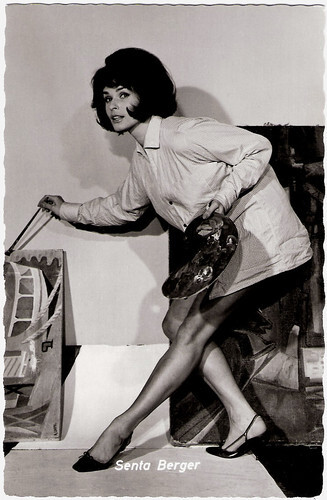
German postcard by Friedrich-W. Sander-Verlag, Minden/Westf. (Kolibri Foto-karte), no. 2347.
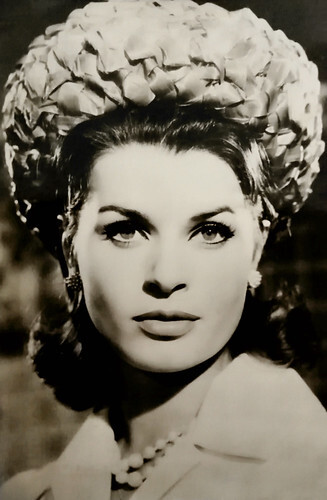
Romanian postcard by Casa Filmului Acin, no. 449. Senta Berger in Das Testament des Dr. Mabuse/The Testament of Dr. Mabuse (Werner Klingler, 1962). Collection: Alina Deaconu.
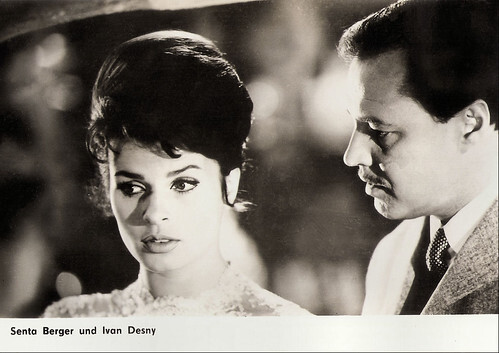
East German postcard by VEB Progress Filmvertrieb, Berlin, no. 3012, 1967 Photo: Senta Berger and Ivan Desny in Sherlock Holmes und das Halsband des Todes/Sherlock Holmes and the Deadly Necklace (Terence Fisher, 1962).
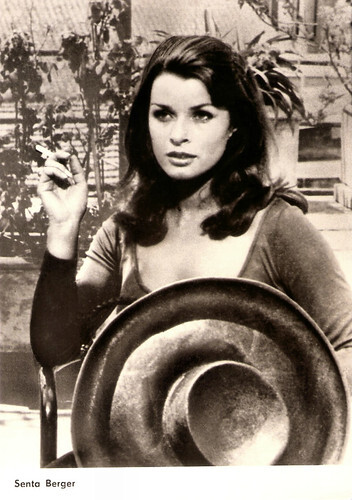
East German postcard by Progress Film-Vertrieb, Berlin, no. 3107, 1968. Senta Berger in Operazione San Gennaro/Operation San Gennaro (Dino Risi, 1966).
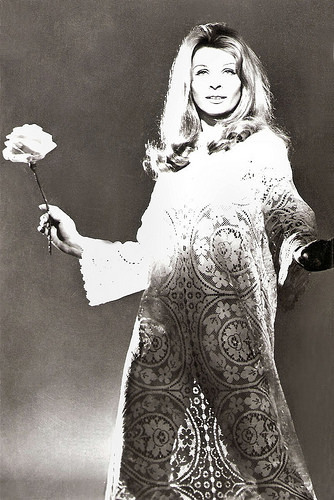
Romanian postcard by Casa Filmului Acin. Photo: publicity still for The Ambushers (Henry Levin, 1967).
Being taken seriously
In 1970 Senta Berger appeared in the Italian caveman spoof Quando le Donne Avevano la Coda/When Women Had Tails (Pasquale Festa Campanile, 1970), which was a surprise box-office hit in Italy. Her participation in this banal sex-comedy led Hal Erickson at AllMovie to the conclusion that “by 1970, Senta Berger evidently gave up any hopes of being taken seriously.”
That year though, she also starred for the first time in a film produced by her own company and directed by her husband, Wer im Glashaus liebt/He Who Loves in a Glass House (Michael Verhoeven, 1970). Two years later she featured in Volker Schlöndorff’s Die Moral der Ruth Halbfass/Morals of Ruth Halbfass (Volker Schlöndorff, 1972) followed by the leading role in Der scharlachrote Buchstabe/The Scarlet Letter (Wim Wenders, 1973).
And in Italy, she appeared in several films for high-quality directors such as Roma Bene (Carlo Lizzani, 1971), L'Amante dell'orsa maggiore/The Smugglers (Valentino Orsini, 1972), Bisturi: La Mafia Bianca/Hospitals: The White Mafia (Luigi Zampa, 1973) and the Giallo L'Uomo Senza Memoria/Puzzle (Duccio Tessari, 1974) opposite Luc Merenda.
Following the birth of her two sons, Simon (1972) and Luca (1979), Berger returned to theatre work. She played at the famous Burgtheater in Vienna, at the Thalia Theatre in Hamburg and at the Schillertheater in Berlin. Between 1974 and 1982, she played the Buhlschaft in the play Jedermann (Everyman) at the Salzburg Festival with Curd Jürgens and later Maximilian Schell in the title role.
In the cinema, she co-starred with Maximilian Schell and James Coburn in the war film Cross of Iron (Sam Peckinpah, 1977).
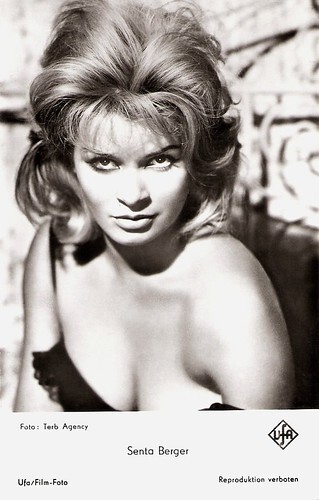
German postcard by Ufa, Berlin-Tempelhof, no. 5086. Retail price: 25 Pfg. Photo: Terb Agency.
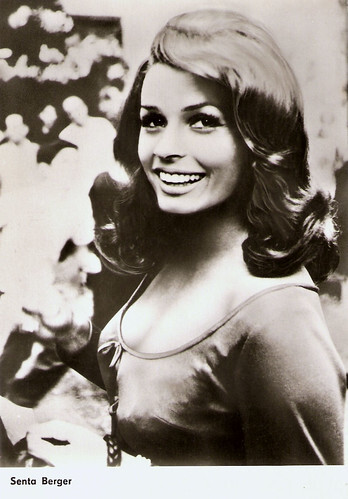
East-German postcard by VEB-Progress Film-Vertrieb, Berlin, no. 3045, 1968. Photo: G.B. Poletto and Peter Basch.
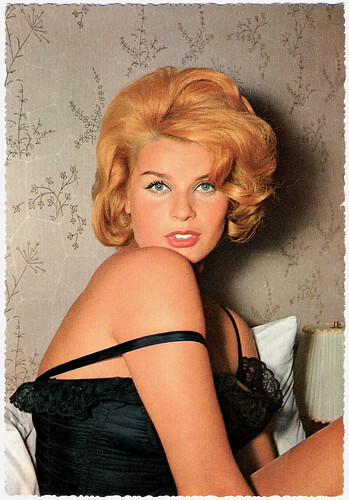
German postcard by Krüger/Ufa, no. 902/128. Photo: Terb Agency/Ufa.
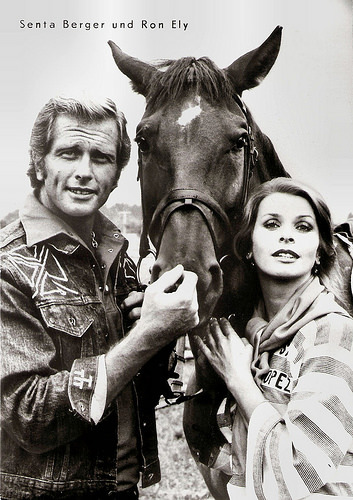
East-German postcard by VEB Progress Filmvertrieb, Berlin, no. 137/76, 1976. Photo: publicity still for MitGift/Killing Me Softly (Michael Verhoeven, 1976) with Ron Ely.
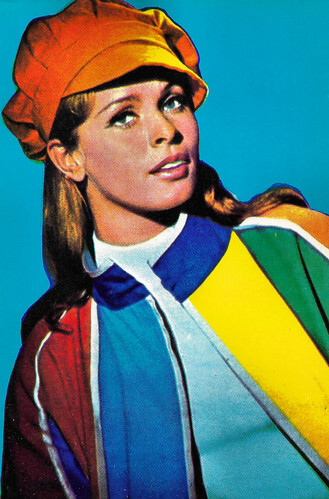
Romanian postcard by Casa Filmului Acin, no. 153.
Smart, sexy and honest
In 1985, Senta Berger started a comeback in front of German-speaking TV audiences in the popular, ironic mini-series Kir Royal (Helmut Dietl,1985-1986), about a Munich gossip reporter and the city’s legendary high society circles. Further serial hits followed, like Die schnelle Gerdi/The Fast Gerti (Michael Verhoeven, 1989), where she played a Munich cab driver. In the same year, she also started a career as a singer of Chansons.
Berger continued to work in Italy and appeared opposite Marcello Mastroianni in Le Due Vite di Mattia Pascal/The Two Lives of Mattia Pascal (Mario Monicelli, 1985), based on a Luigi Pirandello story. Berger and Verhoeven produced acclaimed and internationally successful films including Die weiße Rose/The White Rose (Michael Verhoeven, 1982) and Das schreckliche Mädchen/The Terrible Girl (Michael Verhoeven, 1990), both starring Lena Stolze.
During the 1990s, Berger was mostly seen as a smart, sexy and honest woman on TV. In 1991 she played an acclaimed role in the marriage drama Sie und Er/She and He (Frank Beyer, 1991). Series followed like Lilli Lottofee (Michael Verhoeven, 1992) and Ärzte/Doctors (1994-1996). Then she played parts in Sandra Nettelbeck‘s film debut Mammamia (1998), Bin ich schön?/Am I Beautiful (Doris Dörrie, 1998) and the TV film Trennungsfieber/Divorce Fever (Manfred Stelzer, 2000).
Since February 2003, Berger has been president of the German Film Academy, which seeks to advance the new generation of actors and actresses in Germany and Europe. The Academy will decide on the assignment of the German Film Awards in the future. 2005 saw her in the cinemas in Einmal so wie ich will/For Once As I Want It (Vivian Naefe, 2005) opposite Götz George , as a woman trapped in an unhappy marriage. She finds love on holiday but turns her back on the relationship. In the spring of 2006, Berger's autobiography was published in Germany: Ich habe ja gewußt, daß ich fliegen kann (I Knew That I Could Fly). It became a bestseller. Among her memories of Hollywood are a less-than-subtle attempt by Darryl Zanuck to get her on his casting couch, and being called ‘You German pig’ on her first day on the set of Major Dundee by a gaffer whose wife had lost her family in Auschwitz.
Senta Berger is still married to Michael Verhoeven and their sons Simon and Luca Verhoeven are both actors now. She lives in Grünwald near Munich, Germany. Recently she worked on the screen in the TV mini-series Four Seasons (Giles Foster, 2008) with Tom Conti and Michael York , the film Ruhm/Fame (Isabel Kleefeld, 2011) and the comedy Altersglühen - Speed Dating für Senioren/Old glow - Speeddating for Seniors (Jan Georg Schütte, 2014) with Mario Adorf . In 2016, she played one of the leading roles in the film Welcome to Germany, directed by her son Simon Verhoeven. The film grossed more than US$20 million, making it the most successful German picture of the year. She played the role of Doctor Eva Maria Prohacek in the popular German crime television series Unter Verdacht/Under Suspicion from 2002 till March 2020, when she retired from the role.
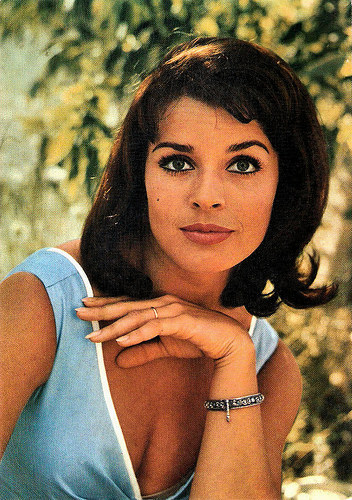
Italian postcard by Rotalcolor, Milano, no. 251.
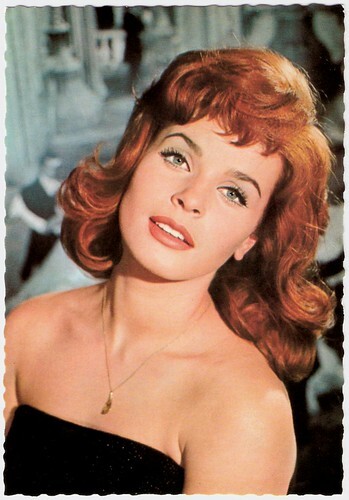
German postcard by ISV, no. H 127.
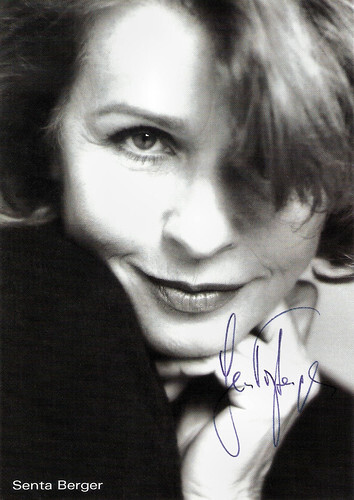
German autograph card, 2007.
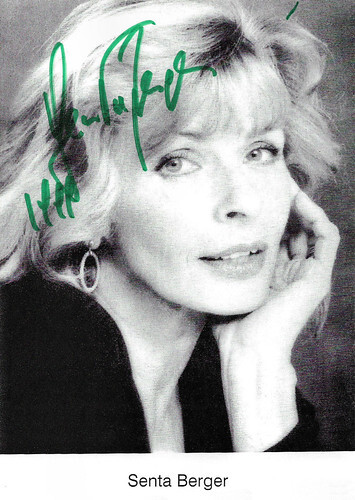
German autograph card.
Trailer for L'Uomo Senza Memoria/Puzzle (1974). Source: xploited cinema (YouTube).
Trailer for Altersglühen - Speed Dating für Senioren/Old glow - Speeddating for Seniors (2014). Source: ZYXDvD (YouTube).
Sources: Hal Erickson (AllMovie - page now defunct), Paul McElligott (Celluloid Heroes - now defunct), Lenin Imports (now defunct), The Wild Eye, Wikipedia and .

Romanian postcard by Casa Filmului Acin.

Spanish postcard by Toro de Bronce. Senta Berger in The Waltz King (Steve Previn, 1963).

Italian postcard. Photo: Dear Film. Publicity still for The Glory Guys (Arnold Laven, 1965) with Tom Tryon.

Romanian postcard by Casa Filmului Acin.

Autograph card.
Not just another European sex bomb
Senta Berger was born in Vienna, Austria in 1941 as the daughter of Therese Jany, a teacher, and Josef Berger, a musician. She first appeared on stage at age four, where her father accompanied his daughter's singing on the piano. At age five, she started ballet lessons, but Senta was asked to leave at 14 because she had ‘developed’ too much.
She then took private acting lessons and appeared as an extra in the comedy Du bist die Richtige/You Are The Right One (Erich Engel, Josef von Báky, 1955) starring Curd Jürgens . In 1957, she won her first small role in Die unentschuldigte Stunde/The Unexcused Hour (1957), one of the last films directed by legendary actor-director Willi Forst . She applied for the Max Reinhardt Seminar, a famous acting school in Vienna. Still, she was expelled shortly afterwards after accepting a small role in the film The Journey/Die Reise (Anatole Litvak, 1959) without permission. Only 17, she became the youngest member of the Theater in der Josefstadt in Vienna in 1958 and played a role in Luigi Pirandello’s Enrico IV.
Film producer Arthur Brauner offered her a role opposite German superstar Heinz Rühmann in the deft satire Der brave Soldat Schweijk/The Good Soldier Schweijk (Axel von Ambesser, 1960). Brauner signed a contract with her for several films and cast her in Schlagerfilms like O sole mio (Paul Martin, 1960) and Adieu, Lebewohl, Goodbye (1961). She soon got tired of them, but Maria Brauner, the producer’s wife, helped her to get a part next to O.W. Fischer and Eva Bartok in the thrillers Es muß nicht immer Kaviar sein/Operation Caviar (Geza von Radvanyi, 1961) and Diesmal muß es Kaviar sein/This time it has to be caviar (Geza von Radvanyi, 1961). These spy thrillers, based on the novels by Johannes Mario Simmel, meant her breakthrough.
Berger became a staple in European co-productions like Sherlock Holmes und das Halsband des Todes/Sherlock Holmes and the Deadly Necklace (Terence Fisher, Frank Winterstein, 1962) starring Christopher Lee , and Kali-Yug, la Dea della Vendetta/Vengeance of Kali (Mario Camerini, 1963) with Lex Barker .
On the invitation of Richard Widmark , with whom she had appeared in the Cold War adventure film The Secret Ways (Phil Karlson, 1961), she went to Hollywood. There she appeared in the anti-war drama The Victors (Carl Foreman, 1963) and in The Waltz King (Steve Previn, 1963), a two-parter in the TV series Walt Disney's Wonderful World of Color. Though an actress of more than average talent, Berger was regarded as just another European sex bomb by most Hollywood publicity flacks. She was offered a five-year contract by a major Hollywood studio, but she decided to return to Germany.

West German postcard by Filmbilder-Vertrieb Ernst Freihoff, Essen, no. 680. Photo: Alfa / Gloria / Grimm. Senta Berger and Rex Gildo in O sole mio (Paul Martin, 1960).

German postcard by Kolibri-Verlag, Minden/Westf., no. 1813. Photo: A. Grimm / Gloria Film. Publicity still for Frauenarzt Dr. Sibelius/Dr. Sibelius (Rudolf Jugert, 1962).

Vintage press photo. Senta Berger and Lex Barker in Frauenarzt Dr. Sibelius/Dr. Sibelius (Rudolf Jugert, 1962).

Vintage press photo. Senta Berger, Lex Barker and Barbara Rütting in Frauenarzt Dr. Sibelius/Dr. Sibelius (Rudolf Jugert, 1962).

Romanian postcard by Casa Filmului Acin. Senta Berger, Martin Held and Walter Wilz in Lange Beine - lange Finger/Long Legs, Long Fingers (Alfred Vohrer, 1966). Collection: Alina Deaconu.
Rousing entertainment
During the shooting of the comedy Jacky und Jenny/Jacky and Jenny (Victor Vicas, 1964), Senta Berger met Michael Verhoeven, son of the German film director Paul Verhoeven (not the Dutch Paul Verhoeven ). They started their own film production company Sentana-Filmproduktion in 1965 and married the following year.
Berger continued to develop her international career and played with such stars as Dean Martin , Frank Sinatra , John Wayne , and Yul Brynner . She appeared in numerous Euro-spy films such as the Italian crime comedy Operazione San Gennaro/Operation San Gennaro (Dino Risi, 1966), the British comedy Our Man in Marrakech (Don Sharp, 1966) with Tony Randall, and the French thriller Peau d’Espion/To Commit a Murder (Edouard Molinaro, 1967) with Louis Jourdan .
One of her best-known Hollywood movies is the Western Major Dundee (Sam Peckinpah, 1965) with Charlton Heston . At the Celluloid Heroes blog, Paul McElligott writes: “Major Dundee is one of Sam Peckinpah’s early works, a highly stylized Western that fits perfectly the outsized performances of its stars, Charlton Heston and Richard Harris. Neither the story, the dialogue or the acting can be called realistic, but it is what it claims to be, a rousing entertainment.”
In Cast a Giant Shadow (Melville Shavelson, 1966) with Kirk Douglas , she played the role of Magda, a soldier in the Israeli army during the Israeli War of Independence in 1948. That same year she was also a German schoolteacher involved in neo-Nazi activity opposite Max von Sydow and George Segal in the spy film The Quiller Memorandum (Michael Anderson, 1966).
A curiosity is the short film Vienna (1967) directed by Orson Welles . In the film Welles is wandering through Vienna, remembering The Third Man and then, aided by Berger and Mickey Rooney , he suddenly stumbles into a spy satire which is, according to the IMDb reviewer, “simply hilariously funny”. In 1967, Berger acted also in the pilot for the American television TV series It Takes a Thief (1968) starring Robert Wagner . She reprised her role in the series in 1969, in an episode in which her character was killed off.

German postcard by Friedrich-W. Sander-Verlag, Minden/Westf. (Kolibri Foto-karte), no. 2347.

Romanian postcard by Casa Filmului Acin, no. 449. Senta Berger in Das Testament des Dr. Mabuse/The Testament of Dr. Mabuse (Werner Klingler, 1962). Collection: Alina Deaconu.

East German postcard by VEB Progress Filmvertrieb, Berlin, no. 3012, 1967 Photo: Senta Berger and Ivan Desny in Sherlock Holmes und das Halsband des Todes/Sherlock Holmes and the Deadly Necklace (Terence Fisher, 1962).

East German postcard by Progress Film-Vertrieb, Berlin, no. 3107, 1968. Senta Berger in Operazione San Gennaro/Operation San Gennaro (Dino Risi, 1966).

Romanian postcard by Casa Filmului Acin. Photo: publicity still for The Ambushers (Henry Levin, 1967).
Being taken seriously
In 1970 Senta Berger appeared in the Italian caveman spoof Quando le Donne Avevano la Coda/When Women Had Tails (Pasquale Festa Campanile, 1970), which was a surprise box-office hit in Italy. Her participation in this banal sex-comedy led Hal Erickson at AllMovie to the conclusion that “by 1970, Senta Berger evidently gave up any hopes of being taken seriously.”
That year though, she also starred for the first time in a film produced by her own company and directed by her husband, Wer im Glashaus liebt/He Who Loves in a Glass House (Michael Verhoeven, 1970). Two years later she featured in Volker Schlöndorff’s Die Moral der Ruth Halbfass/Morals of Ruth Halbfass (Volker Schlöndorff, 1972) followed by the leading role in Der scharlachrote Buchstabe/The Scarlet Letter (Wim Wenders, 1973).
And in Italy, she appeared in several films for high-quality directors such as Roma Bene (Carlo Lizzani, 1971), L'Amante dell'orsa maggiore/The Smugglers (Valentino Orsini, 1972), Bisturi: La Mafia Bianca/Hospitals: The White Mafia (Luigi Zampa, 1973) and the Giallo L'Uomo Senza Memoria/Puzzle (Duccio Tessari, 1974) opposite Luc Merenda.
Following the birth of her two sons, Simon (1972) and Luca (1979), Berger returned to theatre work. She played at the famous Burgtheater in Vienna, at the Thalia Theatre in Hamburg and at the Schillertheater in Berlin. Between 1974 and 1982, she played the Buhlschaft in the play Jedermann (Everyman) at the Salzburg Festival with Curd Jürgens and later Maximilian Schell in the title role.
In the cinema, she co-starred with Maximilian Schell and James Coburn in the war film Cross of Iron (Sam Peckinpah, 1977).

German postcard by Ufa, Berlin-Tempelhof, no. 5086. Retail price: 25 Pfg. Photo: Terb Agency.

East-German postcard by VEB-Progress Film-Vertrieb, Berlin, no. 3045, 1968. Photo: G.B. Poletto and Peter Basch.

German postcard by Krüger/Ufa, no. 902/128. Photo: Terb Agency/Ufa.

East-German postcard by VEB Progress Filmvertrieb, Berlin, no. 137/76, 1976. Photo: publicity still for MitGift/Killing Me Softly (Michael Verhoeven, 1976) with Ron Ely.

Romanian postcard by Casa Filmului Acin, no. 153.
Smart, sexy and honest
In 1985, Senta Berger started a comeback in front of German-speaking TV audiences in the popular, ironic mini-series Kir Royal (Helmut Dietl,1985-1986), about a Munich gossip reporter and the city’s legendary high society circles. Further serial hits followed, like Die schnelle Gerdi/The Fast Gerti (Michael Verhoeven, 1989), where she played a Munich cab driver. In the same year, she also started a career as a singer of Chansons.
Berger continued to work in Italy and appeared opposite Marcello Mastroianni in Le Due Vite di Mattia Pascal/The Two Lives of Mattia Pascal (Mario Monicelli, 1985), based on a Luigi Pirandello story. Berger and Verhoeven produced acclaimed and internationally successful films including Die weiße Rose/The White Rose (Michael Verhoeven, 1982) and Das schreckliche Mädchen/The Terrible Girl (Michael Verhoeven, 1990), both starring Lena Stolze.
During the 1990s, Berger was mostly seen as a smart, sexy and honest woman on TV. In 1991 she played an acclaimed role in the marriage drama Sie und Er/She and He (Frank Beyer, 1991). Series followed like Lilli Lottofee (Michael Verhoeven, 1992) and Ärzte/Doctors (1994-1996). Then she played parts in Sandra Nettelbeck‘s film debut Mammamia (1998), Bin ich schön?/Am I Beautiful (Doris Dörrie, 1998) and the TV film Trennungsfieber/Divorce Fever (Manfred Stelzer, 2000).
Since February 2003, Berger has been president of the German Film Academy, which seeks to advance the new generation of actors and actresses in Germany and Europe. The Academy will decide on the assignment of the German Film Awards in the future. 2005 saw her in the cinemas in Einmal so wie ich will/For Once As I Want It (Vivian Naefe, 2005) opposite Götz George , as a woman trapped in an unhappy marriage. She finds love on holiday but turns her back on the relationship. In the spring of 2006, Berger's autobiography was published in Germany: Ich habe ja gewußt, daß ich fliegen kann (I Knew That I Could Fly). It became a bestseller. Among her memories of Hollywood are a less-than-subtle attempt by Darryl Zanuck to get her on his casting couch, and being called ‘You German pig’ on her first day on the set of Major Dundee by a gaffer whose wife had lost her family in Auschwitz.
Senta Berger is still married to Michael Verhoeven and their sons Simon and Luca Verhoeven are both actors now. She lives in Grünwald near Munich, Germany. Recently she worked on the screen in the TV mini-series Four Seasons (Giles Foster, 2008) with Tom Conti and Michael York , the film Ruhm/Fame (Isabel Kleefeld, 2011) and the comedy Altersglühen - Speed Dating für Senioren/Old glow - Speeddating for Seniors (Jan Georg Schütte, 2014) with Mario Adorf . In 2016, she played one of the leading roles in the film Welcome to Germany, directed by her son Simon Verhoeven. The film grossed more than US$20 million, making it the most successful German picture of the year. She played the role of Doctor Eva Maria Prohacek in the popular German crime television series Unter Verdacht/Under Suspicion from 2002 till March 2020, when she retired from the role.

Italian postcard by Rotalcolor, Milano, no. 251.

German postcard by ISV, no. H 127.

German autograph card, 2007.

German autograph card.
Trailer for L'Uomo Senza Memoria/Puzzle (1974). Source: xploited cinema (YouTube).
Trailer for Altersglühen - Speed Dating für Senioren/Old glow - Speeddating for Seniors (2014). Source: ZYXDvD (YouTube).
Sources: Hal Erickson (AllMovie - page now defunct), Paul McElligott (Celluloid Heroes - now defunct), Lenin Imports (now defunct), The Wild Eye, Wikipedia and .
Published on November 18, 2024 22:00
November 17, 2024
Familjens traditioner (1920)
Gösta Ekman and Mary Johnson starred in the silent Swedish tragicomedy Familjens traditioner/Family Traditions (1920). The film was directed by Rune Carlsten for Svensk Filmindustri (SF) and was distributed by Skandiafilm. Familjens traditioner was shot at the Skandia studio at Långängen in Stockholm with exteriors from the Råbelöv estate in Skåne and Ludvika by Raoul Reynols. Axel Eliassons Konstförlag published this series of postcards.
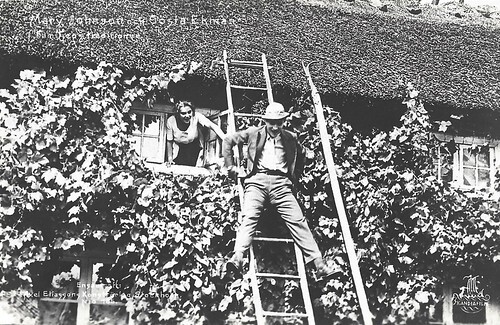
Swedish postcard by Axel Eliassons Konstförlag, no. 185. Photo: Skandiafilm. Gösta Ekman and Mary Johnson in Familjens traditioner (Rune Carlsten, 1920).
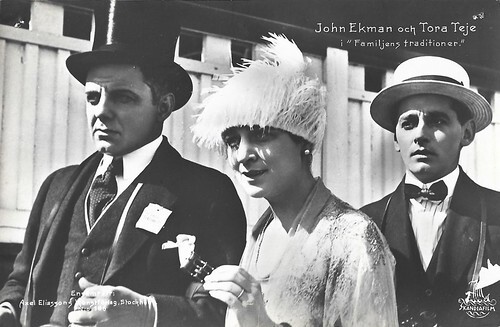
Swedish postcard by Axel Eliassons Konstförlag, no. 186. Photo: Skandiafilm. John Ekman and Tora Teje in Familjens traditioner (Rune Carlsten, 1920).
Borrowing money from a stranger
Familjens traditioner/Family Traditions (Rune Carlsten, 1920) is based on Einar Fröberg's play 'Disciplin' (Discipline), which premiered at Dramaten, the Royal Dramatic Theatre in Stockholm, in 1911. The film scenario was written by Sam Ask and director Rune Carlsten.
The young Baron Robert of Valla (Sven Bergvall) falls in love with his distant relative Helga ( Tora Teje ) on a motorbike ride. They marry.
However, Helga feels unappreciated and is kept in her place by old Aunt Frederique (Hilda Castegren) and others. It is not until the death of her father-in-law, the old Baron Stenklo (Hjalmar Selander), and Robert's appointment as lord of the manor that she begins to breathe again. She throws herself into a whirl of pleasures.
Her husband does not give her much pleasure and neglects her. Helga is courted by the owner of the estate, Sixten Borgman (John Ekman), an upstart who, on a visit to the races, persuades her to make a bet: he lends her money and she writes a receipt.
Helga loses the money, and at the ball that follows, the landowner takes the opportunity to betray her. Through the mediation of the scheming Aunt Frederique, the story comes to Robert's attention and he takes great offence at Helga's borrowing money from a stranger. After this, the marriage becomes very cold, and Helga's life becomes even more desolate than before.
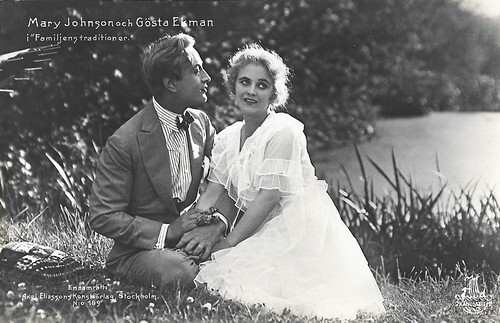
Swedish postcard by Axel Eliassons Konstförlag, no. 189. Photo: Skandiafilm. Gösta Ekman and Mary Johnson in Familjens traditioner (Rune Carlsten, 1920).
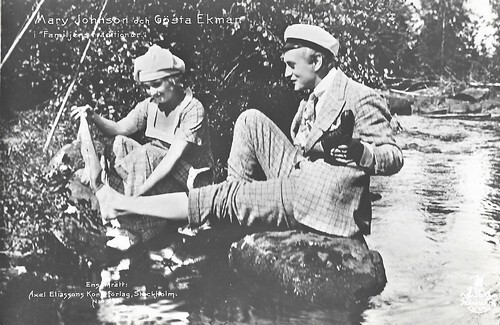
Swedish postcard by Axel Eliassons Konstförlag, no. 190. Photo: Skandiafilm. Gösta Ekman and Mary Johnson in Familjens traditioner (Rune Carlsten, 1920).
The daring intervention of the house's faithful servant
Robert's younger brother, Ernst ( Gösta Ekman ), has long had a crush on Helga and is now indignant at the way she is treated by her husband. At the same time, Ernst is very enamoured with the sweet daughter of the provost, Inga Lidner ( Mary Johnson ).
When the Stenklo family visits Provost Lidner for crayfish fishing, a series of dramatic events occur. Ernst and Inga fall out. Robert behaves rudely towards Helga. Helga seeks comfort from Ernst.
A forest fire breaks out on the estate and Robert has to go out and lead the extinguishing work. When Robert returns home at night and seeks out his wife to apologise, he finds his brother hiding in her sleeping alcove.
The situation is about to lead to the deepest misfortune when the house's faithful servant, old Bergqvist (Carl Browallius), dares to intervene. He overheard Helga talking to Ernst through the door, explaining that she loved her husband and could never betray him. Bergqvist also reminds Robert of his promise to his father: to always support his brother.
After this settlement, all is well again on the estate. The family traditions are cherished as before, but no longer as a heavy duty but in love.
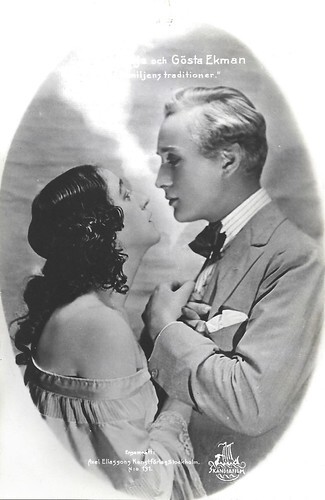
Swedish postcard by Axel Eliassons Konstförlag, no. 191. Photo: Skandiafilm. Gösta Ekman and Tora Teje in Familjens traditioner (Rune Carlsten, 1920).
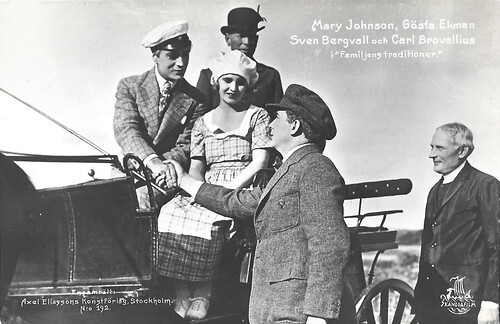
Swedish postcard by Axel Eliassons Konstförlag, no. 192. Photo: Skandiafilm. Gösta Ekman and Mary Johnson in Familjens traditioner (Rune Carlsten, 1920), here also with Sven Bergvall and Carl Browallius, mentioned here as Brovallius.
Sources: The Swedish Film Database, Wikipedia (Swedish) and IMDb.

Swedish postcard by Axel Eliassons Konstförlag, no. 185. Photo: Skandiafilm. Gösta Ekman and Mary Johnson in Familjens traditioner (Rune Carlsten, 1920).

Swedish postcard by Axel Eliassons Konstförlag, no. 186. Photo: Skandiafilm. John Ekman and Tora Teje in Familjens traditioner (Rune Carlsten, 1920).
Borrowing money from a stranger
Familjens traditioner/Family Traditions (Rune Carlsten, 1920) is based on Einar Fröberg's play 'Disciplin' (Discipline), which premiered at Dramaten, the Royal Dramatic Theatre in Stockholm, in 1911. The film scenario was written by Sam Ask and director Rune Carlsten.
The young Baron Robert of Valla (Sven Bergvall) falls in love with his distant relative Helga ( Tora Teje ) on a motorbike ride. They marry.
However, Helga feels unappreciated and is kept in her place by old Aunt Frederique (Hilda Castegren) and others. It is not until the death of her father-in-law, the old Baron Stenklo (Hjalmar Selander), and Robert's appointment as lord of the manor that she begins to breathe again. She throws herself into a whirl of pleasures.
Her husband does not give her much pleasure and neglects her. Helga is courted by the owner of the estate, Sixten Borgman (John Ekman), an upstart who, on a visit to the races, persuades her to make a bet: he lends her money and she writes a receipt.
Helga loses the money, and at the ball that follows, the landowner takes the opportunity to betray her. Through the mediation of the scheming Aunt Frederique, the story comes to Robert's attention and he takes great offence at Helga's borrowing money from a stranger. After this, the marriage becomes very cold, and Helga's life becomes even more desolate than before.

Swedish postcard by Axel Eliassons Konstförlag, no. 189. Photo: Skandiafilm. Gösta Ekman and Mary Johnson in Familjens traditioner (Rune Carlsten, 1920).

Swedish postcard by Axel Eliassons Konstförlag, no. 190. Photo: Skandiafilm. Gösta Ekman and Mary Johnson in Familjens traditioner (Rune Carlsten, 1920).
The daring intervention of the house's faithful servant
Robert's younger brother, Ernst ( Gösta Ekman ), has long had a crush on Helga and is now indignant at the way she is treated by her husband. At the same time, Ernst is very enamoured with the sweet daughter of the provost, Inga Lidner ( Mary Johnson ).
When the Stenklo family visits Provost Lidner for crayfish fishing, a series of dramatic events occur. Ernst and Inga fall out. Robert behaves rudely towards Helga. Helga seeks comfort from Ernst.
A forest fire breaks out on the estate and Robert has to go out and lead the extinguishing work. When Robert returns home at night and seeks out his wife to apologise, he finds his brother hiding in her sleeping alcove.
The situation is about to lead to the deepest misfortune when the house's faithful servant, old Bergqvist (Carl Browallius), dares to intervene. He overheard Helga talking to Ernst through the door, explaining that she loved her husband and could never betray him. Bergqvist also reminds Robert of his promise to his father: to always support his brother.
After this settlement, all is well again on the estate. The family traditions are cherished as before, but no longer as a heavy duty but in love.

Swedish postcard by Axel Eliassons Konstförlag, no. 191. Photo: Skandiafilm. Gösta Ekman and Tora Teje in Familjens traditioner (Rune Carlsten, 1920).

Swedish postcard by Axel Eliassons Konstförlag, no. 192. Photo: Skandiafilm. Gösta Ekman and Mary Johnson in Familjens traditioner (Rune Carlsten, 1920), here also with Sven Bergvall and Carl Browallius, mentioned here as Brovallius.
Sources: The Swedish Film Database, Wikipedia (Swedish) and IMDb.
Published on November 17, 2024 22:00
November 16, 2024
Johnny Mack Brown
Johnny Mack Brown (1904-1974) was an American actor and American football player. The good-looking Brown became a fairly successful leading man at MGM for nearly five years, appearing opposite such famous actresses as Mary Pickford, Greta Garbo and Joan Crawford. In 1935, he became the cowboy hero in numerous inexpensively produced Westerns. Between 1927 and 1966, he appeared in over 170 films and several television productions.
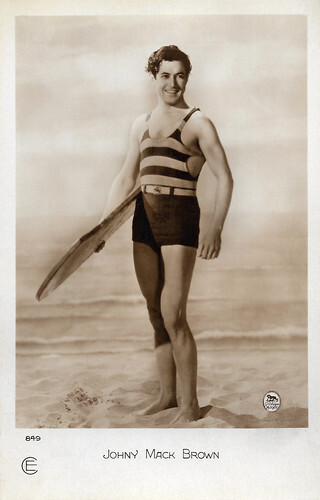
French postcard by Cinémagazine-Edition, no. 849. Photo: Metro Goldwyn Mayer.
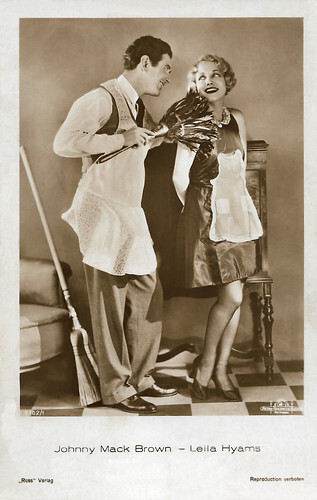
German postcard by Ross Verlag, no. 5102/1, 1930-1931. Photo: Metro-Goldwyn-Mayer. Johnny Mack Brown and Leila Hyams starred together in such films as Hurricane (Ralph Ince, 1929) and Saturday's Millions (Edward Sedgwick, 1933).
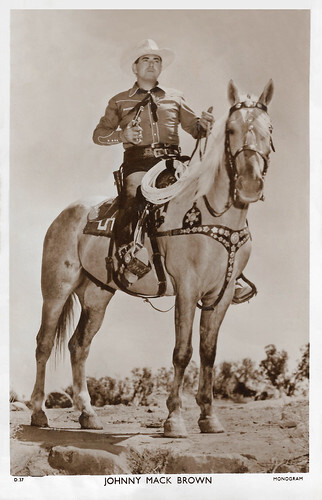
British postcard in the Picturegoer Series, London, no. D 37. Photo: Monogram.
National sports hero
John ‘Johnny’ Mack Brown was born in 1904 in Dothan, Alabama. He was the second of nine children of John Henry Brown and Hattie (McGillivray) Brown. At an early age, he became interested in hunting and fishing as well as playing high school sports. Brown graduated from Dothan High School in 1922. For the University of Alabama football team, he scored two of their three touchdowns against the favoured Washington Huskies in the 1926 Rose Bowl.
His outstanding performance made him a national sports hero. His physique and appearance attracted the attention of Metro-Goldwyn-Mayer, who signed him in 1927. Brown debuted in Slide, Kelly, Slide (Edward Sedgwick, 1927) with William Haines in a film about - baseball. This was followed by The Bugle Call (Edward Sedgwick, 1927), which starred the fading Jackie Coogan . In 1928 he appeared in Norma Shearer ’s last silent film, A Lady of Chance (Robert Z. Leonard, 1928).
For a few years, John Mack Brown, who was now usually referred to as Johnny Mack Brown in the film credits, was regarded by many as the next big film star. He was used in prestige productions in leading roles or larger supporting roles. In the same year, he was seen as Greta Garbo 's co-star in The Divine Woman (Victor Sjöström, 1928) and A Woman of Affairs (Clarence Brown, 1928) and appeared alongside Joan Crawford in Our Dancing Daughters (Harry Beaumont, 1928). A year later, he appeared alongside Mary Pickford in her first sound film Coquette (Sam Taylor, 1929). Pickford received an Oscar for Best Actress for this film.
With the advent of the talkies at the end of the 1920s, Johnny Mack Brown's slow, southern drawl and strong Alabama accent became a handicap. He starred as Billy the Kid in King Vidor 's monumental Western Billy the Kid (1930) with Wallace Beery as Sheriff Pat Garrett. While Vidor did not want him for the part to begin with, the picture was successful. However, Brown's career at MGM soon ended. His role alongside Joan Crawford in Laughing Sinners (Harry Beaumont, 1931) was cut after a disastrous preview and the film was almost completely reshot with Clark Gable . It was also Gable who in the future took on most of the roles which were intended for Brown.
MGM opted not to renew his contract. Having been a star at MGM, he was able to land some roles at other studios during the next four or five years. By the mid-1930s, Johnny Mack Brown needed some help. It arrived in the form of A. William Hackel, the Poverty Row producer and owner of Supreme Pictures plus a bit of good luck. Republic Pictures was formed in 1935 with the merger of Mascot Pictures, Monogram Pictures, and Consolidated Film Laboratories. The new startup company needed some Westerns to distribute, and they reached an agreement with Hackel for new Brown adventures which would carry the Republic Pictures logo. This gave a career boost to Johnny Mack Brown.
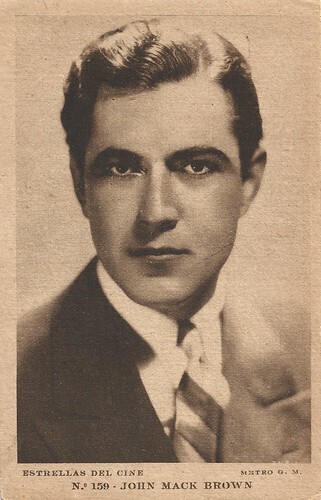
Spanish postcard in the Estrellas del Cine series, no. 159. Photo: Metro-Goldwyn-Mayer.
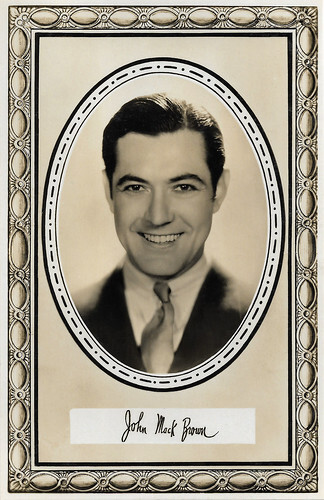
British postcard in the Autograph Series, London, no. 6.
Among the top ten highest-grossing Western stars at the box office
Johnny Mack Brown began a long association with Universal. His first Western serial for the studio was Rustlers of Red Dog (12 chapters, Lew Landers, 1935). Three more followed: Wild West Days (13 chapters, Ford Beebe, Clifford Smith, 1937), Flaming Frontiers (15 chapters, Alan James, Ray Taylor, 1938), and The Oregon Trail (15 chapters, Ford Beebe, Saul A. Goodkind, 1939). His other films from this period include Born to the West/Hell Town (Charles Barton, 1937), with John Wayne , and Wells Fargo (Frank Lloyd, 1937) with Joel McCrea . Mack Brown was practically never seen in films of other genres.
From 1939 to 1943, Mack Brown starred in 28 Westerns for Universal - six with Bob Baker, fifteen on his own, and a final seven with Tex Ritter as co-star. Nell O'Day, Jennifer Holt and Fuzzy Knight were among the most frequent cast members. From 1942 to 1950, he was continuously among the top ten highest-grossing Western stars at the box office.
During World War II years, Universal was going through a shift in priorities and its horror production unit was given new life. Little Monogram Pictures brought out the Rough Riders series in 1941-1942, which starred Buck Jones , Tim McCoy and Raymond Hatton. But Jones had been killed in the November 1942 Cocoanut Grove nightclub fire in Boston, and Colonel Tim McCoy was called back to Army duty for World War II.
Scott R. Dunlap, Monogram's production boss, needed a quick replacement and was looking for an already recognized star with box office following and signed Johnny Mack Brown. He remained on the Monogram payroll for about ten years. The decision to hire Brown turned out to be timely. Monogram’s other trio series, the Range Busters, concluded filming in late 1942. Monogram needed Johnny Mack Brown.
Brown's sidekick was Raymond Hatton and he portrayed 'Sandy Hopkins', the same role he played in the Rough Riders. He did 45 films with Brown which were released in 1943-1948. Brown's first Western for Monogram was The Ghost Rider (Wallace Fox, 1943). His character name in the early entries was 'Nevada Jack McKenzie'. The name soon changed to Johnny. As with most of the early cowboy stars, he was a hero to millions of young children. His last Western at Monogram was Canyon Ambush (Lewis D. Collins, 1952). In between, Brown had starred in more than 60 Westerns for Monogram Pictures. In 1953, the days of the ‘B’ Western came to an end.
After 1953, Brown increasingly withdrew from the film business. He made guest appearances in a few later Westerns, such as The Bounty Killer (Spencer Gordon Bennet, 1965), Requiem for Gunfighter (Spencer Gordon Bennet, 1965) with Rod Cameron, and Apache Uprising (R.G. Springsteen, 1966) starring Rory Calhoun . For his All-American exploits on the football field, Brown was inducted into the College Football Hall of Fame in 1957, and the Rose Bowl Hall Of Fame in 2001. Brown died in 1974 in Woodland Hills, Los Angeles, California. He was married to Cornelia ‘Connie’ Foster from 1926 until his death. The couple had four children, Jane Harriet (died 1997), Cynthia, Sally and John Lachlan (Locky). John Mack Brown is interred at Forest Lawn, Glendale, California, in the Court of Freedom, Columbarium of Heavenly Peace.
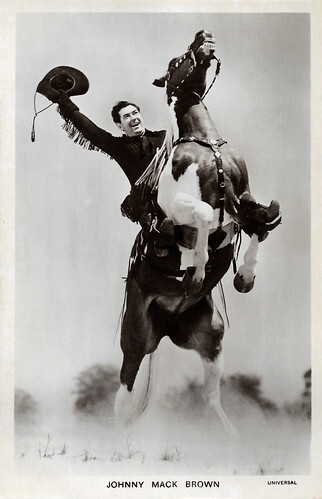
British postcard in the Picturegoer Series, London, no. 1408. Photo: Universal.
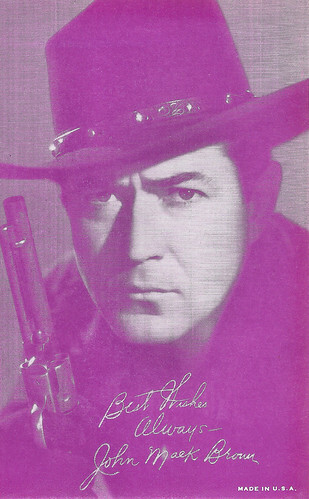
American Arcade Card.
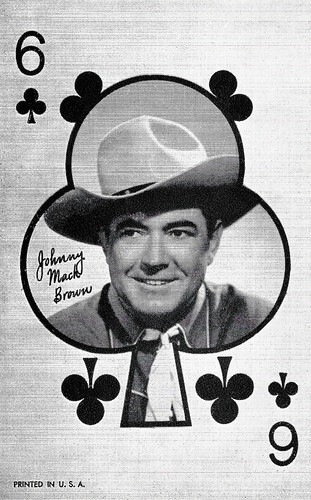
American Arcade card.
Sources: Chuck Anderson (The B Western.com), (IMDb), Wikipedia (German and English) and .

French postcard by Cinémagazine-Edition, no. 849. Photo: Metro Goldwyn Mayer.

German postcard by Ross Verlag, no. 5102/1, 1930-1931. Photo: Metro-Goldwyn-Mayer. Johnny Mack Brown and Leila Hyams starred together in such films as Hurricane (Ralph Ince, 1929) and Saturday's Millions (Edward Sedgwick, 1933).

British postcard in the Picturegoer Series, London, no. D 37. Photo: Monogram.
National sports hero
John ‘Johnny’ Mack Brown was born in 1904 in Dothan, Alabama. He was the second of nine children of John Henry Brown and Hattie (McGillivray) Brown. At an early age, he became interested in hunting and fishing as well as playing high school sports. Brown graduated from Dothan High School in 1922. For the University of Alabama football team, he scored two of their three touchdowns against the favoured Washington Huskies in the 1926 Rose Bowl.
His outstanding performance made him a national sports hero. His physique and appearance attracted the attention of Metro-Goldwyn-Mayer, who signed him in 1927. Brown debuted in Slide, Kelly, Slide (Edward Sedgwick, 1927) with William Haines in a film about - baseball. This was followed by The Bugle Call (Edward Sedgwick, 1927), which starred the fading Jackie Coogan . In 1928 he appeared in Norma Shearer ’s last silent film, A Lady of Chance (Robert Z. Leonard, 1928).
For a few years, John Mack Brown, who was now usually referred to as Johnny Mack Brown in the film credits, was regarded by many as the next big film star. He was used in prestige productions in leading roles or larger supporting roles. In the same year, he was seen as Greta Garbo 's co-star in The Divine Woman (Victor Sjöström, 1928) and A Woman of Affairs (Clarence Brown, 1928) and appeared alongside Joan Crawford in Our Dancing Daughters (Harry Beaumont, 1928). A year later, he appeared alongside Mary Pickford in her first sound film Coquette (Sam Taylor, 1929). Pickford received an Oscar for Best Actress for this film.
With the advent of the talkies at the end of the 1920s, Johnny Mack Brown's slow, southern drawl and strong Alabama accent became a handicap. He starred as Billy the Kid in King Vidor 's monumental Western Billy the Kid (1930) with Wallace Beery as Sheriff Pat Garrett. While Vidor did not want him for the part to begin with, the picture was successful. However, Brown's career at MGM soon ended. His role alongside Joan Crawford in Laughing Sinners (Harry Beaumont, 1931) was cut after a disastrous preview and the film was almost completely reshot with Clark Gable . It was also Gable who in the future took on most of the roles which were intended for Brown.
MGM opted not to renew his contract. Having been a star at MGM, he was able to land some roles at other studios during the next four or five years. By the mid-1930s, Johnny Mack Brown needed some help. It arrived in the form of A. William Hackel, the Poverty Row producer and owner of Supreme Pictures plus a bit of good luck. Republic Pictures was formed in 1935 with the merger of Mascot Pictures, Monogram Pictures, and Consolidated Film Laboratories. The new startup company needed some Westerns to distribute, and they reached an agreement with Hackel for new Brown adventures which would carry the Republic Pictures logo. This gave a career boost to Johnny Mack Brown.

Spanish postcard in the Estrellas del Cine series, no. 159. Photo: Metro-Goldwyn-Mayer.

British postcard in the Autograph Series, London, no. 6.
Among the top ten highest-grossing Western stars at the box office
Johnny Mack Brown began a long association with Universal. His first Western serial for the studio was Rustlers of Red Dog (12 chapters, Lew Landers, 1935). Three more followed: Wild West Days (13 chapters, Ford Beebe, Clifford Smith, 1937), Flaming Frontiers (15 chapters, Alan James, Ray Taylor, 1938), and The Oregon Trail (15 chapters, Ford Beebe, Saul A. Goodkind, 1939). His other films from this period include Born to the West/Hell Town (Charles Barton, 1937), with John Wayne , and Wells Fargo (Frank Lloyd, 1937) with Joel McCrea . Mack Brown was practically never seen in films of other genres.
From 1939 to 1943, Mack Brown starred in 28 Westerns for Universal - six with Bob Baker, fifteen on his own, and a final seven with Tex Ritter as co-star. Nell O'Day, Jennifer Holt and Fuzzy Knight were among the most frequent cast members. From 1942 to 1950, he was continuously among the top ten highest-grossing Western stars at the box office.
During World War II years, Universal was going through a shift in priorities and its horror production unit was given new life. Little Monogram Pictures brought out the Rough Riders series in 1941-1942, which starred Buck Jones , Tim McCoy and Raymond Hatton. But Jones had been killed in the November 1942 Cocoanut Grove nightclub fire in Boston, and Colonel Tim McCoy was called back to Army duty for World War II.
Scott R. Dunlap, Monogram's production boss, needed a quick replacement and was looking for an already recognized star with box office following and signed Johnny Mack Brown. He remained on the Monogram payroll for about ten years. The decision to hire Brown turned out to be timely. Monogram’s other trio series, the Range Busters, concluded filming in late 1942. Monogram needed Johnny Mack Brown.
Brown's sidekick was Raymond Hatton and he portrayed 'Sandy Hopkins', the same role he played in the Rough Riders. He did 45 films with Brown which were released in 1943-1948. Brown's first Western for Monogram was The Ghost Rider (Wallace Fox, 1943). His character name in the early entries was 'Nevada Jack McKenzie'. The name soon changed to Johnny. As with most of the early cowboy stars, he was a hero to millions of young children. His last Western at Monogram was Canyon Ambush (Lewis D. Collins, 1952). In between, Brown had starred in more than 60 Westerns for Monogram Pictures. In 1953, the days of the ‘B’ Western came to an end.
After 1953, Brown increasingly withdrew from the film business. He made guest appearances in a few later Westerns, such as The Bounty Killer (Spencer Gordon Bennet, 1965), Requiem for Gunfighter (Spencer Gordon Bennet, 1965) with Rod Cameron, and Apache Uprising (R.G. Springsteen, 1966) starring Rory Calhoun . For his All-American exploits on the football field, Brown was inducted into the College Football Hall of Fame in 1957, and the Rose Bowl Hall Of Fame in 2001. Brown died in 1974 in Woodland Hills, Los Angeles, California. He was married to Cornelia ‘Connie’ Foster from 1926 until his death. The couple had four children, Jane Harriet (died 1997), Cynthia, Sally and John Lachlan (Locky). John Mack Brown is interred at Forest Lawn, Glendale, California, in the Court of Freedom, Columbarium of Heavenly Peace.

British postcard in the Picturegoer Series, London, no. 1408. Photo: Universal.

American Arcade Card.

American Arcade card.
Sources: Chuck Anderson (The B Western.com), (IMDb), Wikipedia (German and English) and .
Published on November 16, 2024 22:00
November 15, 2024
Maria Jacobini
According to the late film historian Vittorio Martinelli, Maria Jacobini (1892-1944) was an island of serenity among the Italian divas. Jacobini was the personification of goodness, of simple love. Her weapon was her sweet and gracious smile. However, in some Italian, and later also in German films, she could as well play the vivacious lady, the femme fatale, the comedienne, the hysterical victim, or the suffering mother or wife.
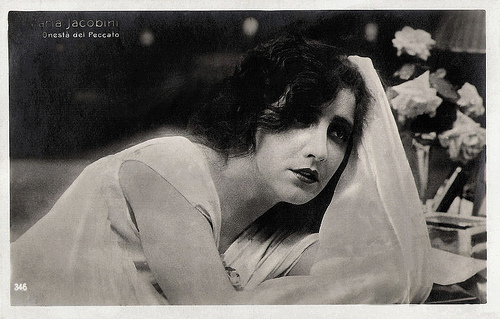
Italian postcard by Ed. Vettori, Bologna, no. 346. Sent by mail in 1926. Maria Jacobini in Onestà del Peccato/The Wife He Neglected (Augusto Genina, 1918).
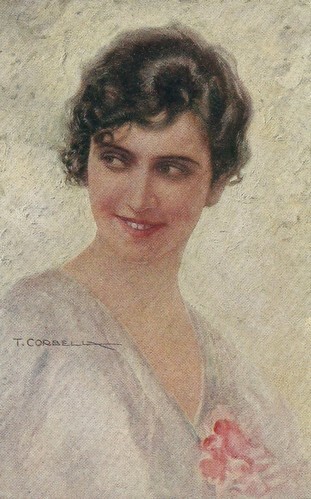
Italian postcard by Milano, Uff. Rev. Stampa, no. 891. Portrait of the actress Maria Jacobini by Tito Corbella.
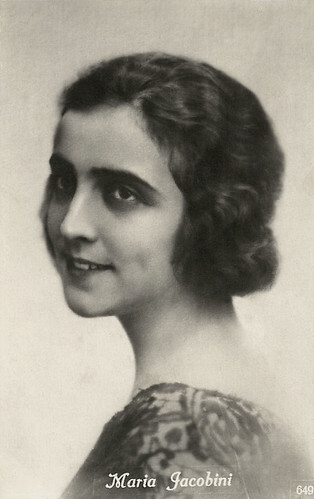
Italian postcard by Ed. Romeo Biagi, Bologna, no. 649.
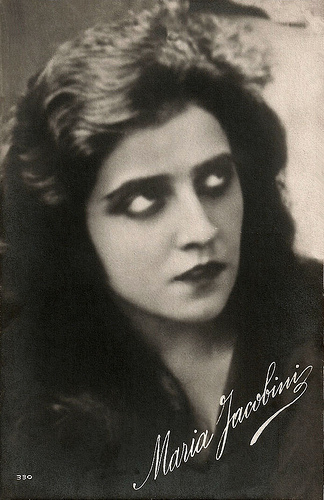
Italian postcard by Dist. Ed. SARPIC, Bucarest, Romania, no. 330.
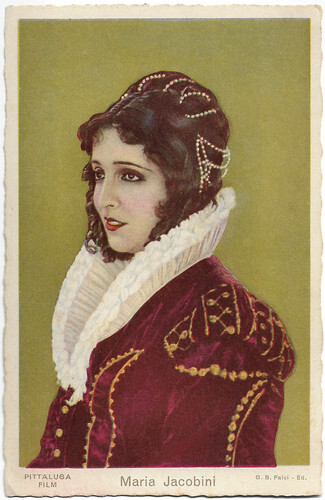
Italian postcard by G.B. Falci Ed. for Unica - Ciocolato Talmone al latte. Photo: Pittaluga Film. Maria Jacobini in Beatrice Cenci (Baldassarre Negroni, 1926).
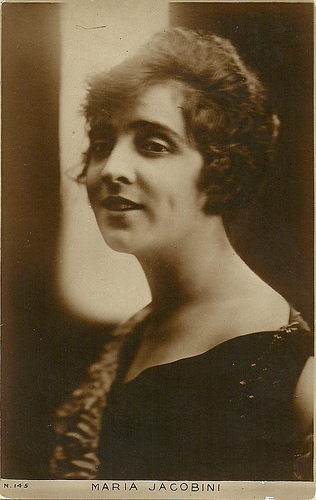
Italian postcard by Ed. Bettini, Roma, no. 145.
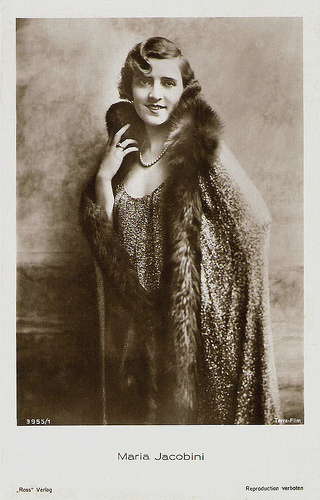
German postcard by Ross Verlag, no. 3953/1, 1928-1929. Photo: Terra-Film.
Seductive man-eater
Maria Jacobini was born in Rome, Italy, in 1892. She was the sister of actress Diomira Jacobini . Their older sister Bianca had also started out as an actress but had interrupted her career after four films. Maria studied at the Accademia di Arte Drammatica di S. Cecilia, where her teachers were Virginia Marini and Eduardo Boutet. She made her stage debut at the company of Cesare Dondini Jr., where she mainly played secondary parts.
She was noticed by Ugo Falena, artistic director of the film company Film d'Arte Italiana. He offered her to work in the silent cinema. Her first short films were Lucrezia Borgia/Lucretia Borgia (Ugo Falena, 1910) featuring diva Francesca Bertini , and Beatrice Cenci (Ugo Falena, 1910), but her first important role was in Cesare Borgia (Gerolamo Lo Savio, 1912) again starring Bertini.
In 1912, Maria started to work at the Savoia company of Turin, as a seductive man-eater in short films like Pantera/Panther (1912), La zingara/The Gypsy (Sandro Camasio, 1912), and L'onta nascosta/The Hidden Shame (1912).
From 1913 on, she played her more dramatic roles as the lead in Giovanna d'Arco/Joan of Arc (Ubaldo Maria del Colle, 1913) and Ananke (Nino Oxilia, 1915) with Leda Gys and her sister Diomira Jacobini .
Jacobini worked for pioneering film studios like Pasquali and Celio. Maria gave good performances in the melancholic Come le foglie/Like the Leaves (Gennaro Righelli, 1916) based on Giuseppe Giacosa's stage play, and in the touching Addio Giovinezza/Good-bye Youth (Augusto Genina, 1918). She made a series of films with director Gennaro Righelli such as Il viaggio/The Journey (1921), based on a novel by Luigi Pirandello, and Cainà - la figlia dell'isola/Cainà - the Daughter of the Island (1923), shot in Sardinia.
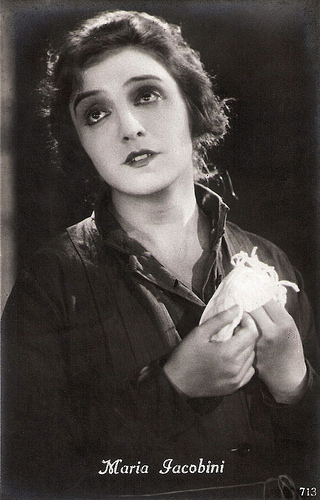
Italian postcard by Ed. A. Traldi, Milano, no. 713.
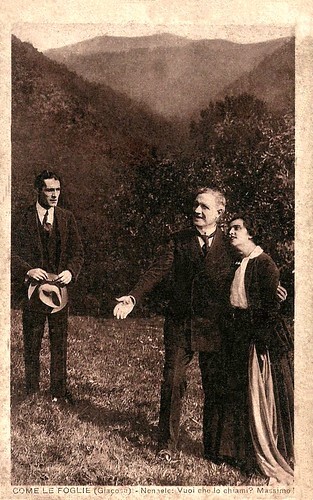
Italian postcard. Photo: Tiber Film. Publicity still for Come le foglie/Like the Leaves (Gennaro Righelli, 1917), based on the stage play by Giuseppe Giacosa. Father Giovanni ( Ignazio Lupi ) unites his daughter Nennele (Maria Jacobini) with his cousin Massimo (Guido Guiducci). Translation caption: Nennele: Shall I call him? Massimo! Content of the film: After a life of spendthrifts, the Rosati family is ruined. Father Giovanni ( Ignazio Lupi ) accepts work from his cousin Massimo (Guido Guiducci). Hitherto neglected as too serious and workaholic, Massimo becomes the head of the family and takes care of the son and daughter of Giovanni, Tommy ( Alberto Collo ) and Nennele (Jacobini), and their stepmother Giulia (Floriana). Tommy and Giulia remain weak spirits, but after an attempted suicide, Nennele realises Massimo's force and unites with him.
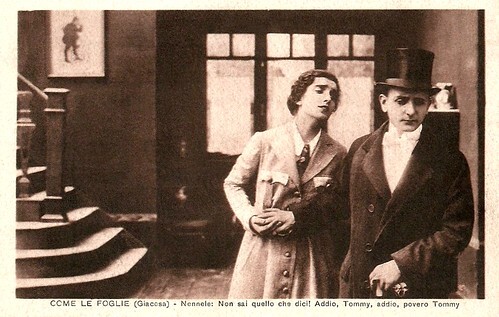
Italian postcard. Photo: Tiber Film, Roma. Publicity still for Come le foglie/Like the Leaves (Gennaro Righelli, 1917). Maria Jacobini (Nennele) and Alberto Collo (Tommy). Translation caption: Nennele: You don't know what you're saying! Farewell, Tommy, farewell, poor Tommy!
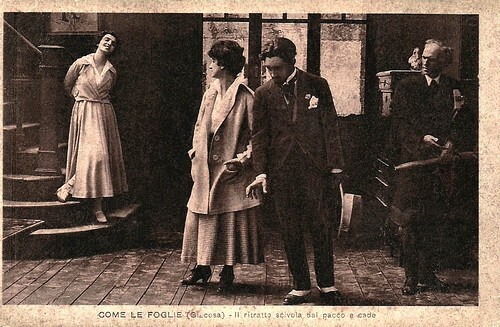
Italian postcard. Photo: Tiber Film, Roma. Publicity still for Come le foglie/Like the Leaves (Gennaro Righelli, 1917). Left Maria Jacobini. The man in the middle could be Guido Guiducci. Translation caption: The portrait slipped from the package and fell to the ground.
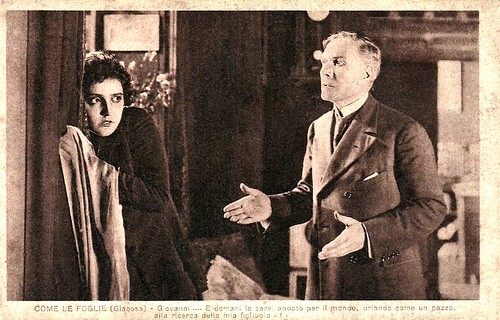
Italian postcard. Photo: Tiber Film, Roma. Maria Jacobini and Ignazio Lupi in the Italian silent film Come le foglie/Like the Leaves (Gennaro Righelli, 1917), based on the stage play by Giuseppe Giacosa. The caption translates: 'Giovanni: And tomorrow I would have been out in the world, shouting like a madman, searching for my little daughter'.
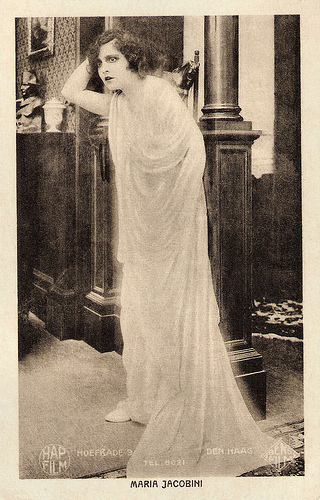
Dutch postcard by E & B, no. 518. Photo: HAP Film, Den Haag / Bens Film. Possibly this card uses a still from L'onestà del peccato/La fine di un vile/The Wife He Neglected (Augusto Genina, 1918), in which Jacobini wears a similar dress. The film was restored by the Museo Nazionale del Cinema in Turin and shown at the Cinema Ritrovato Festival in Bologna in 2017.
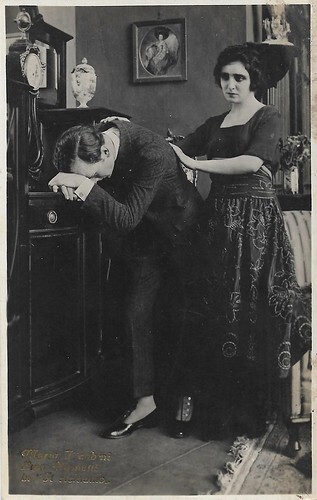
Italian postcard by Ed. G.B. Falci, Milano, no. 101. Maria Jacobini and Lido Manetti in Il richiamo/The Call (Gennaro Righelli, 1921).
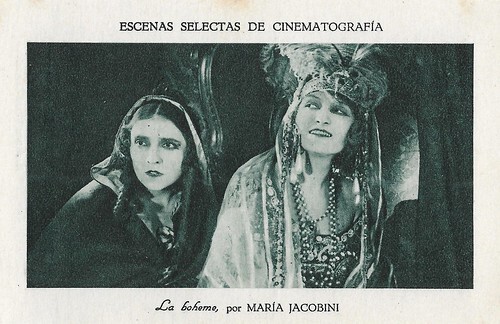
Spanish collector card in the Escenas selectas de cinematografia series. Maria Jacobini in La Bohème/Boheme - Künstlerliebe (Gennaro Righelli, 1923), based on the novel by Henri Murger, which later was turned into an opera by Giacomo Puccini.
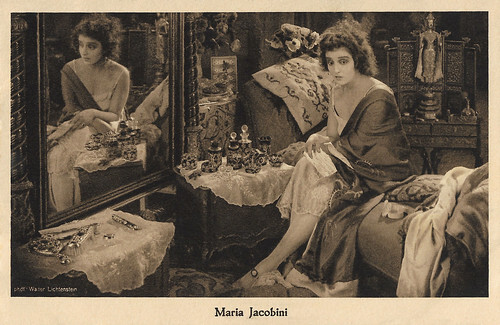
German postcard by Ross Verlag for Trianon Film-Verleih G.m.b.H., Berlin. Phot: Walter Lichtenstein. Maria Jacobini as Katja in Orient - Die Tochter der Wüste/Orient (Gennaro Righelli, 1924).
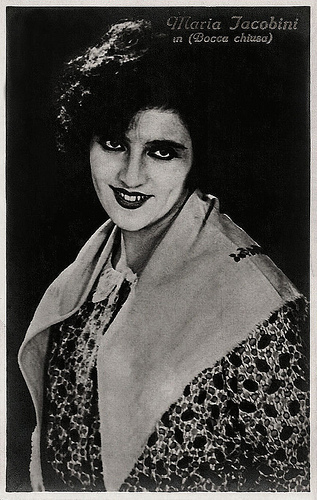
Italian postcard by G.B. Falci, Milano, no. 348. Maria Jacobini in the silent film La bocca chiusa (Guglielmo Zorzi, 1925).
Berlin
After the First World War, the Italian film industry was in a deep crisis, and director Gennaro Righelli and his star Maria Jacobini decided to move to Germany.
In Berlin, the new centre of the European film industry, Jacobini and Righelli were enlisted by producer Jakob Karoll and they founded a separate company called Maria Jacobini GmbH.
Jacobini first starred in Bohème - Künstlerliebe/Bohème - Artists Love (Gennaro Righelli, 1923), playing the tormented and suffering Mimi. Her film partner was Wilhelm Dieterle , who would later become known as Hollywood director William Dieterle.
She often performed in Righelli's German films and other directors' films. She was directed by Jaap Speyer in Bigamie/Bigamy (1927), Robert Dinesen in Ariadne im Hoppegarten (1928) with Alfred Abel , Richard Oswald in Villa Falconieri (1928) opposite Hans Stüwe , and by Fedor Ozep in the German-Russian coproduction Der lebende Leichnam/Zhivoy trup/The Living Corpse (1929), based on the play by Leo Tolstoy.
These productions were shot all over Europe, and Jacobini even filmed in Africa for Die Frauengasse von Algier/The Street of Women of Algiers (Wolfgang Hoffmann-Harnisch, 1927) with Camilla Horn .
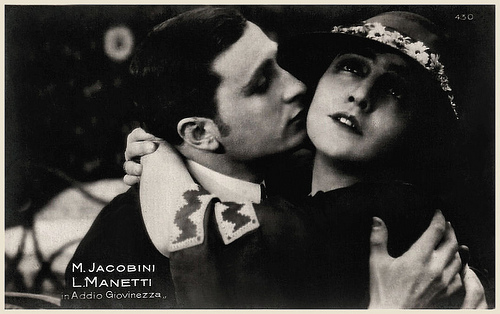
Italian postcard, no. 430. Photo: Maria Jacobini and Lido Manetti in the silent film Addio giovinezza/Goodbye Youth (Augusto Genina, 1918), an adaptation of the play by Sandro Camasio and Nino Oxilia.
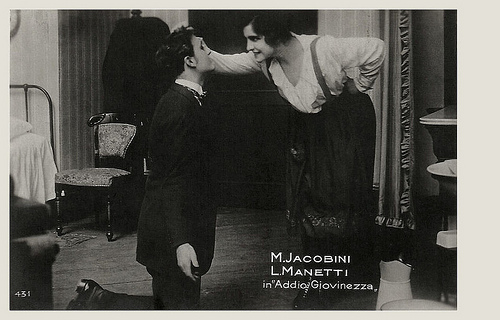
Italian postcard, no. 431. Photo: Maria Jacobini and Lido Manetti in the silent film Addio giovinezza/Good-Bye Youth (Augusto Genina, 1918).
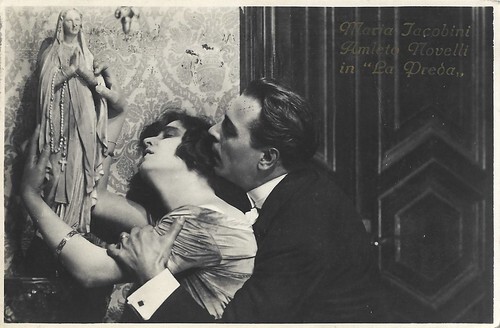
Italian postcard by G.B. Falci, Milano. Photo: Maria Jacobini and Amleto Novelli in La preda/The Prey (Guglielmo Zorzi, 1921).
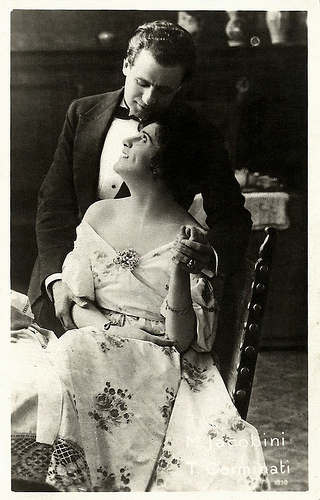
Italian postcard by Ed. Vettori, Bologna. Photo: probably publicity still for L'articolo IV (Gennaro Righelli, 1918) in which Jacobini and Tullio Carminati were the leading actors. The film is about Duchess Jenny who offers her hand to the only man who didn't court her, the Count d'Hauteville. She has a condition, though: for a long time the two must first live together as mere friends and if they don't get along they will divorce. Will both keep this promise? The card suggests otherwise...
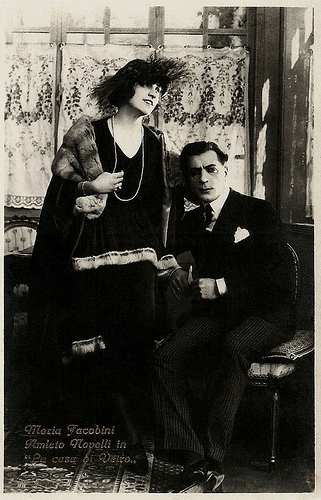
Italian postcard by G.B. Falci, Milano, no. 13. Photo: Maria Jacobini and Amleto Novelli in La casa di vetro/The Glass House (Gennaro Righelli, 1920).
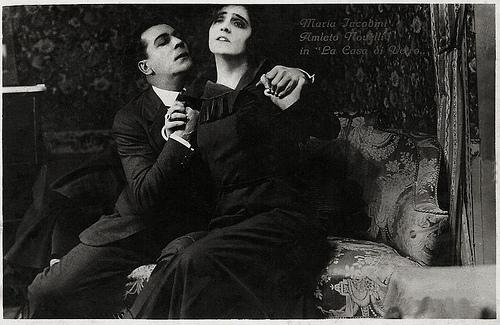
Italian postcard by G.B. Falci, Milano. Photo: publicity still for La casa di vetro/The Glass House (Gennaro Righelli, 1920) with Jacobini and Amleto Novelli .
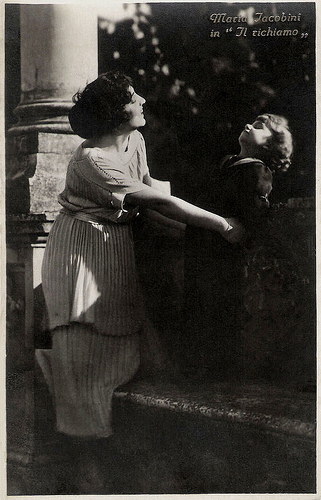
Italian postcard by G.B. Falci, Milano, no. 92. Photo: publicity still for Il richiamo/The Call (Gennaro Righelli, 1921).
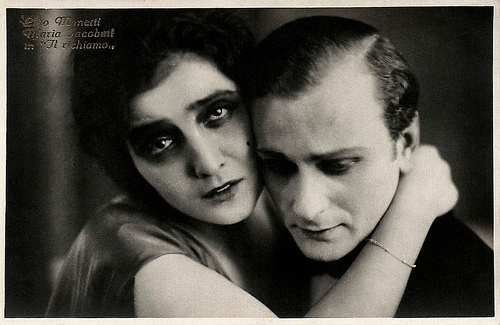
Italian postcard by G.B. Falci, Milano, no. 67. Publicity still of Maria Jacobini and Lido Manetti in Il richiamo/The Call (Gennaro Righelli, 1921). A print of this film is in the Komiya Collection at the National Film Center in Tokyo. A restored version was shown at the last edition of the festival Cinema Ritrovato in Bologna (June/July 2012).
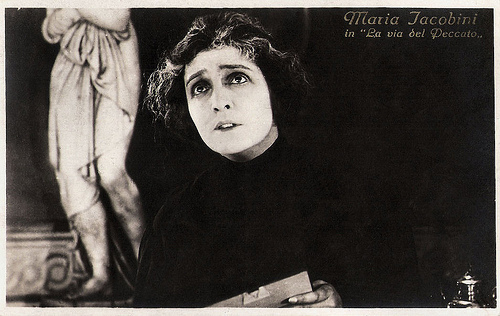
Italian postcard. Photo: publicity still for La via del peccato (Amleto Palermi, 1925).
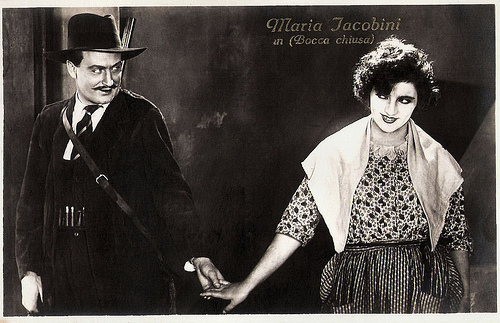
Italian postcard by G.B. Falci, Milano. Photo: Maria Jacobini in La bocca chiusa/The Closed Mouth (Guglielmo Zorzi, 1925) with Lido Manetti .
Marginal roles
In the second half of the 1920s, Maria Jacobini performed also in a few Italian films such as La bocca chiusa/Shut up (Guglielmo Zorzi, 1925) opposite Lido Manetti a.k.a. Arnold Kent and Carmen Boni , Beatrice Cenci (Baldassarre Negroni, 1926), and Il carnevale di Venezia/The Carnival of Venice (Mario Almirante, 1928).
In France, she did Maman Colibri/Mother Hummingbird (Julien Duvivier, 1929) with Franz Lederer . It was her final silent film.
With the coming of the sound cinema, Jacobini's roles became marginal, though she continued to play in films until her death.
In 1937 she became a teacher in acting at the new Roman film academy Centro Sperimentale di Cinematografia, where she gave lessons to new stars and actresses such as Alida Valli and Clara Calamai .
Her final film was La donna della montagna/The Mountain Woman (Renato Castellani, 1943) with Marina Berti . Maria Jacobini died a year later, in 1944 in Rome. She was 52.
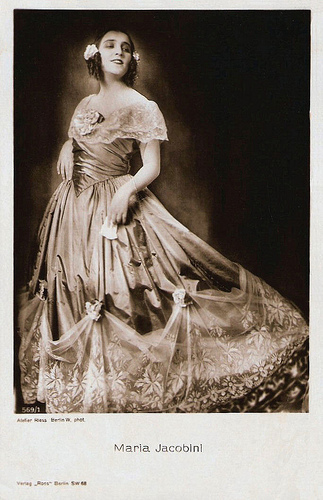
German postcard by Ross Verlag, no. 569/1, 1930-1931. Photo: Atelier Riess, Berlin.
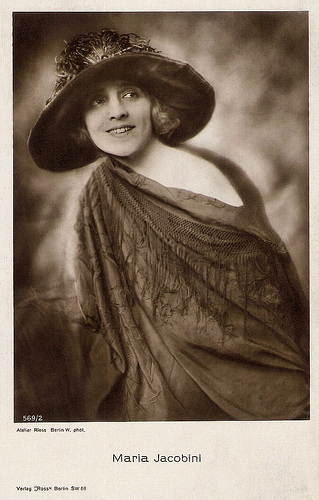
German postcard by Ross Verlag, no. 569/2, 1919-1924. Photo: Atelier Riess, Berlin.
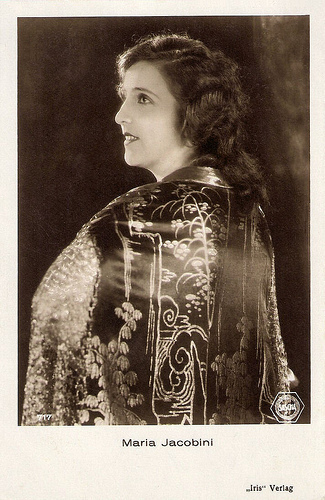
Austrian postcard by Iris Verlag, no. 717. Photo: Sascha Film.
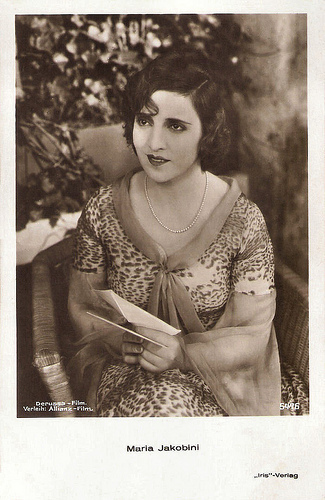
Austrian postcard by Iris Verlag, no. 5476. Photo: Derussa-Film / Allianz-Film.
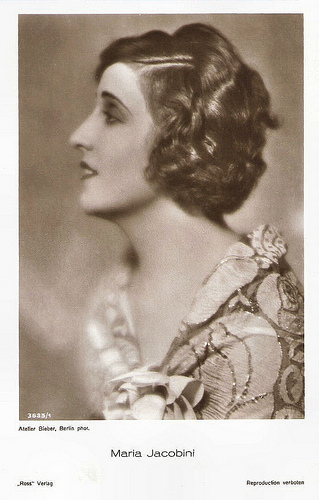
German postcard by Ross Verlag, no. 3635/1, 1928-1929. Photo: Atelier Bieber, Berlin.
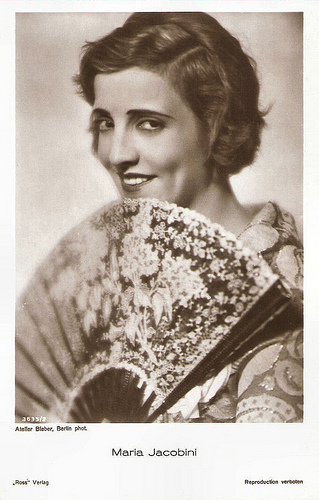
German postcard by Ross Verlag, no. 3635/2, 1928-1929. Photo: Atelier Bieber, Berlin.
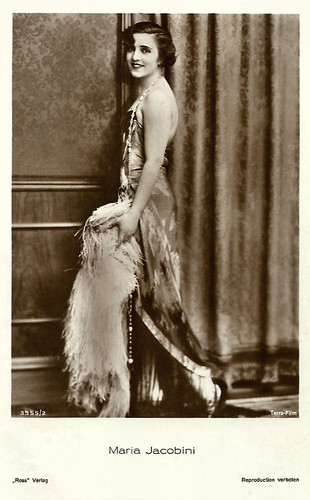
German postcard by Ross Verlag, no. 3955/2, 1928-1929. Photo: Terra-Film.
Sources: Vittorio Martinelli (Le dive del silenzio), Caterina Cerra (Treccani.it - Italian), Wikipedia (English and Italian) and .

Italian postcard by Ed. Vettori, Bologna, no. 346. Sent by mail in 1926. Maria Jacobini in Onestà del Peccato/The Wife He Neglected (Augusto Genina, 1918).

Italian postcard by Milano, Uff. Rev. Stampa, no. 891. Portrait of the actress Maria Jacobini by Tito Corbella.

Italian postcard by Ed. Romeo Biagi, Bologna, no. 649.

Italian postcard by Dist. Ed. SARPIC, Bucarest, Romania, no. 330.

Italian postcard by G.B. Falci Ed. for Unica - Ciocolato Talmone al latte. Photo: Pittaluga Film. Maria Jacobini in Beatrice Cenci (Baldassarre Negroni, 1926).

Italian postcard by Ed. Bettini, Roma, no. 145.

German postcard by Ross Verlag, no. 3953/1, 1928-1929. Photo: Terra-Film.
Seductive man-eater
Maria Jacobini was born in Rome, Italy, in 1892. She was the sister of actress Diomira Jacobini . Their older sister Bianca had also started out as an actress but had interrupted her career after four films. Maria studied at the Accademia di Arte Drammatica di S. Cecilia, where her teachers were Virginia Marini and Eduardo Boutet. She made her stage debut at the company of Cesare Dondini Jr., where she mainly played secondary parts.
She was noticed by Ugo Falena, artistic director of the film company Film d'Arte Italiana. He offered her to work in the silent cinema. Her first short films were Lucrezia Borgia/Lucretia Borgia (Ugo Falena, 1910) featuring diva Francesca Bertini , and Beatrice Cenci (Ugo Falena, 1910), but her first important role was in Cesare Borgia (Gerolamo Lo Savio, 1912) again starring Bertini.
In 1912, Maria started to work at the Savoia company of Turin, as a seductive man-eater in short films like Pantera/Panther (1912), La zingara/The Gypsy (Sandro Camasio, 1912), and L'onta nascosta/The Hidden Shame (1912).
From 1913 on, she played her more dramatic roles as the lead in Giovanna d'Arco/Joan of Arc (Ubaldo Maria del Colle, 1913) and Ananke (Nino Oxilia, 1915) with Leda Gys and her sister Diomira Jacobini .
Jacobini worked for pioneering film studios like Pasquali and Celio. Maria gave good performances in the melancholic Come le foglie/Like the Leaves (Gennaro Righelli, 1916) based on Giuseppe Giacosa's stage play, and in the touching Addio Giovinezza/Good-bye Youth (Augusto Genina, 1918). She made a series of films with director Gennaro Righelli such as Il viaggio/The Journey (1921), based on a novel by Luigi Pirandello, and Cainà - la figlia dell'isola/Cainà - the Daughter of the Island (1923), shot in Sardinia.

Italian postcard by Ed. A. Traldi, Milano, no. 713.

Italian postcard. Photo: Tiber Film. Publicity still for Come le foglie/Like the Leaves (Gennaro Righelli, 1917), based on the stage play by Giuseppe Giacosa. Father Giovanni ( Ignazio Lupi ) unites his daughter Nennele (Maria Jacobini) with his cousin Massimo (Guido Guiducci). Translation caption: Nennele: Shall I call him? Massimo! Content of the film: After a life of spendthrifts, the Rosati family is ruined. Father Giovanni ( Ignazio Lupi ) accepts work from his cousin Massimo (Guido Guiducci). Hitherto neglected as too serious and workaholic, Massimo becomes the head of the family and takes care of the son and daughter of Giovanni, Tommy ( Alberto Collo ) and Nennele (Jacobini), and their stepmother Giulia (Floriana). Tommy and Giulia remain weak spirits, but after an attempted suicide, Nennele realises Massimo's force and unites with him.

Italian postcard. Photo: Tiber Film, Roma. Publicity still for Come le foglie/Like the Leaves (Gennaro Righelli, 1917). Maria Jacobini (Nennele) and Alberto Collo (Tommy). Translation caption: Nennele: You don't know what you're saying! Farewell, Tommy, farewell, poor Tommy!

Italian postcard. Photo: Tiber Film, Roma. Publicity still for Come le foglie/Like the Leaves (Gennaro Righelli, 1917). Left Maria Jacobini. The man in the middle could be Guido Guiducci. Translation caption: The portrait slipped from the package and fell to the ground.

Italian postcard. Photo: Tiber Film, Roma. Maria Jacobini and Ignazio Lupi in the Italian silent film Come le foglie/Like the Leaves (Gennaro Righelli, 1917), based on the stage play by Giuseppe Giacosa. The caption translates: 'Giovanni: And tomorrow I would have been out in the world, shouting like a madman, searching for my little daughter'.

Dutch postcard by E & B, no. 518. Photo: HAP Film, Den Haag / Bens Film. Possibly this card uses a still from L'onestà del peccato/La fine di un vile/The Wife He Neglected (Augusto Genina, 1918), in which Jacobini wears a similar dress. The film was restored by the Museo Nazionale del Cinema in Turin and shown at the Cinema Ritrovato Festival in Bologna in 2017.

Italian postcard by Ed. G.B. Falci, Milano, no. 101. Maria Jacobini and Lido Manetti in Il richiamo/The Call (Gennaro Righelli, 1921).

Spanish collector card in the Escenas selectas de cinematografia series. Maria Jacobini in La Bohème/Boheme - Künstlerliebe (Gennaro Righelli, 1923), based on the novel by Henri Murger, which later was turned into an opera by Giacomo Puccini.

German postcard by Ross Verlag for Trianon Film-Verleih G.m.b.H., Berlin. Phot: Walter Lichtenstein. Maria Jacobini as Katja in Orient - Die Tochter der Wüste/Orient (Gennaro Righelli, 1924).

Italian postcard by G.B. Falci, Milano, no. 348. Maria Jacobini in the silent film La bocca chiusa (Guglielmo Zorzi, 1925).
Berlin
After the First World War, the Italian film industry was in a deep crisis, and director Gennaro Righelli and his star Maria Jacobini decided to move to Germany.
In Berlin, the new centre of the European film industry, Jacobini and Righelli were enlisted by producer Jakob Karoll and they founded a separate company called Maria Jacobini GmbH.
Jacobini first starred in Bohème - Künstlerliebe/Bohème - Artists Love (Gennaro Righelli, 1923), playing the tormented and suffering Mimi. Her film partner was Wilhelm Dieterle , who would later become known as Hollywood director William Dieterle.
She often performed in Righelli's German films and other directors' films. She was directed by Jaap Speyer in Bigamie/Bigamy (1927), Robert Dinesen in Ariadne im Hoppegarten (1928) with Alfred Abel , Richard Oswald in Villa Falconieri (1928) opposite Hans Stüwe , and by Fedor Ozep in the German-Russian coproduction Der lebende Leichnam/Zhivoy trup/The Living Corpse (1929), based on the play by Leo Tolstoy.
These productions were shot all over Europe, and Jacobini even filmed in Africa for Die Frauengasse von Algier/The Street of Women of Algiers (Wolfgang Hoffmann-Harnisch, 1927) with Camilla Horn .

Italian postcard, no. 430. Photo: Maria Jacobini and Lido Manetti in the silent film Addio giovinezza/Goodbye Youth (Augusto Genina, 1918), an adaptation of the play by Sandro Camasio and Nino Oxilia.

Italian postcard, no. 431. Photo: Maria Jacobini and Lido Manetti in the silent film Addio giovinezza/Good-Bye Youth (Augusto Genina, 1918).

Italian postcard by G.B. Falci, Milano. Photo: Maria Jacobini and Amleto Novelli in La preda/The Prey (Guglielmo Zorzi, 1921).

Italian postcard by Ed. Vettori, Bologna. Photo: probably publicity still for L'articolo IV (Gennaro Righelli, 1918) in which Jacobini and Tullio Carminati were the leading actors. The film is about Duchess Jenny who offers her hand to the only man who didn't court her, the Count d'Hauteville. She has a condition, though: for a long time the two must first live together as mere friends and if they don't get along they will divorce. Will both keep this promise? The card suggests otherwise...

Italian postcard by G.B. Falci, Milano, no. 13. Photo: Maria Jacobini and Amleto Novelli in La casa di vetro/The Glass House (Gennaro Righelli, 1920).

Italian postcard by G.B. Falci, Milano. Photo: publicity still for La casa di vetro/The Glass House (Gennaro Righelli, 1920) with Jacobini and Amleto Novelli .

Italian postcard by G.B. Falci, Milano, no. 92. Photo: publicity still for Il richiamo/The Call (Gennaro Righelli, 1921).

Italian postcard by G.B. Falci, Milano, no. 67. Publicity still of Maria Jacobini and Lido Manetti in Il richiamo/The Call (Gennaro Righelli, 1921). A print of this film is in the Komiya Collection at the National Film Center in Tokyo. A restored version was shown at the last edition of the festival Cinema Ritrovato in Bologna (June/July 2012).

Italian postcard. Photo: publicity still for La via del peccato (Amleto Palermi, 1925).

Italian postcard by G.B. Falci, Milano. Photo: Maria Jacobini in La bocca chiusa/The Closed Mouth (Guglielmo Zorzi, 1925) with Lido Manetti .
Marginal roles
In the second half of the 1920s, Maria Jacobini performed also in a few Italian films such as La bocca chiusa/Shut up (Guglielmo Zorzi, 1925) opposite Lido Manetti a.k.a. Arnold Kent and Carmen Boni , Beatrice Cenci (Baldassarre Negroni, 1926), and Il carnevale di Venezia/The Carnival of Venice (Mario Almirante, 1928).
In France, she did Maman Colibri/Mother Hummingbird (Julien Duvivier, 1929) with Franz Lederer . It was her final silent film.
With the coming of the sound cinema, Jacobini's roles became marginal, though she continued to play in films until her death.
In 1937 she became a teacher in acting at the new Roman film academy Centro Sperimentale di Cinematografia, where she gave lessons to new stars and actresses such as Alida Valli and Clara Calamai .
Her final film was La donna della montagna/The Mountain Woman (Renato Castellani, 1943) with Marina Berti . Maria Jacobini died a year later, in 1944 in Rome. She was 52.

German postcard by Ross Verlag, no. 569/1, 1930-1931. Photo: Atelier Riess, Berlin.

German postcard by Ross Verlag, no. 569/2, 1919-1924. Photo: Atelier Riess, Berlin.

Austrian postcard by Iris Verlag, no. 717. Photo: Sascha Film.

Austrian postcard by Iris Verlag, no. 5476. Photo: Derussa-Film / Allianz-Film.

German postcard by Ross Verlag, no. 3635/1, 1928-1929. Photo: Atelier Bieber, Berlin.

German postcard by Ross Verlag, no. 3635/2, 1928-1929. Photo: Atelier Bieber, Berlin.

German postcard by Ross Verlag, no. 3955/2, 1928-1929. Photo: Terra-Film.
Sources: Vittorio Martinelli (Le dive del silenzio), Caterina Cerra (Treccani.it - Italian), Wikipedia (English and Italian) and .
Published on November 15, 2024 22:00
November 14, 2024
Frank Villard
Moustachioed French actor Frank Villard (1917-1980) was a popular, 'rogue' seducer in French films of the late 1940s and 1950s. He also acted in Italian and Spanish films.
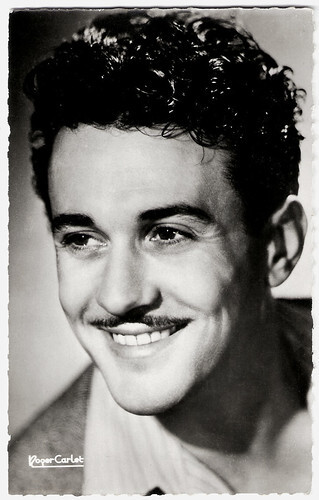
French postcard by Editions du Globe, Paris, no, 114. Photo: Roger Carlet.
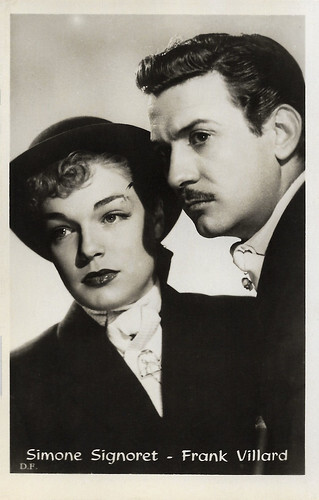
Vintage card by D.F. Simone Signoret and Frank Villard in Manèges//The Cheat (Yves Allégret, 1950).
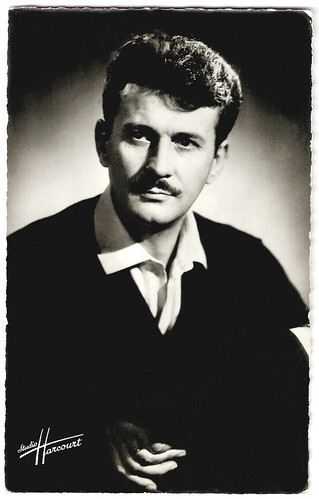
French postcard by Editions du Globe, Paris, no. 241. Photo: Studio Harcourt.
A fashionable seducer
Frank Villard (sometimes Franck Villard) was born François Drouineau in 1917 in Saint-Jean-d'Angély, France. He was the son of a finance inspector, François Étienne Drouineau.
During the Second World War, Frank was taken prisoner of war but was released by feigning madness and epilepsy. He ended up in Nice, where he met the film star Viviane Romance . He began working in the film industry as a painter and set decorator.
Romance arranged his film debut in Cartacalha, reine des gitans (Léon Mathot, 1941). She also cast him in more important roles in her next two films, Feu sacré/Carrière (Maurice Cloche, 1942) and La Boîte aux rêves/Box of Dreams (Yves Allégret, Jean Choux, 1945).
From then on, he appeared regularly in films and became a star with Gigi (Jacqueline Audry, 1949) starring Danièle Delorme and Manèges/The Cheat (Yves Allégret, 1949) with Simone Signoret . These two successes made him a fashionable seducer.
Along with Henri Vidal and Daniel Gélin , he was the prototype of the rogue seducer in French cinema in the 1950s, in contrast to romantic seducers such as Gérard Philipe and Jean-Claude Pascal . Villard also worked, but more occasionally, on stage between 1949 and 1964.
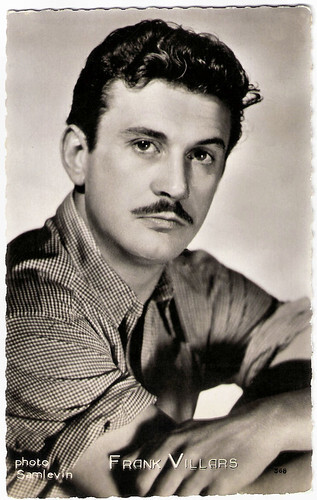
French postcard by Editions P.I., Paris, offered by Les Carbones Korès no. 368. Photo: Sam Lévin. Villard is mistakenly written as Villars.
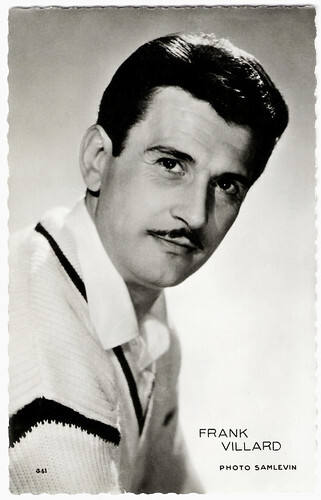
French postcard by Editions P.I., Paris, no. 441. Photo: Sam Lévin.
Apocalypse Now
In 1951, Frank Villard became known throughout Europe. First, he had success with the French-Italian crime film Le Cap de l'Espérance/The Cape of Hope (Raymond Bernard, 1951) starring Edwige Feuillère . His best film was Le Garçon sauvage/Savage Triangle (Jean Delannoy, 1951) with Madeleine Robinson .
He had the opportunity to work alongside actors of the calibre of Jean Gabin , Bernard Blier and Paul Frankeur, achieving perhaps his greatest success in the roles he played under the direction of director Gilles Grangier. Villard made films in Italy such as Wanda la peccatrice/The Shameless Sex (Duilio Coletti, 1952) with Yvonne Sanson, La voce del silenzio/Voice of Silence (G.W. Pabst, 1953) and Le Secret d'Hélène Marimon/The Secret of Helene Marimon (Henri Calef, 1954) starring Isa Miranda .
In Spain, he acted in the Spanish-Italian historical jukebox musical film La Violetera/The Violet Seller (Luis César Amadori, 1958) with Sara Montiel . The Violet Seller received excellent reviews upon its release. It was immensely popular in Spain and it had a wide international release making it the worldwide highest-grossing Spanish-language film made up to that point.
Villard's star began to wane in the early 1960s. After starring in several thrillers including Rapt au Deuxième Bureau/Operation Abduction (Jean Stelli, 1958), with Dalida , he turned to supporting roles in films such as the comedy Le cave se rebiffe/The Counterfeiters of Paris (Gilles Grangier, 1961) and the anthology film Le crime ne paie pas/Gentle Art of Murder (Gérard Oury, 1962).
His last appearance on the big screen was in the American epic war film Apocalypse Now, in the Redux version (2001) and the Final Cut version (2019) directed by Francis Ford Coppola. He also appeared on television and in the theatre. With his wife, a former model, he also ran a restaurant in Saint-Jean-d'Angély, 'Chez Franck Villard'. In the last period of his life, he appeared in some French-produced television series. During a theatre tour in Switzerland, Frank Villard died of a heart attack in 1980 in Geneva. He was 63.
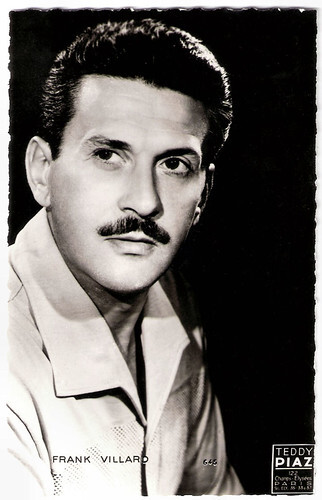
French postcard by Editions P.I., Paris, offered by Korès, no. 645. Photo: Teddy Piaz, Paris.
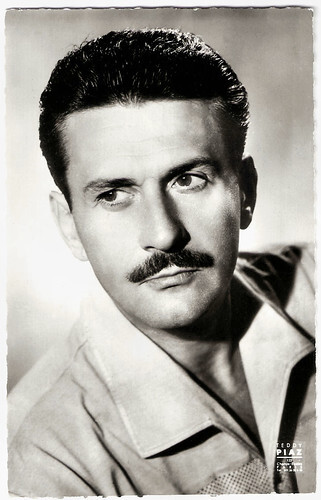
French postcard by Editions du Globe, Paris, no. 397. Photo: Teddy Piaz, Paris.
Sources: Wikipedia (French, English and Italian) and .

French postcard by Editions du Globe, Paris, no, 114. Photo: Roger Carlet.

Vintage card by D.F. Simone Signoret and Frank Villard in Manèges//The Cheat (Yves Allégret, 1950).

French postcard by Editions du Globe, Paris, no. 241. Photo: Studio Harcourt.
A fashionable seducer
Frank Villard (sometimes Franck Villard) was born François Drouineau in 1917 in Saint-Jean-d'Angély, France. He was the son of a finance inspector, François Étienne Drouineau.
During the Second World War, Frank was taken prisoner of war but was released by feigning madness and epilepsy. He ended up in Nice, where he met the film star Viviane Romance . He began working in the film industry as a painter and set decorator.
Romance arranged his film debut in Cartacalha, reine des gitans (Léon Mathot, 1941). She also cast him in more important roles in her next two films, Feu sacré/Carrière (Maurice Cloche, 1942) and La Boîte aux rêves/Box of Dreams (Yves Allégret, Jean Choux, 1945).
From then on, he appeared regularly in films and became a star with Gigi (Jacqueline Audry, 1949) starring Danièle Delorme and Manèges/The Cheat (Yves Allégret, 1949) with Simone Signoret . These two successes made him a fashionable seducer.
Along with Henri Vidal and Daniel Gélin , he was the prototype of the rogue seducer in French cinema in the 1950s, in contrast to romantic seducers such as Gérard Philipe and Jean-Claude Pascal . Villard also worked, but more occasionally, on stage between 1949 and 1964.

French postcard by Editions P.I., Paris, offered by Les Carbones Korès no. 368. Photo: Sam Lévin. Villard is mistakenly written as Villars.

French postcard by Editions P.I., Paris, no. 441. Photo: Sam Lévin.
Apocalypse Now
In 1951, Frank Villard became known throughout Europe. First, he had success with the French-Italian crime film Le Cap de l'Espérance/The Cape of Hope (Raymond Bernard, 1951) starring Edwige Feuillère . His best film was Le Garçon sauvage/Savage Triangle (Jean Delannoy, 1951) with Madeleine Robinson .
He had the opportunity to work alongside actors of the calibre of Jean Gabin , Bernard Blier and Paul Frankeur, achieving perhaps his greatest success in the roles he played under the direction of director Gilles Grangier. Villard made films in Italy such as Wanda la peccatrice/The Shameless Sex (Duilio Coletti, 1952) with Yvonne Sanson, La voce del silenzio/Voice of Silence (G.W. Pabst, 1953) and Le Secret d'Hélène Marimon/The Secret of Helene Marimon (Henri Calef, 1954) starring Isa Miranda .
In Spain, he acted in the Spanish-Italian historical jukebox musical film La Violetera/The Violet Seller (Luis César Amadori, 1958) with Sara Montiel . The Violet Seller received excellent reviews upon its release. It was immensely popular in Spain and it had a wide international release making it the worldwide highest-grossing Spanish-language film made up to that point.
Villard's star began to wane in the early 1960s. After starring in several thrillers including Rapt au Deuxième Bureau/Operation Abduction (Jean Stelli, 1958), with Dalida , he turned to supporting roles in films such as the comedy Le cave se rebiffe/The Counterfeiters of Paris (Gilles Grangier, 1961) and the anthology film Le crime ne paie pas/Gentle Art of Murder (Gérard Oury, 1962).
His last appearance on the big screen was in the American epic war film Apocalypse Now, in the Redux version (2001) and the Final Cut version (2019) directed by Francis Ford Coppola. He also appeared on television and in the theatre. With his wife, a former model, he also ran a restaurant in Saint-Jean-d'Angély, 'Chez Franck Villard'. In the last period of his life, he appeared in some French-produced television series. During a theatre tour in Switzerland, Frank Villard died of a heart attack in 1980 in Geneva. He was 63.

French postcard by Editions P.I., Paris, offered by Korès, no. 645. Photo: Teddy Piaz, Paris.

French postcard by Editions du Globe, Paris, no. 397. Photo: Teddy Piaz, Paris.
Sources: Wikipedia (French, English and Italian) and .
Published on November 14, 2024 22:00
November 13, 2024
Wanda Hawley
Wanda Hawley (1895-1963) was an American silent film actress and singer. She began film work in 1917 and appeared in more than 80 films over the next 15 years. Hawley rose to stardom in films by Cecil B. DeMille and Sam Wood, and co-starred with Rudolph Valentino in The Young Rajah (1922). Her career ended in the early 1930s.
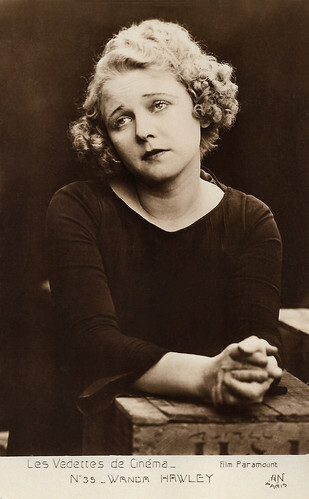
French postcard in the Les Vedettes de Cinéma series by A.N., Paris, no. 35. Photo: Film Paramount.
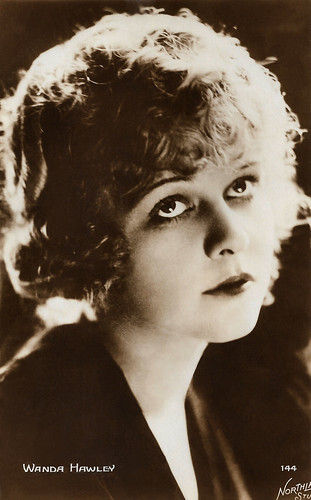
French postcard by Editions Cinémagazine, no. 144. Photo: Northland Studio.
Cecil B. DeMille and William C. deMille
Wanda Hawley was born Selma Wanda Pittack in Scranton, Pennsylvania in 1895. Her family moved to Seattle, Washington, when she was a child. She received her education in Seattle. She entered the stage with an amateur group in Seattle and later toured the United States and Canada as a singer. Due to her petite status, she billed herself as Wanda Petit for a brief period in her career till her marriage to Allen Burton Hawley in 1916 and adopted his surname professionally.
She made her screen debut with the Fox Film Corporation in the drama The Heart of a Lion (Frank Lloyd, 1917) starring William Farnum . In 1918 she moved to Famous Players-Lasky and appeared as the leading lady in the Douglas Fairbanks comedy Mr. Fix-It (Allan Dwan, 1918). At Famous Players/Paramount, she was the leading lady of William S. Hart in the Western The Border Wireless (Willam S. Hart, 1918) and of Charles Ray in the comedy Greased Lightning (Jerome Storm, 1919).
She co-starred with Rudolph Valentino in The Young Rajah (Phil Rosen, 1922). It was one of Valentino's most commercially and critically unsuccessful films. The film is best remembered today for its elaborate and suggestive costumes, designed by Valentino's wife Natacha Rambova. With Bryant Washburn , she costarred in the films The Gypsy Trail (Walter Edwards, 1918), The Way of a Man with a Maid (Donald Crisp, 1918), The Poor Boob (Donald Crisp, 1919), The Six Best Cellars (Donald Crisp, 1920) and Mrs. Temple's Telegram (James Cruze, 1920).
Wanda Hawley also played opposite idol Wallace Reid in the comedies You're Fired (James Cruze, 1919), The Lottery Man (James Cruze, 1919) also with Harrison Ford , Double Speed (Allan Dwan - in his debut, 1920) and Thirty Days (James Cruze, 1922). Thirty Days was Wallace Reid 's last film. Reviews of the film claimed the dating daredevil looked tired and haggard throughout the production and the film garnered generally bad reviews. On 18 January 1923, Reid died from influenza in a sanatorium, aged 31, while attempting to recover from a morphine addiction. Like many other films with Reid - and Hawley - Thirty Days is now considered a lost film.
Cecil B. DeMille directed her in Old Wives For New (1918) with Elliott Dexter, We Can't Have Everything (1918), For Better, for Worse (1919) with Gloria Swanson , and The Affairs of Anatol (1921) starring Swanson and Wallace Reid . She also worked with Cecil's brother William C. deMille on the drama The Tree of Knowledge (William C. deMille, 1920) starring Robert Warwick. In 1919, she also worked with William C. deMille on the film Peg O'My Heart, but it was never released because of a dispute with the author of the novel on which the film was based, J. Hartley Manners. In 1922 Metro Pictures (the future MGM) would release a version with Laurette Taylor in the title role. In 1933, MGM released a sound version with Marion Davies .
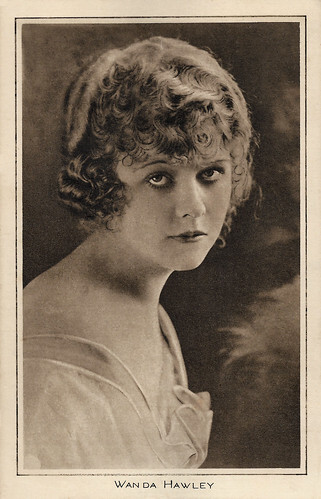
British postcard in the 'Pictures' Portrait Gallery series by Pictures Ltd., London, no. 9/191. Sent by mail in 1922.
A dispute at Paramount
In 1923 Wanda Hawley left Paramount, after having acted there in 8 to 10 films a year in the years 1918-1922. IMDb mentions there was a dispute. That year, Hawley acted in the British-American adventure film Fires of Fate/Desert Sheik (Tom Terriss, 1923) with Nigel Barrie and adapted from Arthur Conan Doyle, and the British drama Lights of London (Charles Calvert, 1923), again with Barrie.
When she returned to Hollywood, Hawley worked for various companies: Vitagraph, Fox, MGM, First National, Universal and smaller companies. By the mid-1920s Hawley alternated supporting parts in films with stars such as Graustark (Dimitri Buchowetzki, 1925) starring Norma Talmadge and Smouldering Fires (Clarence Brown, 1925) starring Pauline Frederick with female leads in Westerns and aviation stunt films with William Farnum and stunt man and pilot Richard Grace.
The last female lead Hawley had in Eyes of the Totem (W.S. Van Dyke, 1927) with Tom Santschi, shot in and around the city of Tacoma. The plot of the - still-surviving - film deals with the wife of a miner, who moves to the city (Tacoma) when her husband has sold his claim. Upon reaching the city, the man is murdered and the cash is stolen by a mysterious steely-eyed stranger. Left penniless with a small child to care for, Mariam becomes a beggar. Over the years she becomes a respectable member of society, but she always keeps a watch for the eyes of the murderer. A chance encounter reveals his identity, leading to a violent confrontation.
With the advent of sound, Hawley's film career largely ended. Her last film was The Crooked Road (?, 1932). By late 1931, she was working for a cosmetic company. Later, she demonstrated and sold dresses in a department store in Tacoma, Washington.
Wanda Hawley married Allen Burton Hawley in 1916. After Hawley died in 1925, Wanda married the same year to Jay Wilkinson, but left him in 1928, when he refused to continue touring as an actor with her. They divorced in 1933. In 1938, Hawley married Jack Richey in Roosevelt County, New Mexico. She and Jack were travelling in Boise when he died of a heart attack in 1957. Wanda Hawley died in 1963 in Los Angeles. She is interred in the Abbey of Psalms in the Hollywood Forever Cemetery in Hollywood, CA.
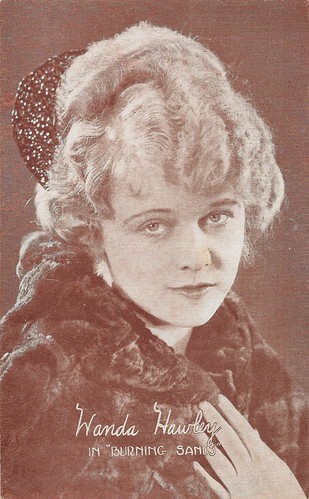
American postcard. Photo: Paramount. Wanda Hawley in Burning Sands (George Melford, 1922).
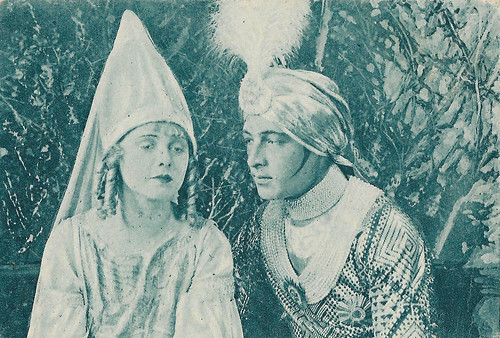
Spanish collector card by Chocolate Amatller, Barcelona, no. 13. Photo: Paramount. Rudolph Valentino and Wanda Hawley in The Young Rajah (Phil Rosen, 1922).
Sources: Hawley Society, Silent Era, Wikipedia (Dutch and English) and .

French postcard in the Les Vedettes de Cinéma series by A.N., Paris, no. 35. Photo: Film Paramount.

French postcard by Editions Cinémagazine, no. 144. Photo: Northland Studio.
Cecil B. DeMille and William C. deMille
Wanda Hawley was born Selma Wanda Pittack in Scranton, Pennsylvania in 1895. Her family moved to Seattle, Washington, when she was a child. She received her education in Seattle. She entered the stage with an amateur group in Seattle and later toured the United States and Canada as a singer. Due to her petite status, she billed herself as Wanda Petit for a brief period in her career till her marriage to Allen Burton Hawley in 1916 and adopted his surname professionally.
She made her screen debut with the Fox Film Corporation in the drama The Heart of a Lion (Frank Lloyd, 1917) starring William Farnum . In 1918 she moved to Famous Players-Lasky and appeared as the leading lady in the Douglas Fairbanks comedy Mr. Fix-It (Allan Dwan, 1918). At Famous Players/Paramount, she was the leading lady of William S. Hart in the Western The Border Wireless (Willam S. Hart, 1918) and of Charles Ray in the comedy Greased Lightning (Jerome Storm, 1919).
She co-starred with Rudolph Valentino in The Young Rajah (Phil Rosen, 1922). It was one of Valentino's most commercially and critically unsuccessful films. The film is best remembered today for its elaborate and suggestive costumes, designed by Valentino's wife Natacha Rambova. With Bryant Washburn , she costarred in the films The Gypsy Trail (Walter Edwards, 1918), The Way of a Man with a Maid (Donald Crisp, 1918), The Poor Boob (Donald Crisp, 1919), The Six Best Cellars (Donald Crisp, 1920) and Mrs. Temple's Telegram (James Cruze, 1920).
Wanda Hawley also played opposite idol Wallace Reid in the comedies You're Fired (James Cruze, 1919), The Lottery Man (James Cruze, 1919) also with Harrison Ford , Double Speed (Allan Dwan - in his debut, 1920) and Thirty Days (James Cruze, 1922). Thirty Days was Wallace Reid 's last film. Reviews of the film claimed the dating daredevil looked tired and haggard throughout the production and the film garnered generally bad reviews. On 18 January 1923, Reid died from influenza in a sanatorium, aged 31, while attempting to recover from a morphine addiction. Like many other films with Reid - and Hawley - Thirty Days is now considered a lost film.
Cecil B. DeMille directed her in Old Wives For New (1918) with Elliott Dexter, We Can't Have Everything (1918), For Better, for Worse (1919) with Gloria Swanson , and The Affairs of Anatol (1921) starring Swanson and Wallace Reid . She also worked with Cecil's brother William C. deMille on the drama The Tree of Knowledge (William C. deMille, 1920) starring Robert Warwick. In 1919, she also worked with William C. deMille on the film Peg O'My Heart, but it was never released because of a dispute with the author of the novel on which the film was based, J. Hartley Manners. In 1922 Metro Pictures (the future MGM) would release a version with Laurette Taylor in the title role. In 1933, MGM released a sound version with Marion Davies .

British postcard in the 'Pictures' Portrait Gallery series by Pictures Ltd., London, no. 9/191. Sent by mail in 1922.
A dispute at Paramount
In 1923 Wanda Hawley left Paramount, after having acted there in 8 to 10 films a year in the years 1918-1922. IMDb mentions there was a dispute. That year, Hawley acted in the British-American adventure film Fires of Fate/Desert Sheik (Tom Terriss, 1923) with Nigel Barrie and adapted from Arthur Conan Doyle, and the British drama Lights of London (Charles Calvert, 1923), again with Barrie.
When she returned to Hollywood, Hawley worked for various companies: Vitagraph, Fox, MGM, First National, Universal and smaller companies. By the mid-1920s Hawley alternated supporting parts in films with stars such as Graustark (Dimitri Buchowetzki, 1925) starring Norma Talmadge and Smouldering Fires (Clarence Brown, 1925) starring Pauline Frederick with female leads in Westerns and aviation stunt films with William Farnum and stunt man and pilot Richard Grace.
The last female lead Hawley had in Eyes of the Totem (W.S. Van Dyke, 1927) with Tom Santschi, shot in and around the city of Tacoma. The plot of the - still-surviving - film deals with the wife of a miner, who moves to the city (Tacoma) when her husband has sold his claim. Upon reaching the city, the man is murdered and the cash is stolen by a mysterious steely-eyed stranger. Left penniless with a small child to care for, Mariam becomes a beggar. Over the years she becomes a respectable member of society, but she always keeps a watch for the eyes of the murderer. A chance encounter reveals his identity, leading to a violent confrontation.
With the advent of sound, Hawley's film career largely ended. Her last film was The Crooked Road (?, 1932). By late 1931, she was working for a cosmetic company. Later, she demonstrated and sold dresses in a department store in Tacoma, Washington.
Wanda Hawley married Allen Burton Hawley in 1916. After Hawley died in 1925, Wanda married the same year to Jay Wilkinson, but left him in 1928, when he refused to continue touring as an actor with her. They divorced in 1933. In 1938, Hawley married Jack Richey in Roosevelt County, New Mexico. She and Jack were travelling in Boise when he died of a heart attack in 1957. Wanda Hawley died in 1963 in Los Angeles. She is interred in the Abbey of Psalms in the Hollywood Forever Cemetery in Hollywood, CA.

American postcard. Photo: Paramount. Wanda Hawley in Burning Sands (George Melford, 1922).

Spanish collector card by Chocolate Amatller, Barcelona, no. 13. Photo: Paramount. Rudolph Valentino and Wanda Hawley in The Young Rajah (Phil Rosen, 1922).
Sources: Hawley Society, Silent Era, Wikipedia (Dutch and English) and .
Published on November 13, 2024 22:00
November 12, 2024
Ross Verlag, Part 10: Das Programm Von Heute
In our Ross Verlag tribute, we focus today on an unnumbered series of Ross postcards that say 'Das Programm von Heute' (The Program for Today) on the back and sometimes the front. These postcards were made of a cheaper brown paper and were issued as part of film programs by 'Das Programm von Heute', Zeitschrift für Film und Theater G.m.b.H. The cards were inserted in slots on the front of the programs. Of the 730 cards that are known, we selected 25 items from our collections.
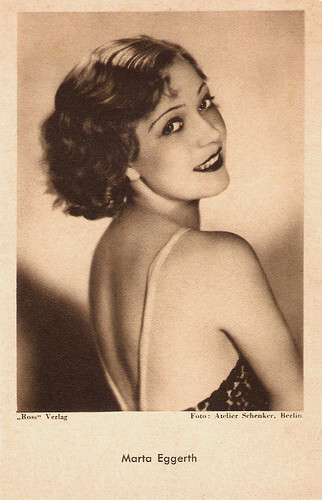
German postcard by Das Programm von Heute / Ross Verlag. Photo: Atelier Schenker, Berlin. Hungarian-born singer and actress Márta Eggerth (1912-2013) maintained a global career for over 70 years. She was the popular and talented star of 30 German and Austrian operetta films of the 1930s. Many of the 20th century's most famous operetta composers, including Franz Lehár, Fritz Kreisler, Robert Stolz, Oscar Straus, and Paul Abraham, composed works especially for her. After the rise of the Nazis, she continued her career with her partner Jan Kiepura in the US.
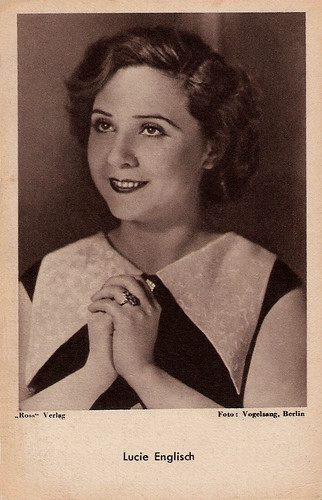
German postcard by Das Programm von Heute / Ross Verlag. Photo: Vogelsang, Berlin. Popular Austrian folk actress Lucie Englisch (1902-1965) played both leading and supporting roles on stage, in films, and on television. As the native girl with a loose tongue, she was seen in countless comedies, in both leading and supporting parts.
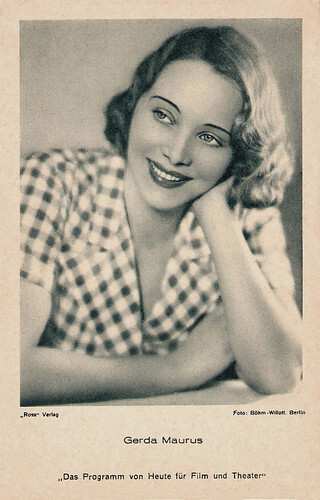
German postcard by Das Programm von Heute / Ross Verlag, Berlin. Photo: Böhm-Willott, Berlin. Collection: Miss Mertens. Austrian actress Gerda Maurus (1903-1968) was a star of the silent screen. With her protruded cheekbones and her forceful look, she bewitched many men, including her director Fritz Lang and Nazi Minister Josef Goebbels.
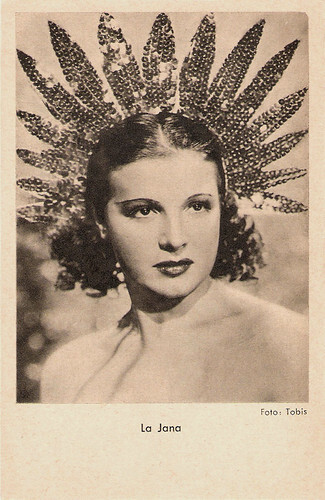
German postcard by Das Programm von Heute / Ross Verlag. Photo: Tobis. Sexy German dancer and film actress La Jana (1905-1940) was the most popular showgirl in Berlin in the 1930s. She appeared in 25 European films, often dancing in exotic costumes. In 1940, she suddenly died of pneumonia and pleurisy.
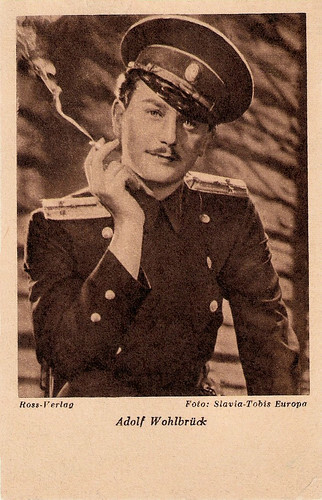
German postcard by Das Programm von Heute / Ross Verlag. Photo: Slavia - Tobis Europa. Adolf Wohlbrück in Port Arthur (Nicolas Farkas, 1936). Dark and handsome Adolf Wohlbrück (1896-1967) a.k.a. Anton Walbrook was a distinguished Austrian actor who starred in early German sound films as Walzerkrieg (1933) and Viktor und Viktoria (1933). After the rise of Hitler, he settled in Great Britain where he appeared in such film classics as The Life and Death of Colonel Blimp (1943) and The Red Shoes (1948). He also played the ringmaster in La Ronde (1950).
The Program for Today
A 'Das Programm von Heute', Zeitschrift für Film und Theater (The Program for Today. Newspaper for Film and Theatre) was 6 pages long (2×3 (contiguous) pages), in the format of 20.5 x 25 cm (8 x 10 inch). The programs were numbered and went far above 500.
In addition to general information about each film (director, screenplay, music, sound, editing, actors, etc.), the content of the film was described in text and numerous pictures.
The series focused on German and Austrian films but also included French, Italian and American films and Hollywood stars.
The programs were published by ‘Zeitschrift für Film und Theater GmbH’ in Frankfurt/M. Sometimes Berlin or Stuttgart is given as the location of the publisher.
The programs and cards were issued between 1934 and 1939. Eventually, the programs were reduced in size, and instead of including a postcard with each edition, a facsimile of one was printed right on the cover.
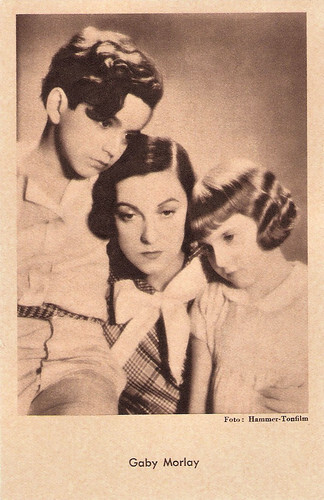
German postcard by Das Programm von Heute / Ross Verlag. Photo: Hammer-Tonfilm. Gaby Morlay in Le scandale/The Scandal (Marcel L'Herbier, 1934) with Mircha and Gaby Triquet. Gaby Morlay (1893-1964) was a French actress with a long-standing career, playing in over 100 films. She compensated her small size (1.53 m.) with passion and enthusiasm.
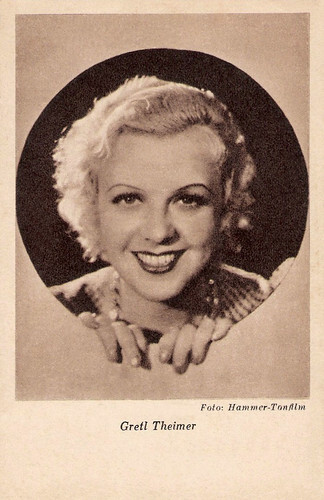
German postcard by Das Programm von Heute / Ross Verlag. Photo: Hammer-Tonfilm. Blonde Austrian actress and singer Gretl Theimer (1911-1972) arrived in the German cinema with the sound film and had an impressive career in the 1930s.
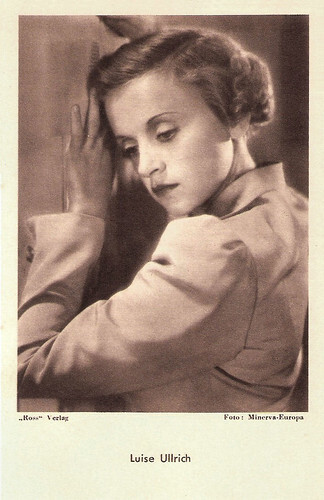
German postcard by Das Programm von Heute / Ross Verlag. Photo: Minerva-Europa. Luise Ullrich in Viktoria/The Love of a Lady (Carl Hoffmann, 1935). Austrian actress Luise Ullrich (1910-1985) starred in many German films of the 1930s, 1940s and 1950s. No German star played self-sacrificing womanhood better than the blond actress and her film Annelie (1941), became the main morale-booster of World War II Germany.
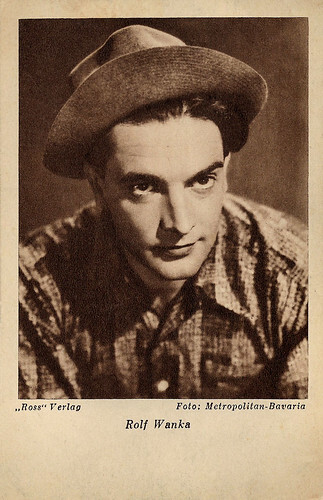
German postcard by Das Programm von Heute / Ross Verlag. Photo: Metropolitan / Bavaria. Rolf Wanka in Rote Rosen - blaue Adria/Red Roses - Blue Adriatic (Jan Sviták, 1938). Austrian actor Rolf Wanka (1901-1982) was a handsome, suave star of the European cinema of the 1930s and the 1950s. He often played supporting parts as a well-dressed, dignified gentleman, and appeared in more than 100 films and television shows between 1931 and 1976.
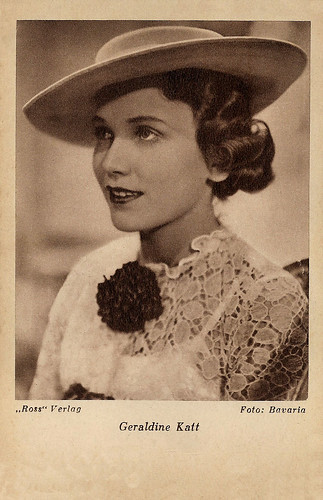
German postcard by Das Programm von Heute, Berlin / Ross Verlag. Photo: Bavaria. Geraldine Katt in Die Stimme des Herzens/The Voice of the Heart (Karlheinz Martin, 1937). Geraldine Katt (1920-1995) was an Austrian actress, who was seen in romantic comedies and melodramas of the 1930s and 1940s. She appeared in more than ten films from 1936 to 1951.
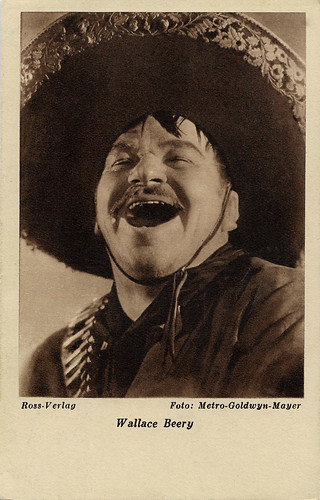
German postcard by Das Programm von Heute, Berlin / Ross Verlag. Photo: Metro Goldwyn Mayer. Wallace Beery in Viva Villa! (Jack Conway, 1934). American actor Wallace Beery (1885-1949) is best known for his portrayal of Bill in Min and Bill opposite Marie Dressler, as Long John Silver in Treasure Island, as Pancho Villa in Viva Villa!, and his titular role in The Champ, for which he won the Academy Award for Best Actor. Beery appeared in some 250 films in a 36-year career. He was the brother of actor Noah Beery, Sr. and uncle of actor Noah Beery, Jr.
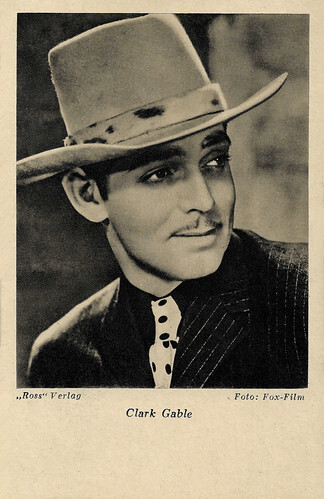
German postcard by Das Programm von Heute / Ross Verlag. Photo: Fox-Film. Clark Gable in Call of the Wild (William A. Wellman, 1935). With his natural charm and knowing smile, Clark Gable (1901-1959) was 'The King of Hollywood' during the 1930s. He often portrayed down-to-earth, bravado characters with a carefree attitude, and was seen as the epitome of masculinity. Gable won an Academy Award for Best Actor for It Happened One Night (1934), and was nominated for his leading role in Mutiny on the Bounty (1935) and for his best-known role, Rhett Butler in Gone with the Wind (1939).
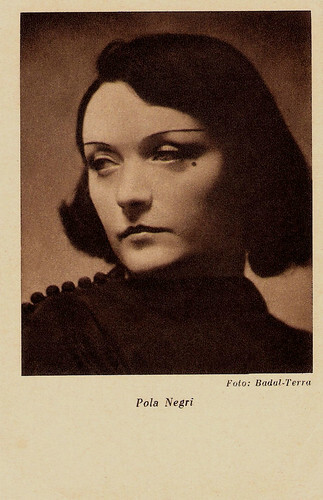
German postcard by Das Programm von Heute, Berlin / Ross Verlag. Photo: Badal / Terra. Pola Negri in Der Weg nach Shanghai/Moskou Shanghai (Paul Wegener, 1936). Polish film actress Pola Negri (1897-1987) achieved notoriety as a femme fatale in German and American silent films between the 1910s and 1930s. In the late 1910s and the 1920s, she achieved notoriety as a femme fatale in silent films in Poland, Berlin, and Hollywood. Negri was an overnight sensation in Ernst Lubitsch's Madame du Barry/Passion (1919). Her vamp roles were so popular that she was a direct rival of Theda Bara, and lived in a Hollywood palace, modelled after the White House.
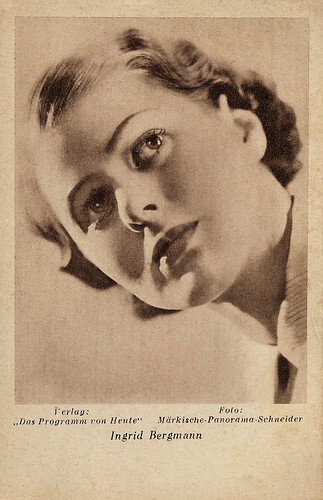
German postcard by Das Programm von Heute, Berlin / Ross Verlag. Photo: Märkische / Panorama / Schneider. Ingrid Bergman in Die 4 Gesellen/The Four Companions (Carl Froelich, 1938). Ingrid Bergman (1915-1982) was ‘Sweden's illustrious gift to Hollywood’. In the 1940s the fresh and naturally beautiful actress won three times the Oscar, twice the Emmy, and once the Tony Award for Best Actress. Little known is that before she went to Hollywood she already had a European film career.
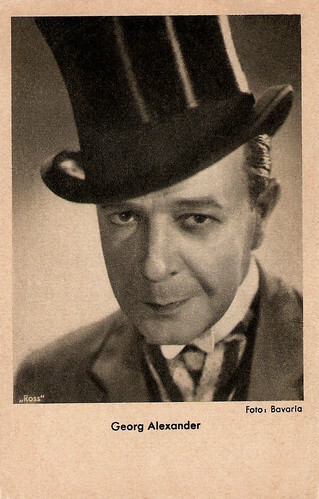
German postcard by Das Programm von Heute / Ross Verlag. Photo: Terra-Sandau. Georg Alexander (1888-1945) was a German actor, director and producer. He belongs to the busiest actors and his career continued smoothly till his death.
Cheaper paper
The Das Programm Von Heute postcards were made of cheaper paper than for example the Ross Verlag postcards. The cards were given away free as an insert in 'Das Programm von Heute. Zeitschrift fur Film und Theater'. The card size was 9 x 14 cm (3.5 x 5.5 inch). Over 730 unnumbered cards are known, with up to 8 different fronts and backs. The Ross Postcards website offers an overview.
The postcards were in black and white or in single-color tints. There were 5 different single-colour shades: grey-black, blue-black, brown, violet-brown and dark green. The cards were printed with "Ross Verlag" in many different styles, until the name disappeared off of the cards altogether, probably after the company was taken over by the National Socialists.
Most stars in the series are German or Austrian, but the likes of Greta Garbo , Clark Gable , Jean Harlow , Wallace Beery and Shirley Temple also get a look in, often with multiple cards. There were also French and Italian stars pictured. The young pre-Hollywood Ingrid Bergman was pictured on one of the cards when she starred in the German film Die 4 Gesellen/The Four Companions (Carl Froelich, 1938).
There were also postcard albums designed solely for storing these cards. Issued over 6 years, there were many different variations of the album. The cover was either silver, beige, or grey, with album pages yellow-white or dark grey. The album title was always in blue. Backs with either "Das Programm von Heute, Zeitschrift für Film und Theater G.m.b.H., Berlin S.W. 11, Dessauerstr. 7" or "Das Programm von Heute für Film und Theater G.m.b.H. Stuttgart".
All were slot-in albums with either 96 or (much rarer) 104 spaces. Albums with 104 spaces came in the following variations: The cover was either silver or beige, with album pages yellow-white or dark grey. The album title was either in blue or red. Backs with either "Das Programm von Heute, Zeitschrift für Film und Theater G.m.b.H. Stuttgart" or "Das Programm von Heute für Film und Theater G.m.b.H. Stuttgart". Because pages were blank, any postcard could be slotted in anywhere. You often find albums with postcards from other sources, such as Ross Verlag or Eidelstedter Margarine (Eidelsan).
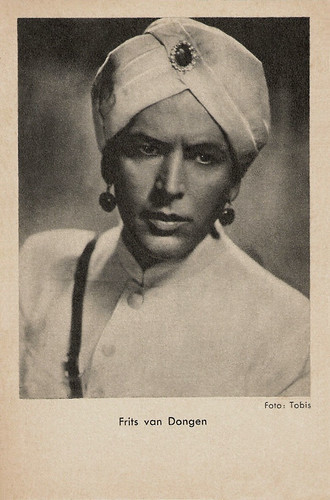
German postcard by Das Programm von Heute / Ross Verlag. Photo: Tobis. Frits van Dongen in Der Tiger von Eschnapur/Das Indische Grabmal (Richard Eichberg, 1938). With this film, Van Dongen had his breakthrough as Maharaja Chandra. Handsome, deep-voiced leading man Frits van Dongen (1901-1975) was one of the first Dutch Hollywood stars. He started his film career in the Netherlands, and in the mid-1930s he became a matinee idol in the German cinema. From 1940 on, he worked in Hollywood, billed as Philip Dorn. A freak accident caused him to retire in 1955.
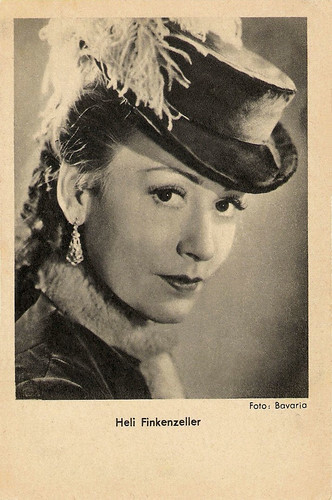
German postcard by Das Programm von Heute / Ross Verlag. Photo: Bavaria/Ross Verlag. German stage and film actress Heli Finkenzeller (1914-1991) had her greatest successes in popular Ufa comedies of the 1930s and 1940s. After the war, she often played mother roles.
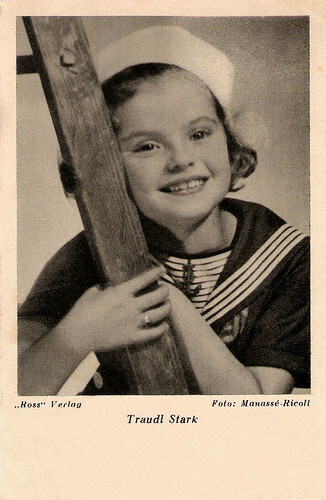
German postcard by Das Programm von Heute / Ross Verlag. Photo: Manassé-Ricoll. Austrian child actress Traudl Stark (1930-2021) was the Shirley Temple of the German cinema. Between 1935 and 1940, she made a dozen popular films in Austria. After the war, she married, left the film industry, and moved to the USA. Gertraud 'Trudy' South passed away in Tampa, Florida, where she resided since 1973.
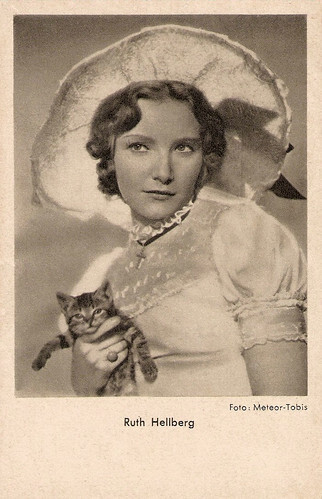
German postcard by Das Programm von Heute / Ross Verlag. Photo: Meteor / Tobis. Ruth Hellberg in Yvette (Wolfgang Liebeneiner, 1938). During the 1930s and 1940s German actress Ruth Hellberg (1906-2001) appeared in several films of her husband Wolfgang Liebeneiner. After their divorce, she focused on her stage career.
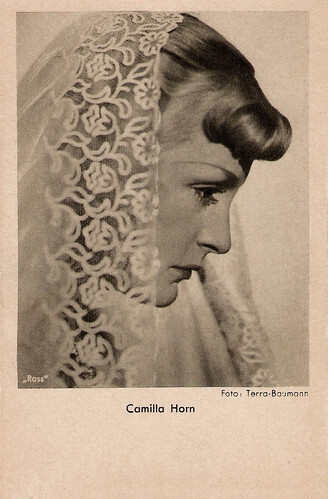
German postcard by Das Programm von Heute / Ross Verlag. Photo: Terra-Baumann. Ethereally blonde Camilla Horn (1903-1996) was a German dancer and film star. Her breakthrough role was Gretchen in Friedrich Wilhelm Murnau's silent film classic Faust (1926). She also starred in some Hollywood films of the late 1920s and a few British and Italian productions.
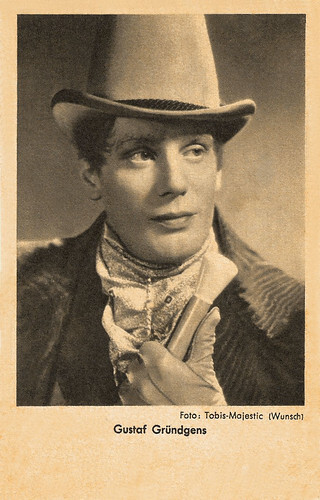
German postcard by Das Programm von Heute / Ross Verlag. Photo: Tobis-Majestic (Wunsch). Gustaf Gründgens as Debureau in Tanz auf dem Vulkan/Dance on the volcano (Hans Steinhoff, 1938). Gustaf Gründgens (1899-1963) was one of the most famous and influential but also controversial German actors and artistic directors of the twentieth century. He launched himself as a comet during the Weimar Republic. His most beautiful role was Mephisto, the devil in Goethe's 'Faust'. With that role he celebrated triumphs. His best-known film role was the criminal 'Der Schränker' (The Safecracker), the chief judge of Peter Lorre's character in Fritz Lang's M – Eine Stadt sucht einen Mörder/M (1931). After 1933, Gründgens became the stage favourite of the Nazi top. Although Reich Propaganda Minister Joseph Goebbels hated the homosexual Gründgens to the bone, Field Marshal Hermann Göring protected him personally. In 1946, Gründgens again acquired an important position in the German theatre. He triumphed in Berlin, amidst returned exiles and survivors from the concentration camps and was again respected as an actor.
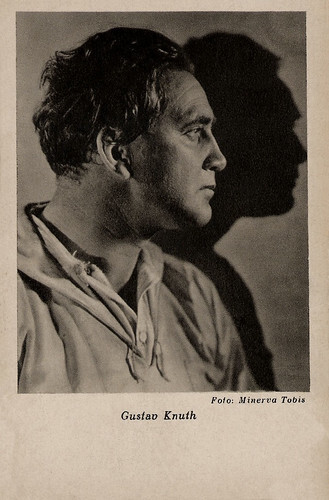
German postcard by Das Programm von Heute, Berlin. Photo: Minerva / Tobis. Gustav Knuth in Heimweh/Homesick (Jürgen von Alten, 1937). Gustav Knuth (1901-1987) was a German actor who played folksy, good-natured characters in numerous films and TV series. After the Second World War, he took Swiss citizenship. He was a successful stage actor and starred in more than 120 films between 1935 and 1982. During the 1960s and 1970s, he was one of the most distinguished German TV actors.
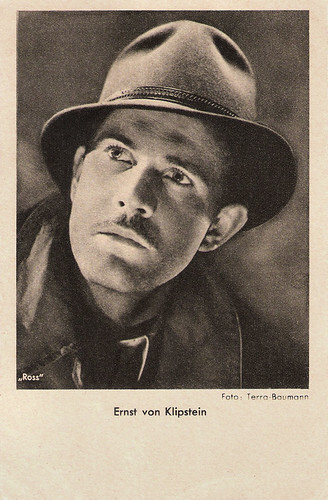
German postcard by Das Programm von Heute / Ross Verlag. Photo: Baumann / Terra. Ernst von Klipstein (1908-1993) was a rangy, masculine German supporting actor and occasional lead. He performed on stage from 1925. Von Klipstein became a prominent actor during the Nazi era, mainly for Universum AG (Ufa) where he was often cast as an officer, chief engineer or other authority figure. After the war, he was much in demand for synchronising work, radio plays and as a guest star on TV.
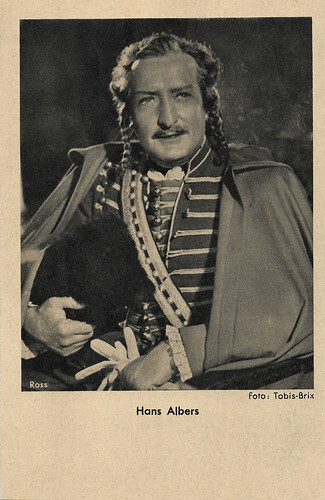
German postcard by Das Programm von Heute / Ross Verlag. Photo: Tobis / Brix. Hans Albers in Trenck, der Pandur/Trenck, Officer of the Pandurs (Herbert Selpin, 1940). Jovial, pleasantly plump Hans Albers (1891-1960) was a superstar of German cinema between 1930 and 1945. He was also one of the most popular German singers of the twentieth century. His song 'Auf der Reeperbahn nachts um halb eins' (On the Reeperbahn at half past midnight) is the unofficial anthem of Hamburg’s neighbourhood of St. Pauli, famous for its brothels, music and nightclubs.
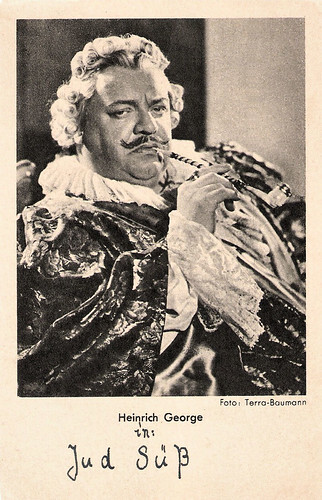
German postcard by Das Programm von Heute / Ross Verlag. Photo: Baumann/Terra. Heinrich George in Jud Süss/Jew Süss (Veit Harlan, 1940). Huge, bear-like Heinrich George (1893–1946) was a famous German stage and film actor of the Weimar Republic. He starred in such classics as Metropolis (1926) and Berlin Alexanderplatz (1931). Under the Nazi regime, the former Communist was initially not permitted to work but later appeared in notorious Propaganda films such as Jud Süss (1940). After the war, he died of starvation in a Soviet concentration camp.
Sources: Thoralf Haß (Käthe von Nagy – German), Troy Kirk (The Movie Card Website), and Ross Postcards.
With thanks to Jean Ritsema and Ivo Blom! Our Ross Verlag Tribute will be continued next week and please, remember to check out the Ross Verlag Movie Stars Postcards website.

German postcard by Das Programm von Heute / Ross Verlag. Photo: Atelier Schenker, Berlin. Hungarian-born singer and actress Márta Eggerth (1912-2013) maintained a global career for over 70 years. She was the popular and talented star of 30 German and Austrian operetta films of the 1930s. Many of the 20th century's most famous operetta composers, including Franz Lehár, Fritz Kreisler, Robert Stolz, Oscar Straus, and Paul Abraham, composed works especially for her. After the rise of the Nazis, she continued her career with her partner Jan Kiepura in the US.

German postcard by Das Programm von Heute / Ross Verlag. Photo: Vogelsang, Berlin. Popular Austrian folk actress Lucie Englisch (1902-1965) played both leading and supporting roles on stage, in films, and on television. As the native girl with a loose tongue, she was seen in countless comedies, in both leading and supporting parts.

German postcard by Das Programm von Heute / Ross Verlag, Berlin. Photo: Böhm-Willott, Berlin. Collection: Miss Mertens. Austrian actress Gerda Maurus (1903-1968) was a star of the silent screen. With her protruded cheekbones and her forceful look, she bewitched many men, including her director Fritz Lang and Nazi Minister Josef Goebbels.

German postcard by Das Programm von Heute / Ross Verlag. Photo: Tobis. Sexy German dancer and film actress La Jana (1905-1940) was the most popular showgirl in Berlin in the 1930s. She appeared in 25 European films, often dancing in exotic costumes. In 1940, she suddenly died of pneumonia and pleurisy.

German postcard by Das Programm von Heute / Ross Verlag. Photo: Slavia - Tobis Europa. Adolf Wohlbrück in Port Arthur (Nicolas Farkas, 1936). Dark and handsome Adolf Wohlbrück (1896-1967) a.k.a. Anton Walbrook was a distinguished Austrian actor who starred in early German sound films as Walzerkrieg (1933) and Viktor und Viktoria (1933). After the rise of Hitler, he settled in Great Britain where he appeared in such film classics as The Life and Death of Colonel Blimp (1943) and The Red Shoes (1948). He also played the ringmaster in La Ronde (1950).
The Program for Today
A 'Das Programm von Heute', Zeitschrift für Film und Theater (The Program for Today. Newspaper for Film and Theatre) was 6 pages long (2×3 (contiguous) pages), in the format of 20.5 x 25 cm (8 x 10 inch). The programs were numbered and went far above 500.
In addition to general information about each film (director, screenplay, music, sound, editing, actors, etc.), the content of the film was described in text and numerous pictures.
The series focused on German and Austrian films but also included French, Italian and American films and Hollywood stars.
The programs were published by ‘Zeitschrift für Film und Theater GmbH’ in Frankfurt/M. Sometimes Berlin or Stuttgart is given as the location of the publisher.
The programs and cards were issued between 1934 and 1939. Eventually, the programs were reduced in size, and instead of including a postcard with each edition, a facsimile of one was printed right on the cover.

German postcard by Das Programm von Heute / Ross Verlag. Photo: Hammer-Tonfilm. Gaby Morlay in Le scandale/The Scandal (Marcel L'Herbier, 1934) with Mircha and Gaby Triquet. Gaby Morlay (1893-1964) was a French actress with a long-standing career, playing in over 100 films. She compensated her small size (1.53 m.) with passion and enthusiasm.

German postcard by Das Programm von Heute / Ross Verlag. Photo: Hammer-Tonfilm. Blonde Austrian actress and singer Gretl Theimer (1911-1972) arrived in the German cinema with the sound film and had an impressive career in the 1930s.

German postcard by Das Programm von Heute / Ross Verlag. Photo: Minerva-Europa. Luise Ullrich in Viktoria/The Love of a Lady (Carl Hoffmann, 1935). Austrian actress Luise Ullrich (1910-1985) starred in many German films of the 1930s, 1940s and 1950s. No German star played self-sacrificing womanhood better than the blond actress and her film Annelie (1941), became the main morale-booster of World War II Germany.

German postcard by Das Programm von Heute / Ross Verlag. Photo: Metropolitan / Bavaria. Rolf Wanka in Rote Rosen - blaue Adria/Red Roses - Blue Adriatic (Jan Sviták, 1938). Austrian actor Rolf Wanka (1901-1982) was a handsome, suave star of the European cinema of the 1930s and the 1950s. He often played supporting parts as a well-dressed, dignified gentleman, and appeared in more than 100 films and television shows between 1931 and 1976.

German postcard by Das Programm von Heute, Berlin / Ross Verlag. Photo: Bavaria. Geraldine Katt in Die Stimme des Herzens/The Voice of the Heart (Karlheinz Martin, 1937). Geraldine Katt (1920-1995) was an Austrian actress, who was seen in romantic comedies and melodramas of the 1930s and 1940s. She appeared in more than ten films from 1936 to 1951.

German postcard by Das Programm von Heute, Berlin / Ross Verlag. Photo: Metro Goldwyn Mayer. Wallace Beery in Viva Villa! (Jack Conway, 1934). American actor Wallace Beery (1885-1949) is best known for his portrayal of Bill in Min and Bill opposite Marie Dressler, as Long John Silver in Treasure Island, as Pancho Villa in Viva Villa!, and his titular role in The Champ, for which he won the Academy Award for Best Actor. Beery appeared in some 250 films in a 36-year career. He was the brother of actor Noah Beery, Sr. and uncle of actor Noah Beery, Jr.

German postcard by Das Programm von Heute / Ross Verlag. Photo: Fox-Film. Clark Gable in Call of the Wild (William A. Wellman, 1935). With his natural charm and knowing smile, Clark Gable (1901-1959) was 'The King of Hollywood' during the 1930s. He often portrayed down-to-earth, bravado characters with a carefree attitude, and was seen as the epitome of masculinity. Gable won an Academy Award for Best Actor for It Happened One Night (1934), and was nominated for his leading role in Mutiny on the Bounty (1935) and for his best-known role, Rhett Butler in Gone with the Wind (1939).

German postcard by Das Programm von Heute, Berlin / Ross Verlag. Photo: Badal / Terra. Pola Negri in Der Weg nach Shanghai/Moskou Shanghai (Paul Wegener, 1936). Polish film actress Pola Negri (1897-1987) achieved notoriety as a femme fatale in German and American silent films between the 1910s and 1930s. In the late 1910s and the 1920s, she achieved notoriety as a femme fatale in silent films in Poland, Berlin, and Hollywood. Negri was an overnight sensation in Ernst Lubitsch's Madame du Barry/Passion (1919). Her vamp roles were so popular that she was a direct rival of Theda Bara, and lived in a Hollywood palace, modelled after the White House.

German postcard by Das Programm von Heute, Berlin / Ross Verlag. Photo: Märkische / Panorama / Schneider. Ingrid Bergman in Die 4 Gesellen/The Four Companions (Carl Froelich, 1938). Ingrid Bergman (1915-1982) was ‘Sweden's illustrious gift to Hollywood’. In the 1940s the fresh and naturally beautiful actress won three times the Oscar, twice the Emmy, and once the Tony Award for Best Actress. Little known is that before she went to Hollywood she already had a European film career.

German postcard by Das Programm von Heute / Ross Verlag. Photo: Terra-Sandau. Georg Alexander (1888-1945) was a German actor, director and producer. He belongs to the busiest actors and his career continued smoothly till his death.
Cheaper paper
The Das Programm Von Heute postcards were made of cheaper paper than for example the Ross Verlag postcards. The cards were given away free as an insert in 'Das Programm von Heute. Zeitschrift fur Film und Theater'. The card size was 9 x 14 cm (3.5 x 5.5 inch). Over 730 unnumbered cards are known, with up to 8 different fronts and backs. The Ross Postcards website offers an overview.
The postcards were in black and white or in single-color tints. There were 5 different single-colour shades: grey-black, blue-black, brown, violet-brown and dark green. The cards were printed with "Ross Verlag" in many different styles, until the name disappeared off of the cards altogether, probably after the company was taken over by the National Socialists.
Most stars in the series are German or Austrian, but the likes of Greta Garbo , Clark Gable , Jean Harlow , Wallace Beery and Shirley Temple also get a look in, often with multiple cards. There were also French and Italian stars pictured. The young pre-Hollywood Ingrid Bergman was pictured on one of the cards when she starred in the German film Die 4 Gesellen/The Four Companions (Carl Froelich, 1938).
There were also postcard albums designed solely for storing these cards. Issued over 6 years, there were many different variations of the album. The cover was either silver, beige, or grey, with album pages yellow-white or dark grey. The album title was always in blue. Backs with either "Das Programm von Heute, Zeitschrift für Film und Theater G.m.b.H., Berlin S.W. 11, Dessauerstr. 7" or "Das Programm von Heute für Film und Theater G.m.b.H. Stuttgart".
All were slot-in albums with either 96 or (much rarer) 104 spaces. Albums with 104 spaces came in the following variations: The cover was either silver or beige, with album pages yellow-white or dark grey. The album title was either in blue or red. Backs with either "Das Programm von Heute, Zeitschrift für Film und Theater G.m.b.H. Stuttgart" or "Das Programm von Heute für Film und Theater G.m.b.H. Stuttgart". Because pages were blank, any postcard could be slotted in anywhere. You often find albums with postcards from other sources, such as Ross Verlag or Eidelstedter Margarine (Eidelsan).

German postcard by Das Programm von Heute / Ross Verlag. Photo: Tobis. Frits van Dongen in Der Tiger von Eschnapur/Das Indische Grabmal (Richard Eichberg, 1938). With this film, Van Dongen had his breakthrough as Maharaja Chandra. Handsome, deep-voiced leading man Frits van Dongen (1901-1975) was one of the first Dutch Hollywood stars. He started his film career in the Netherlands, and in the mid-1930s he became a matinee idol in the German cinema. From 1940 on, he worked in Hollywood, billed as Philip Dorn. A freak accident caused him to retire in 1955.

German postcard by Das Programm von Heute / Ross Verlag. Photo: Bavaria/Ross Verlag. German stage and film actress Heli Finkenzeller (1914-1991) had her greatest successes in popular Ufa comedies of the 1930s and 1940s. After the war, she often played mother roles.

German postcard by Das Programm von Heute / Ross Verlag. Photo: Manassé-Ricoll. Austrian child actress Traudl Stark (1930-2021) was the Shirley Temple of the German cinema. Between 1935 and 1940, she made a dozen popular films in Austria. After the war, she married, left the film industry, and moved to the USA. Gertraud 'Trudy' South passed away in Tampa, Florida, where she resided since 1973.

German postcard by Das Programm von Heute / Ross Verlag. Photo: Meteor / Tobis. Ruth Hellberg in Yvette (Wolfgang Liebeneiner, 1938). During the 1930s and 1940s German actress Ruth Hellberg (1906-2001) appeared in several films of her husband Wolfgang Liebeneiner. After their divorce, she focused on her stage career.

German postcard by Das Programm von Heute / Ross Verlag. Photo: Terra-Baumann. Ethereally blonde Camilla Horn (1903-1996) was a German dancer and film star. Her breakthrough role was Gretchen in Friedrich Wilhelm Murnau's silent film classic Faust (1926). She also starred in some Hollywood films of the late 1920s and a few British and Italian productions.

German postcard by Das Programm von Heute / Ross Verlag. Photo: Tobis-Majestic (Wunsch). Gustaf Gründgens as Debureau in Tanz auf dem Vulkan/Dance on the volcano (Hans Steinhoff, 1938). Gustaf Gründgens (1899-1963) was one of the most famous and influential but also controversial German actors and artistic directors of the twentieth century. He launched himself as a comet during the Weimar Republic. His most beautiful role was Mephisto, the devil in Goethe's 'Faust'. With that role he celebrated triumphs. His best-known film role was the criminal 'Der Schränker' (The Safecracker), the chief judge of Peter Lorre's character in Fritz Lang's M – Eine Stadt sucht einen Mörder/M (1931). After 1933, Gründgens became the stage favourite of the Nazi top. Although Reich Propaganda Minister Joseph Goebbels hated the homosexual Gründgens to the bone, Field Marshal Hermann Göring protected him personally. In 1946, Gründgens again acquired an important position in the German theatre. He triumphed in Berlin, amidst returned exiles and survivors from the concentration camps and was again respected as an actor.

German postcard by Das Programm von Heute, Berlin. Photo: Minerva / Tobis. Gustav Knuth in Heimweh/Homesick (Jürgen von Alten, 1937). Gustav Knuth (1901-1987) was a German actor who played folksy, good-natured characters in numerous films and TV series. After the Second World War, he took Swiss citizenship. He was a successful stage actor and starred in more than 120 films between 1935 and 1982. During the 1960s and 1970s, he was one of the most distinguished German TV actors.

German postcard by Das Programm von Heute / Ross Verlag. Photo: Baumann / Terra. Ernst von Klipstein (1908-1993) was a rangy, masculine German supporting actor and occasional lead. He performed on stage from 1925. Von Klipstein became a prominent actor during the Nazi era, mainly for Universum AG (Ufa) where he was often cast as an officer, chief engineer or other authority figure. After the war, he was much in demand for synchronising work, radio plays and as a guest star on TV.

German postcard by Das Programm von Heute / Ross Verlag. Photo: Tobis / Brix. Hans Albers in Trenck, der Pandur/Trenck, Officer of the Pandurs (Herbert Selpin, 1940). Jovial, pleasantly plump Hans Albers (1891-1960) was a superstar of German cinema between 1930 and 1945. He was also one of the most popular German singers of the twentieth century. His song 'Auf der Reeperbahn nachts um halb eins' (On the Reeperbahn at half past midnight) is the unofficial anthem of Hamburg’s neighbourhood of St. Pauli, famous for its brothels, music and nightclubs.

German postcard by Das Programm von Heute / Ross Verlag. Photo: Baumann/Terra. Heinrich George in Jud Süss/Jew Süss (Veit Harlan, 1940). Huge, bear-like Heinrich George (1893–1946) was a famous German stage and film actor of the Weimar Republic. He starred in such classics as Metropolis (1926) and Berlin Alexanderplatz (1931). Under the Nazi regime, the former Communist was initially not permitted to work but later appeared in notorious Propaganda films such as Jud Süss (1940). After the war, he died of starvation in a Soviet concentration camp.
Sources: Thoralf Haß (Käthe von Nagy – German), Troy Kirk (The Movie Card Website), and Ross Postcards.
With thanks to Jean Ritsema and Ivo Blom! Our Ross Verlag Tribute will be continued next week and please, remember to check out the Ross Verlag Movie Stars Postcards website.
Published on November 12, 2024 22:00
November 11, 2024
Milla Jovovich
Milla Jovovich (1975) is an American actress, supermodel and musician of Serbian and Russian descent. She is best known for her roles in Luc Besson’s The Fifth Element (1997) and The Messenger: The Story of Joan of Arc (1999), and especially for the action horror film franchise Resident Evil (2002-2016).
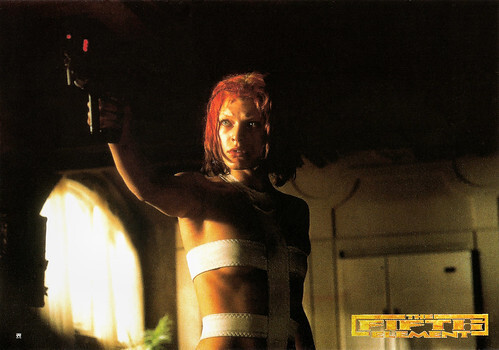
French postcard by Sonis, no. C. 851. Photo: Gaumont. Milla Jovovich in The Fifth Element (Luc Besson, 1997).
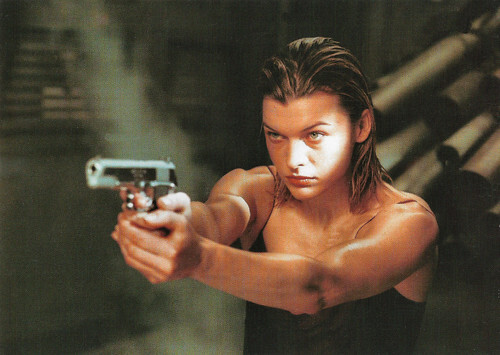
German freecard by Edgar Medien A.G., no. 5.533. Photo: Constantin Film. Milla Jovovich in Resident Evil (Paul W.S. Anderson, 2002).
Richard Avedon
Milla Jovovich was born Milica Bogdanovna Yovovich in 1975 in Kyiv, in what was then the Ukrainian Soviet Socialist Republic and now Ukraine. She is the daughter of Bogdan Jovović, a Serbian doctor and Galina Loginova Jovović, a Russian actress. When Jovovich was five years old, her family emigrated from the Soviet Union to London in 1981 for political reasons. They then moved to the United States and lived in Sacramento, California, before moving to Los Angeles seven months later. A short time later, her parents separated. They eventually divorced, because her father was arrested and spent several years in prison.
In Los Angeles, her mother tried to get acting jobs but failed because of language barriers. She eventually resorted to cleaning houses to earn money. Milla’s mother supported her in her plans to become an actress, so Jovovich enrolled at a professional acting school in California in 1985. When she was 11, Jovovich was noticed by photographer Richard Avedon and left seventh grade to focus on modelling. In October 1987, she appeared on the cover of Italian fashion magazine Lei, photographed by Herb Ritts. This was the first of many covers in her career.
In 1988, she played her first professional role in the television film The Night Train to Kathmandu (Robert Wiemer, 1988) as Lily McLeod. In the same year, she had a small role as Samantha Delongpre in the erotic thriller Two Moon Junction (Zalman King, 1988) starring Sherilyn Fenn. When she was 15, Jovovich had a leading role in the romantic South Seas adventure Return to the Blue Lagoon (William A. Graham, 1991), a sequel to The Blue Lagoon (Randal Kleiser,1980) starring Brooke Shields. The role was controversial as, like Shields, Jovovich appeared nude in the film. The film was not financially successful, grossing just $2.8 million on an $11 million budget. Like its predecessor, it received negative reviews from critics.
In 1992, she starred alongside Christian Slater in the action comedy Kuffs (Bruce A. Evans, 1992) and landed a small role as Mildred Harris in the biopic Chaplin (Richard Attenborough, 1992) starring Robert Downey Jr. The following year, she starred in the cult film Dazed and Confused (Richard Linklater, 1993) as Michelle Burroughs, the girlfriend of Pickford (Shawn Andrews). During filming, Andrews also became her boyfriend in real life. The 16-year-old Jovovich married him, but the marriage was annulled less than two months later at her mother's request.
Strongly featured in promotions for Dazed and Confused, Jovovich was upset to find her role much reduced in the released film. Milla decided to take a break from acting for the next 3 years to focus on her music career. Jovovich became a US citizen in 1994. In the same year, she was signed to EMI Records. She released her first album ‘The Divine Comedy’ under this label, which she had already written at the age of 15 and recorded at 16. It received some good reviews but fell short of expectations. A concert in Austin, Texas, on 16 December 1994 - the day before her 19th birthday - was recorded live.
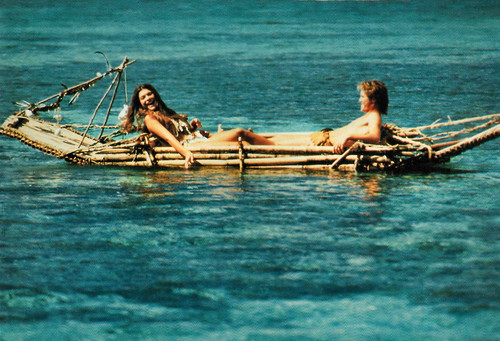
French postcard. Photo: Columbia Pictures. Milla Jovovich and Brian Krause in Return to the Blue Lagoon (William A. Graham, 1991).
An alien called Leeloo
Milla Jovovich made her breakthrough in the cinema as Leeloo in the French Science Fiction film Le cinquième élément/The Fifth Element (Luc Besson, 1997) alongside Bruce Willis, Gary Oldman and Chris Tucker. For the role, Besson and Jovovich co-developed an alien language that had only 400 words. Besson and Jovovich held conversations and wrote letters to each other in the language as practice. By the end of filming, they were able to have full conversations in this language.
Jovovich wore a costume that became known as the ‘ACE-bandage’ costume. It consisted of a revealing full-body suit made of medical bandages and was designed by Jean Paul Gaultier. At the time, Le cinquième élément/The Fifth Element was the most expensive film ever produced outside of Hollywood The film was the opening film at the Cannes Film Festival and grossed a total of US$263 million, more than three times its budget of $80 million. Jovovich was nominated for several awards including the MTV Movie Award for Best Fight Scene but also a Golden Raspberry. In an interview in 2003, she revealed that Leeloo was her favourite role.
In 1997 she married Luc Besson. She played abused prostitute Dakota Burns in Spike Lee's drama He’s Got Game (1998) opposite Denzel Washington. Besson directed her as the French national heroine and saint in Jeanne d'Arc/The Messenger: The Story of Joan of Arc (Luc Besson, 1999), but later that year the couple divorced. Although she received good reviews for the film overall, she was also nominated for a Golden Raspberry for her role.
Jovovich played the troubled Eloise opposite Mel Gibson in Wim Wenders' thriller The Million Dollar Hotel (Wim Wenders, 2000), based on a screenplay by Bono of the band U2 and Nicholas Klein. Jovovich also sang some of the songs on the film's soundtrack. She then played the bar owner Lucia in the British Western The Empire and the Glory (Michael Winterbottom, 2000) and the diabolical Katinka in the comedy Zoolander (Ben Stiller, 2001). This satire on the fashion industry was both a critical and box-office success.
Jovovich had a huge success as the star of Resident Evil (Paul W.S. Anderson, 2002), based on the popular video game series. She played Alice who fights against zombies and the diabolical Umbrella Corporation. She took on the role because she and her brother were fans of the video game series. She did most stunts herself and trained in karate, kickboxing and other martial arts for the film. Resident Evil grossed 102 million US dollars.
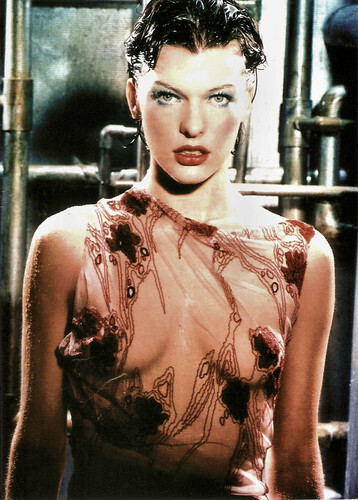
Vintage postcard.
The highest-paid supermodel in the world
Since 2002, Milla Jovovich has been with director Paul W.S. Anderson, who she met on the film set of Resident Evil. They got engaged in 2003 and married in 2009. They have three daughters Osian Lark Elliot Jovovich-Anderson, Dashiel Edan Anderson and Ever Anderson. Milla appeared in ad campaigns for Chanel, Versace, Emporio Armani, Donna Karen, and DKNY. In 2004, she made $10.4 million, becoming the highest-paid supermodel in the world.
Modelling and advertising work gave her the financial security she needed to make critically acclaimed films such as the crime thriller No Good Deed (Bob Rafelson, 2002) with Samuel L. Jackson, and the romantic comedy-drama Dummy (Greg Pritikin, 2003) with Adrien Brody.
She returned as Alice in the sequel Resident Evil: Apocalypse (Alexander Witt, 2004). It is set directly after the events of the first film, where Alice escaped from an underground facility overrun by zombies. She now bands together with other survivors to escape the zombie outbreak. The sequel received worse reviews than the first part but had greater commercial success. Next, she appeared in the Science Fiction film Ultraviolet (Kurt Wimmer, 2006) which performed poorly at the box office.
The third instalment of the Resident Evil series, Resident Evil: Extinction (Russell Mulcahy, 2007) grossed $24 million on its opening weekend in the United States and $147 million worldwide against a $45 million budget. She then played Lucetta, the wife of an imprisoned arsonist (Edward Norton), in the psychological thriller Stone (John Curran, 2010) alongside Robert De Niro . She returned as Alice in the fourth instalment of the Resident Evil saga. Resident Evil: Afterlife (Paul W. S. Anderson, 2010), produced by her husband Paul W. S. Anderson. It was the first film in the series to be shot entirely in 3D. Jovovich starred as Milady de Winter in The Three Musketeers (Paul W. S. Anderson, 2011), which was also produced by her husband.
Jovovich appeared as a Ukrainian con artist in Famke Janssen 's directorial debut film Bringing Up Bobby (2011) and played a leading role in the Russian relationship comedy Vykrutasy/Lucky Trouble (Levan Gabriadze, 2011). This was followed by Resident Evil: Retribution (Paul W.S. Anderson, 2012), another instalment in the Resident Evil saga. Since 2014, she appeared in at least one film every year. Jovovich once again played the lead role in the sixth and final instalment of the Resident Evil series Resident Evil: Retribution (2016). The final chapter was the highest-grossing film in the franchise, earning over US$312 million worldwide. Time Out : "While the franchise has slackened into dependably dumb post-apocalyptic thrills, star Milla Jovovich has only gotten better, seasoning her long-legged athleticism with a commanding stare". Lately, Milla Jovovich could be seen in the American Science Fiction thriller Breathe (Stefon Bristol, 2024) also starring Jennifer Hudson.
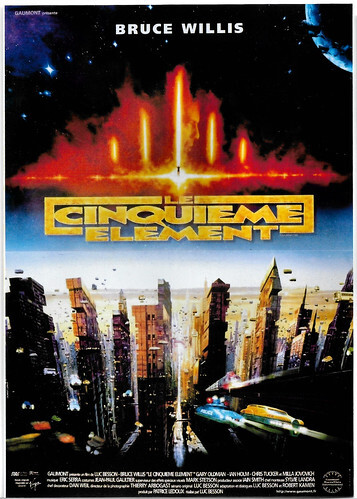
English postcard by Cinema. French poster by Gaumont for Le cinquième élément/The Fifth Element (Luc Besson, 1997) with Bruce Willis and Milla Jovovich.
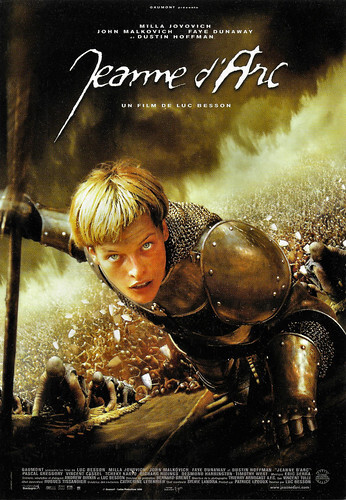
French postcard by Sonis, no. C. 1053. French poster by Gaumont / Leeloo Productions for Jeanne d'Arc/The Messenger: The Story of Joan of Arc (Luc Besson, 1999) with Milla Jovovich.
Sources: Wikipedia (Dutch, German and English) and .

French postcard by Sonis, no. C. 851. Photo: Gaumont. Milla Jovovich in The Fifth Element (Luc Besson, 1997).

German freecard by Edgar Medien A.G., no. 5.533. Photo: Constantin Film. Milla Jovovich in Resident Evil (Paul W.S. Anderson, 2002).
Richard Avedon
Milla Jovovich was born Milica Bogdanovna Yovovich in 1975 in Kyiv, in what was then the Ukrainian Soviet Socialist Republic and now Ukraine. She is the daughter of Bogdan Jovović, a Serbian doctor and Galina Loginova Jovović, a Russian actress. When Jovovich was five years old, her family emigrated from the Soviet Union to London in 1981 for political reasons. They then moved to the United States and lived in Sacramento, California, before moving to Los Angeles seven months later. A short time later, her parents separated. They eventually divorced, because her father was arrested and spent several years in prison.
In Los Angeles, her mother tried to get acting jobs but failed because of language barriers. She eventually resorted to cleaning houses to earn money. Milla’s mother supported her in her plans to become an actress, so Jovovich enrolled at a professional acting school in California in 1985. When she was 11, Jovovich was noticed by photographer Richard Avedon and left seventh grade to focus on modelling. In October 1987, she appeared on the cover of Italian fashion magazine Lei, photographed by Herb Ritts. This was the first of many covers in her career.
In 1988, she played her first professional role in the television film The Night Train to Kathmandu (Robert Wiemer, 1988) as Lily McLeod. In the same year, she had a small role as Samantha Delongpre in the erotic thriller Two Moon Junction (Zalman King, 1988) starring Sherilyn Fenn. When she was 15, Jovovich had a leading role in the romantic South Seas adventure Return to the Blue Lagoon (William A. Graham, 1991), a sequel to The Blue Lagoon (Randal Kleiser,1980) starring Brooke Shields. The role was controversial as, like Shields, Jovovich appeared nude in the film. The film was not financially successful, grossing just $2.8 million on an $11 million budget. Like its predecessor, it received negative reviews from critics.
In 1992, she starred alongside Christian Slater in the action comedy Kuffs (Bruce A. Evans, 1992) and landed a small role as Mildred Harris in the biopic Chaplin (Richard Attenborough, 1992) starring Robert Downey Jr. The following year, she starred in the cult film Dazed and Confused (Richard Linklater, 1993) as Michelle Burroughs, the girlfriend of Pickford (Shawn Andrews). During filming, Andrews also became her boyfriend in real life. The 16-year-old Jovovich married him, but the marriage was annulled less than two months later at her mother's request.
Strongly featured in promotions for Dazed and Confused, Jovovich was upset to find her role much reduced in the released film. Milla decided to take a break from acting for the next 3 years to focus on her music career. Jovovich became a US citizen in 1994. In the same year, she was signed to EMI Records. She released her first album ‘The Divine Comedy’ under this label, which she had already written at the age of 15 and recorded at 16. It received some good reviews but fell short of expectations. A concert in Austin, Texas, on 16 December 1994 - the day before her 19th birthday - was recorded live.

French postcard. Photo: Columbia Pictures. Milla Jovovich and Brian Krause in Return to the Blue Lagoon (William A. Graham, 1991).
An alien called Leeloo
Milla Jovovich made her breakthrough in the cinema as Leeloo in the French Science Fiction film Le cinquième élément/The Fifth Element (Luc Besson, 1997) alongside Bruce Willis, Gary Oldman and Chris Tucker. For the role, Besson and Jovovich co-developed an alien language that had only 400 words. Besson and Jovovich held conversations and wrote letters to each other in the language as practice. By the end of filming, they were able to have full conversations in this language.
Jovovich wore a costume that became known as the ‘ACE-bandage’ costume. It consisted of a revealing full-body suit made of medical bandages and was designed by Jean Paul Gaultier. At the time, Le cinquième élément/The Fifth Element was the most expensive film ever produced outside of Hollywood The film was the opening film at the Cannes Film Festival and grossed a total of US$263 million, more than three times its budget of $80 million. Jovovich was nominated for several awards including the MTV Movie Award for Best Fight Scene but also a Golden Raspberry. In an interview in 2003, she revealed that Leeloo was her favourite role.
In 1997 she married Luc Besson. She played abused prostitute Dakota Burns in Spike Lee's drama He’s Got Game (1998) opposite Denzel Washington. Besson directed her as the French national heroine and saint in Jeanne d'Arc/The Messenger: The Story of Joan of Arc (Luc Besson, 1999), but later that year the couple divorced. Although she received good reviews for the film overall, she was also nominated for a Golden Raspberry for her role.
Jovovich played the troubled Eloise opposite Mel Gibson in Wim Wenders' thriller The Million Dollar Hotel (Wim Wenders, 2000), based on a screenplay by Bono of the band U2 and Nicholas Klein. Jovovich also sang some of the songs on the film's soundtrack. She then played the bar owner Lucia in the British Western The Empire and the Glory (Michael Winterbottom, 2000) and the diabolical Katinka in the comedy Zoolander (Ben Stiller, 2001). This satire on the fashion industry was both a critical and box-office success.
Jovovich had a huge success as the star of Resident Evil (Paul W.S. Anderson, 2002), based on the popular video game series. She played Alice who fights against zombies and the diabolical Umbrella Corporation. She took on the role because she and her brother were fans of the video game series. She did most stunts herself and trained in karate, kickboxing and other martial arts for the film. Resident Evil grossed 102 million US dollars.

Vintage postcard.
The highest-paid supermodel in the world
Since 2002, Milla Jovovich has been with director Paul W.S. Anderson, who she met on the film set of Resident Evil. They got engaged in 2003 and married in 2009. They have three daughters Osian Lark Elliot Jovovich-Anderson, Dashiel Edan Anderson and Ever Anderson. Milla appeared in ad campaigns for Chanel, Versace, Emporio Armani, Donna Karen, and DKNY. In 2004, she made $10.4 million, becoming the highest-paid supermodel in the world.
Modelling and advertising work gave her the financial security she needed to make critically acclaimed films such as the crime thriller No Good Deed (Bob Rafelson, 2002) with Samuel L. Jackson, and the romantic comedy-drama Dummy (Greg Pritikin, 2003) with Adrien Brody.
She returned as Alice in the sequel Resident Evil: Apocalypse (Alexander Witt, 2004). It is set directly after the events of the first film, where Alice escaped from an underground facility overrun by zombies. She now bands together with other survivors to escape the zombie outbreak. The sequel received worse reviews than the first part but had greater commercial success. Next, she appeared in the Science Fiction film Ultraviolet (Kurt Wimmer, 2006) which performed poorly at the box office.
The third instalment of the Resident Evil series, Resident Evil: Extinction (Russell Mulcahy, 2007) grossed $24 million on its opening weekend in the United States and $147 million worldwide against a $45 million budget. She then played Lucetta, the wife of an imprisoned arsonist (Edward Norton), in the psychological thriller Stone (John Curran, 2010) alongside Robert De Niro . She returned as Alice in the fourth instalment of the Resident Evil saga. Resident Evil: Afterlife (Paul W. S. Anderson, 2010), produced by her husband Paul W. S. Anderson. It was the first film in the series to be shot entirely in 3D. Jovovich starred as Milady de Winter in The Three Musketeers (Paul W. S. Anderson, 2011), which was also produced by her husband.
Jovovich appeared as a Ukrainian con artist in Famke Janssen 's directorial debut film Bringing Up Bobby (2011) and played a leading role in the Russian relationship comedy Vykrutasy/Lucky Trouble (Levan Gabriadze, 2011). This was followed by Resident Evil: Retribution (Paul W.S. Anderson, 2012), another instalment in the Resident Evil saga. Since 2014, she appeared in at least one film every year. Jovovich once again played the lead role in the sixth and final instalment of the Resident Evil series Resident Evil: Retribution (2016). The final chapter was the highest-grossing film in the franchise, earning over US$312 million worldwide. Time Out : "While the franchise has slackened into dependably dumb post-apocalyptic thrills, star Milla Jovovich has only gotten better, seasoning her long-legged athleticism with a commanding stare". Lately, Milla Jovovich could be seen in the American Science Fiction thriller Breathe (Stefon Bristol, 2024) also starring Jennifer Hudson.

English postcard by Cinema. French poster by Gaumont for Le cinquième élément/The Fifth Element (Luc Besson, 1997) with Bruce Willis and Milla Jovovich.

French postcard by Sonis, no. C. 1053. French poster by Gaumont / Leeloo Productions for Jeanne d'Arc/The Messenger: The Story of Joan of Arc (Luc Besson, 1999) with Milla Jovovich.
Sources: Wikipedia (Dutch, German and English) and .
Published on November 11, 2024 22:00
Paul van Yperen's Blog
- Paul van Yperen's profile
- 13 followers
Paul van Yperen isn't a Goodreads Author
(yet),
but they
do have a blog,
so here are some recent posts imported from
their feed.



